Lecture 22: Motivational Interviewing
1/89
There's no tags or description
Looks like no tags are added yet.
Name | Mastery | Learn | Test | Matching | Spaced |
|---|
No study sessions yet.
90 Terms
What are the three communication styles? (A Continuum of Styles)
The three styles are Directing, Following, and Guiding.
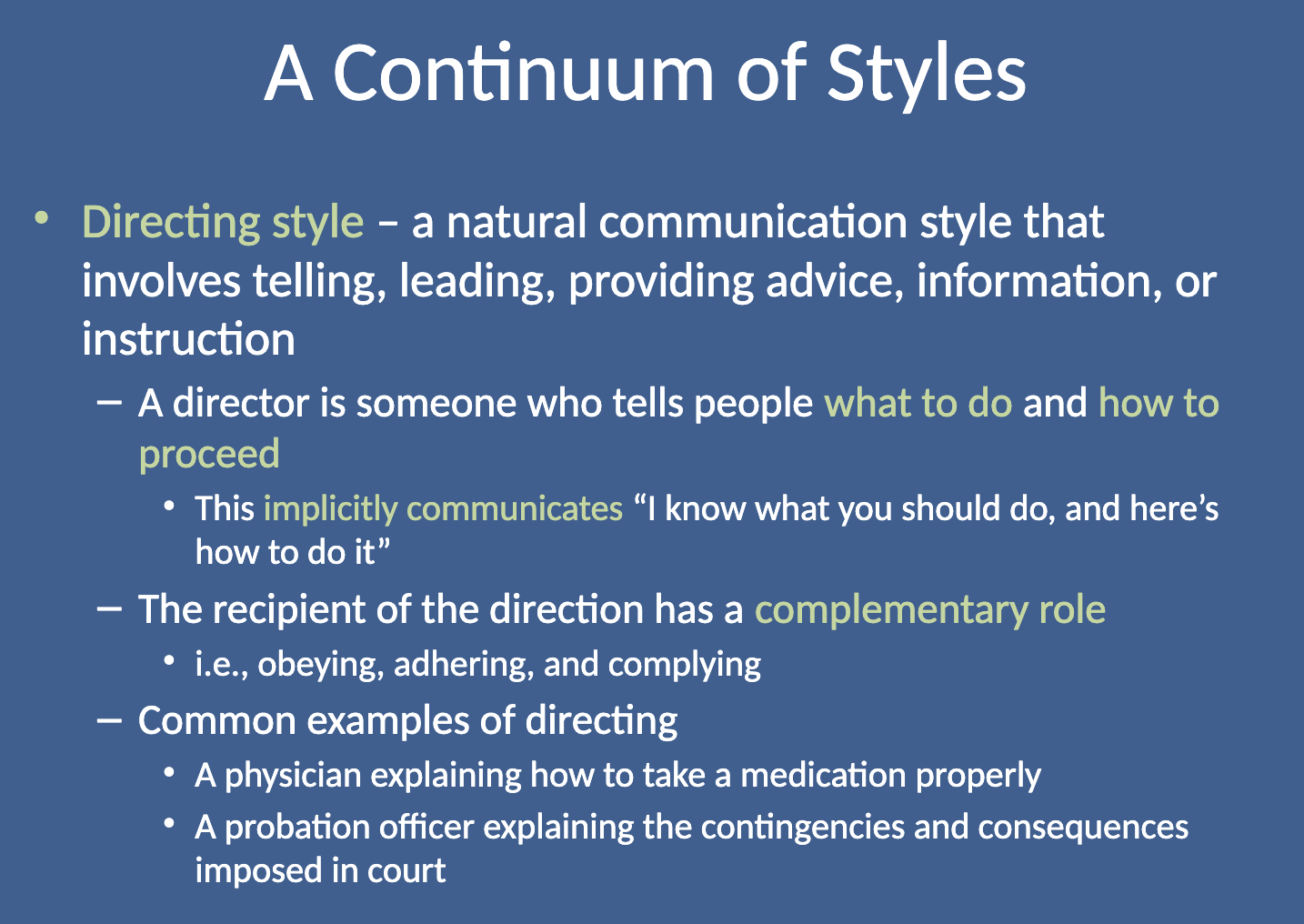
What is a directing style in communication? (A Continuum of Styles)
A directing style involves telling, leading, providing advice, information, or instruction. The director tells people what to do and how to proceed.
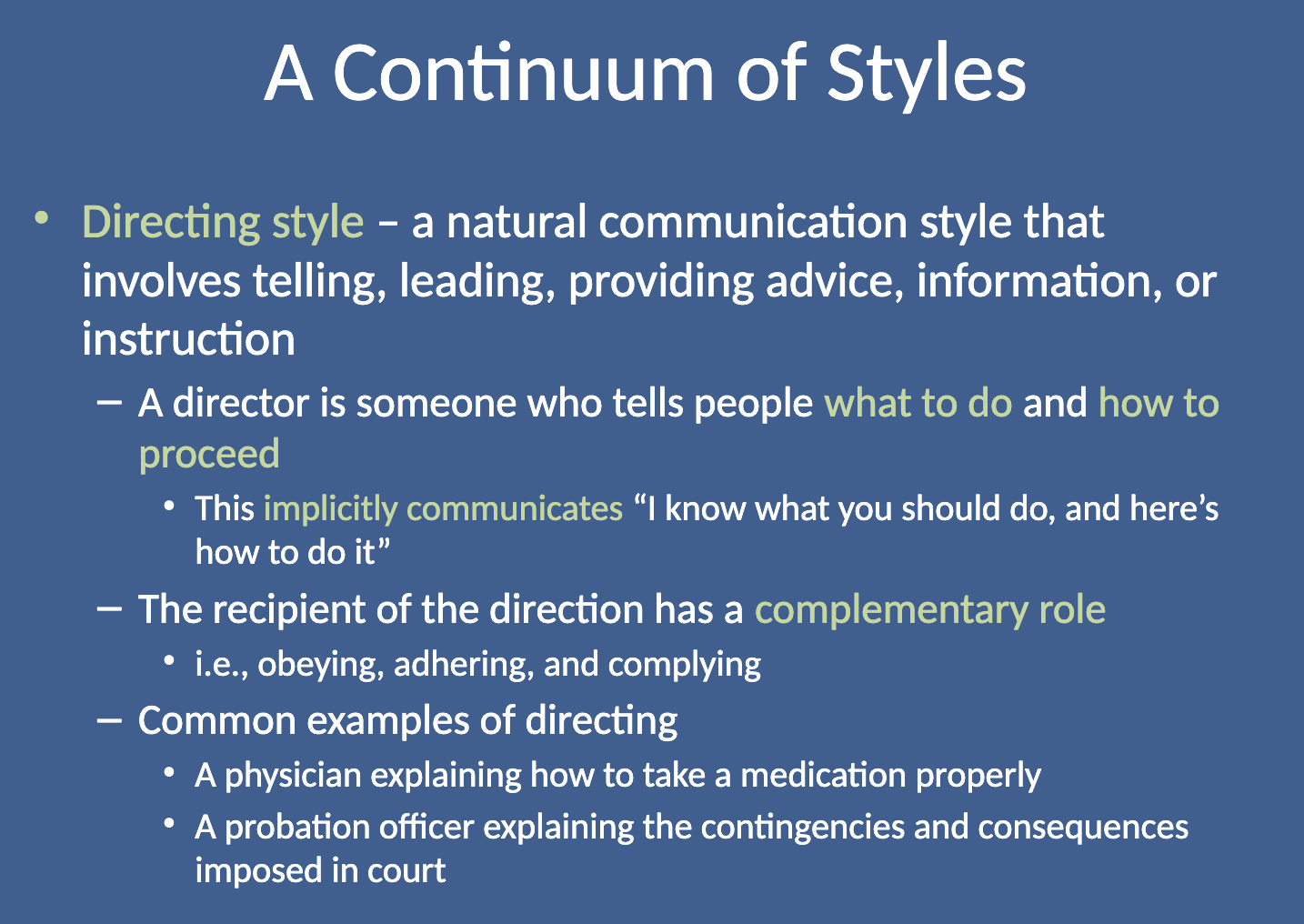
What is the role of a director in communication? (A Continuum of Styles)
A director tells people what to do and how to proceed, offering instructions and guidance.
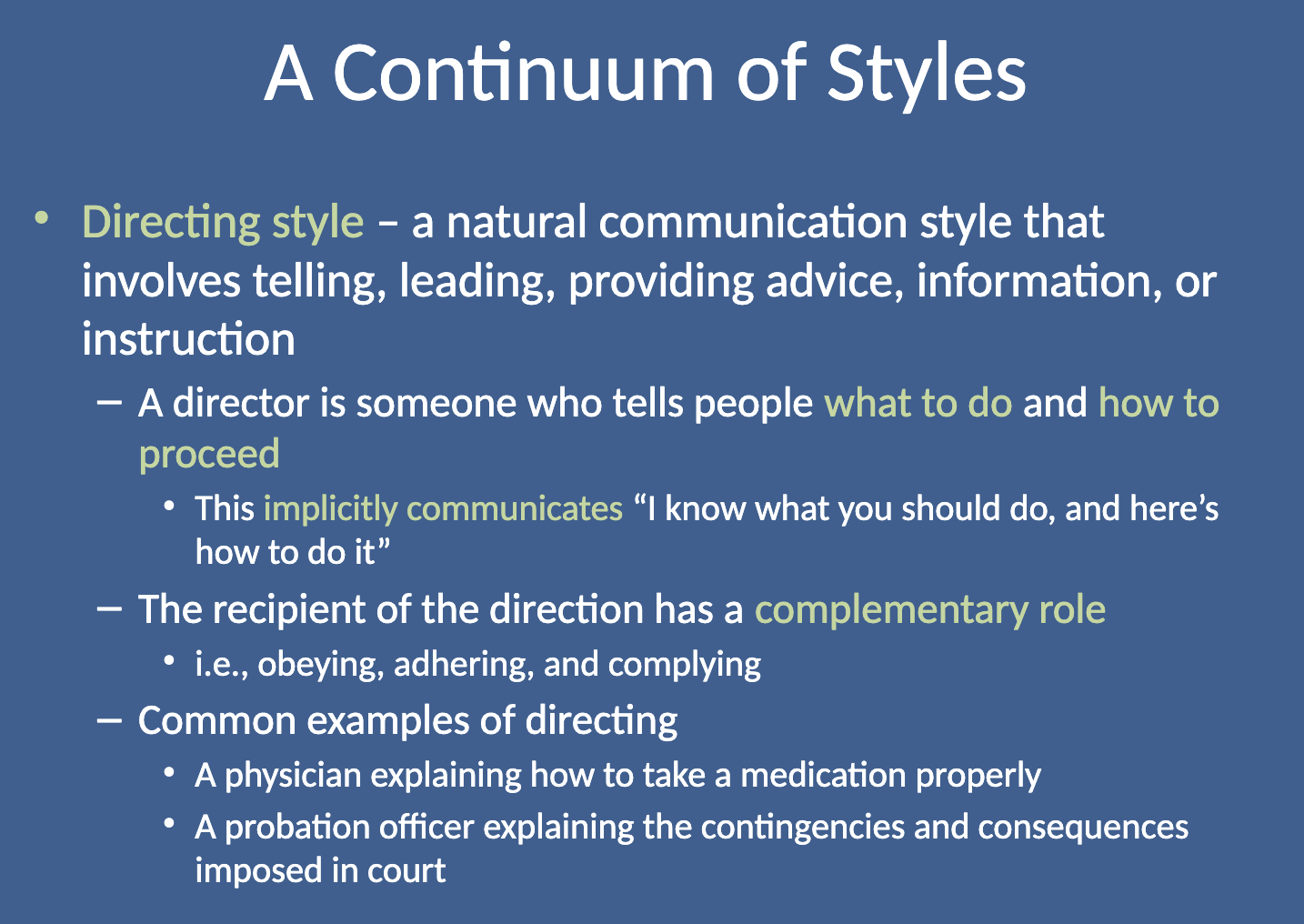
What does the directing style implicitly communicate? (A Continuum of Styles)
The directing style implicitly communicates “I know what you should do, and here’s how to do it.”
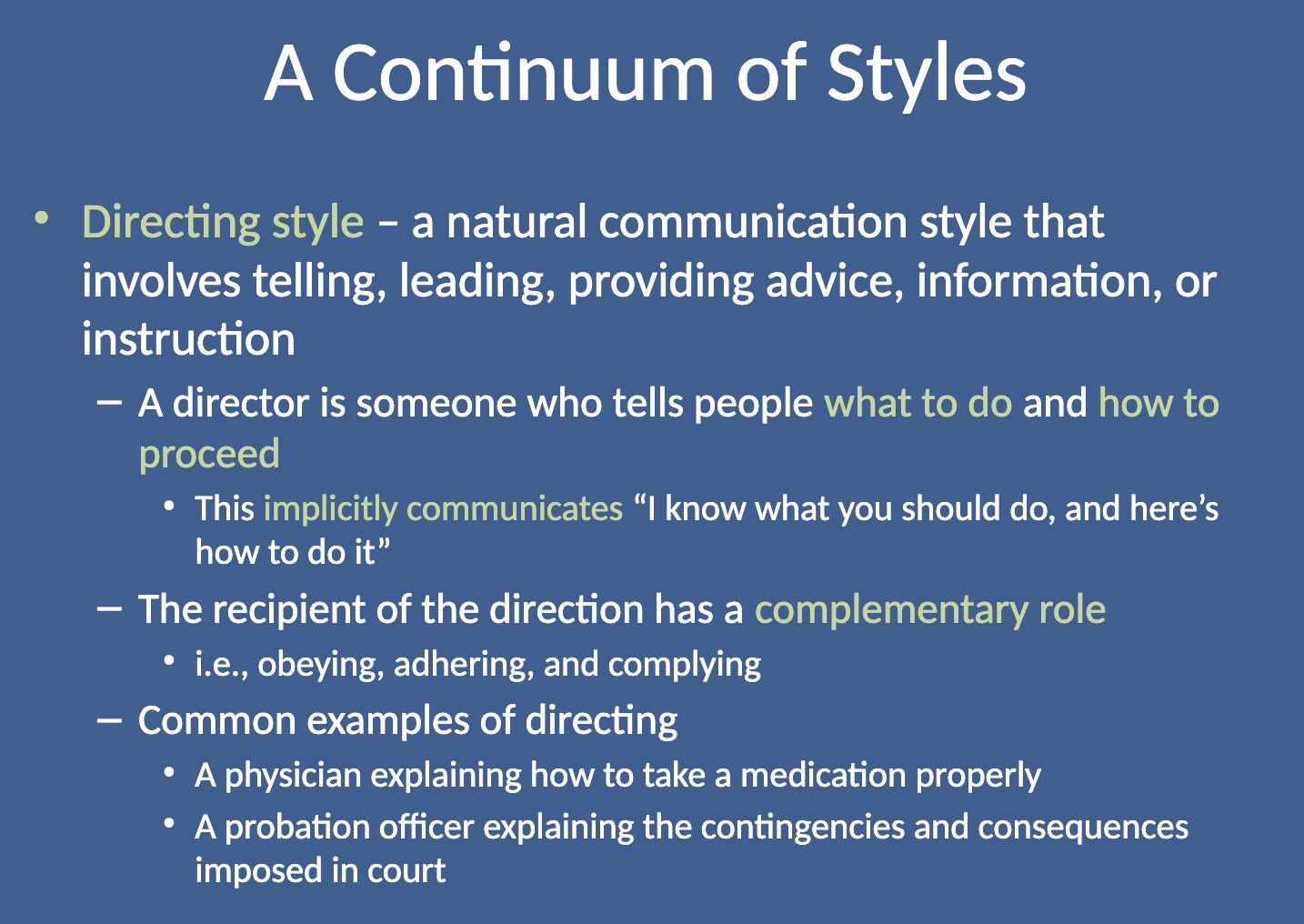
What is the role of the recipient in the directing style? (A Continuum of Styles)
The recipient’s role is a complementary role to obey, adhere, and comply with the direction given.
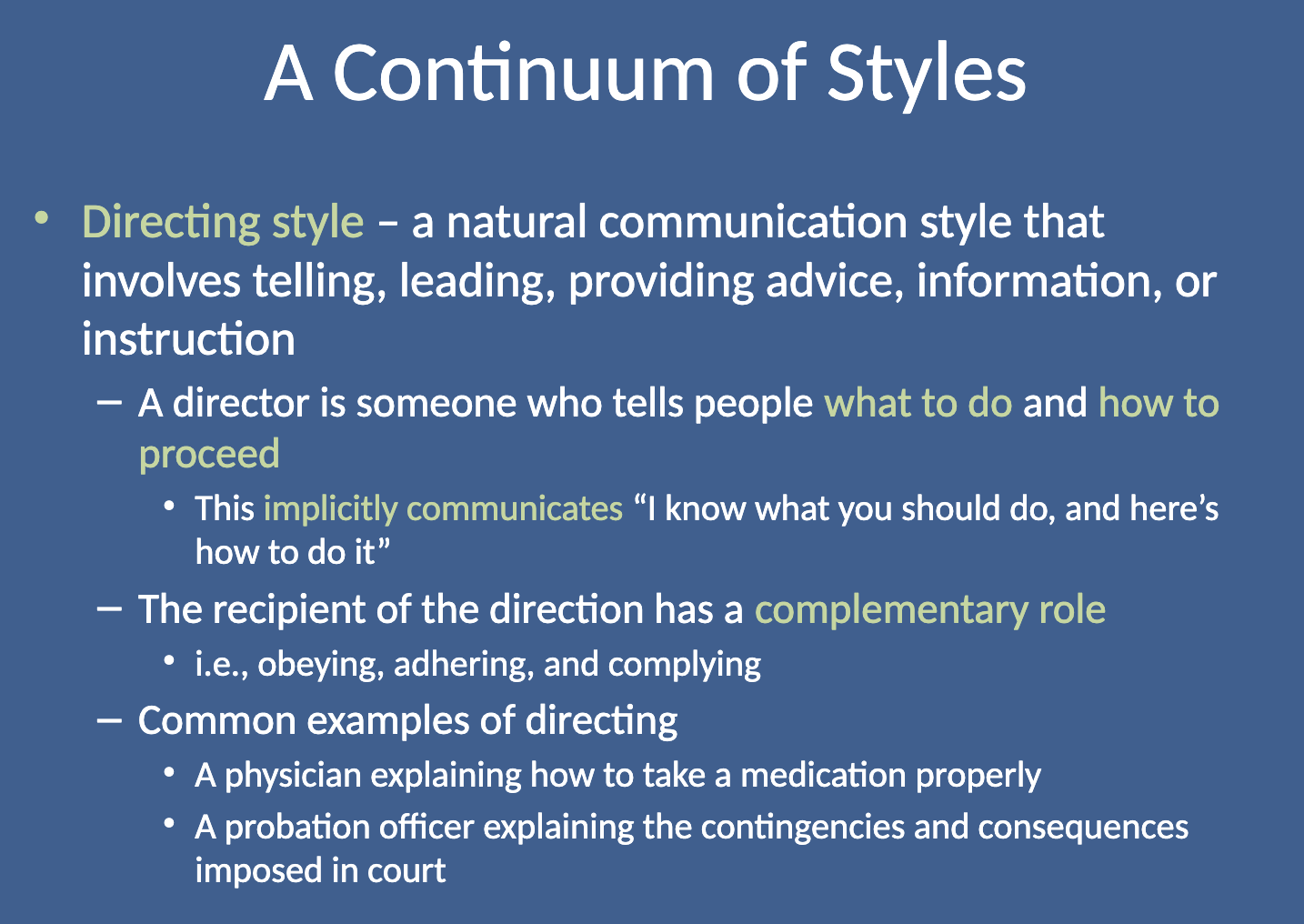
Can you provide examples of directing? (A Continuum of Styles)
Examples include a physician explaining how to take medication properly or a probation officer explaining the contingencies and consequences imposed in court.
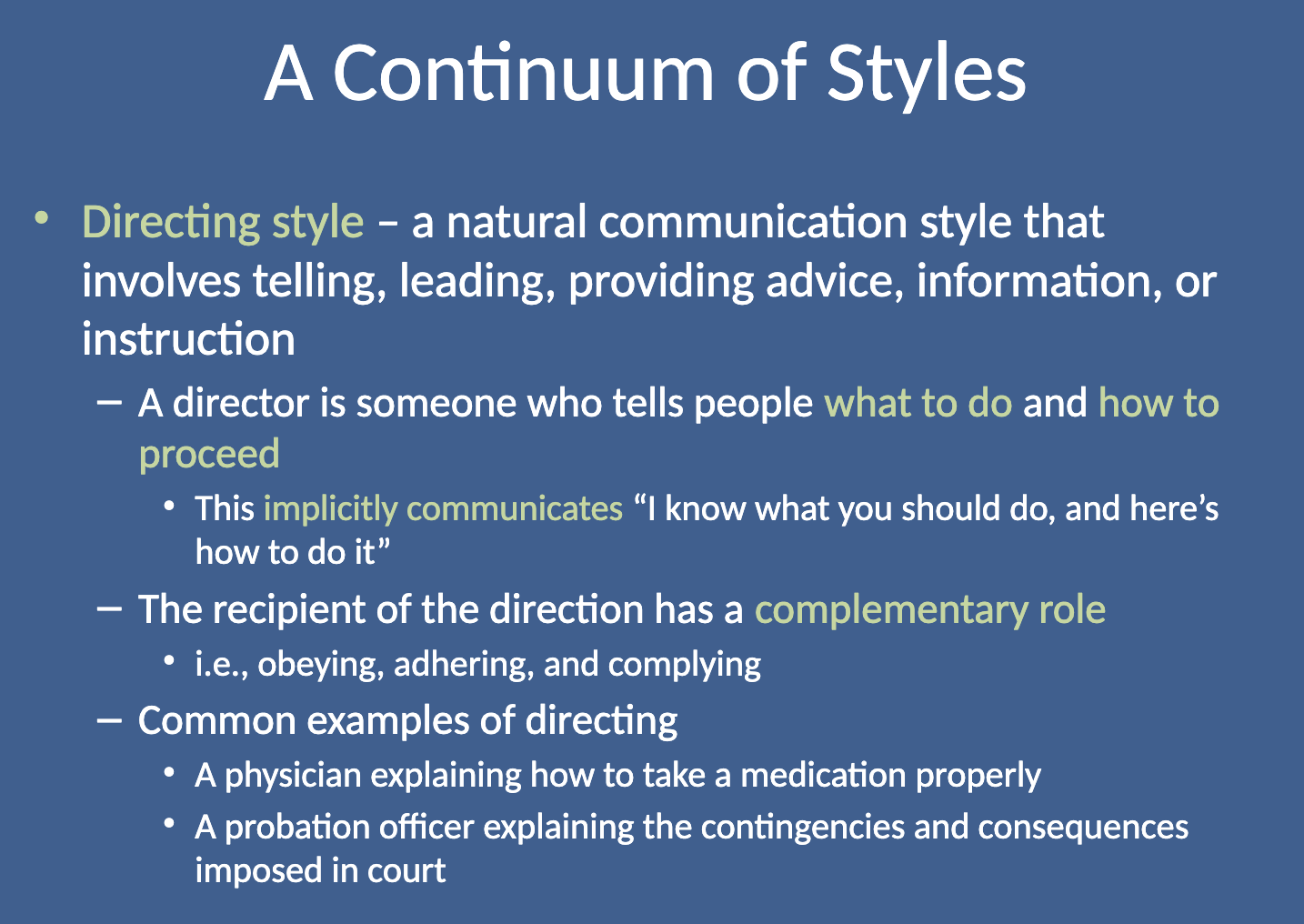
What is the following style in communication? (A Continuum of Styles)
The following style involves listening and following along with another's experience without inserting one's own material. Good listeners take interest and seek to understand.
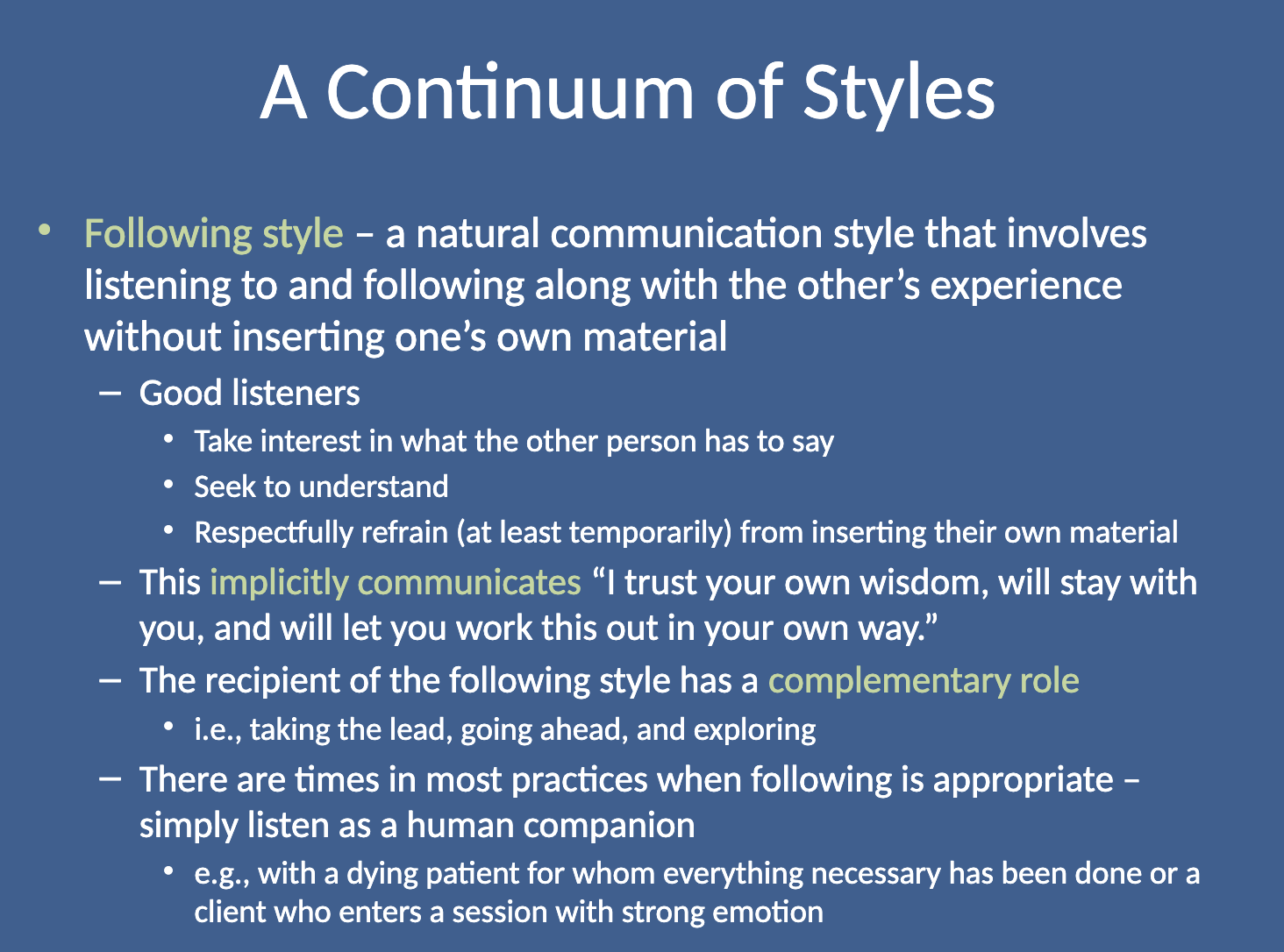
What does the following style implicitly communicate? (A Continuum of Styles)
The following style implicitly communicates “I trust your wisdom, will stay with you, and will let you work this out in your own way.”
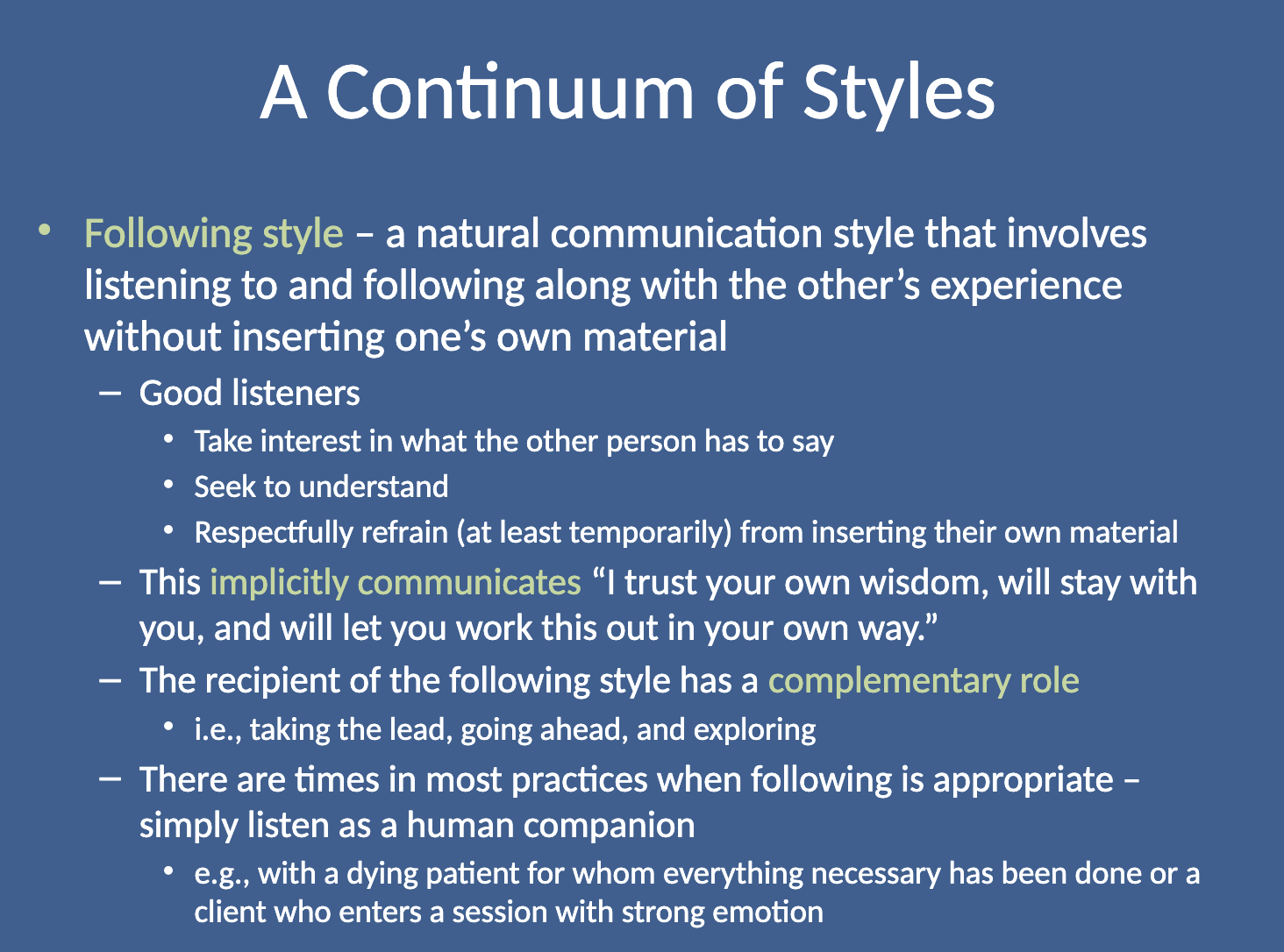
What is the recipient's role in the following style? (A Continuum of Styles)
The recipient's role is a complementary role to take the lead, go ahead, and explore on their own.
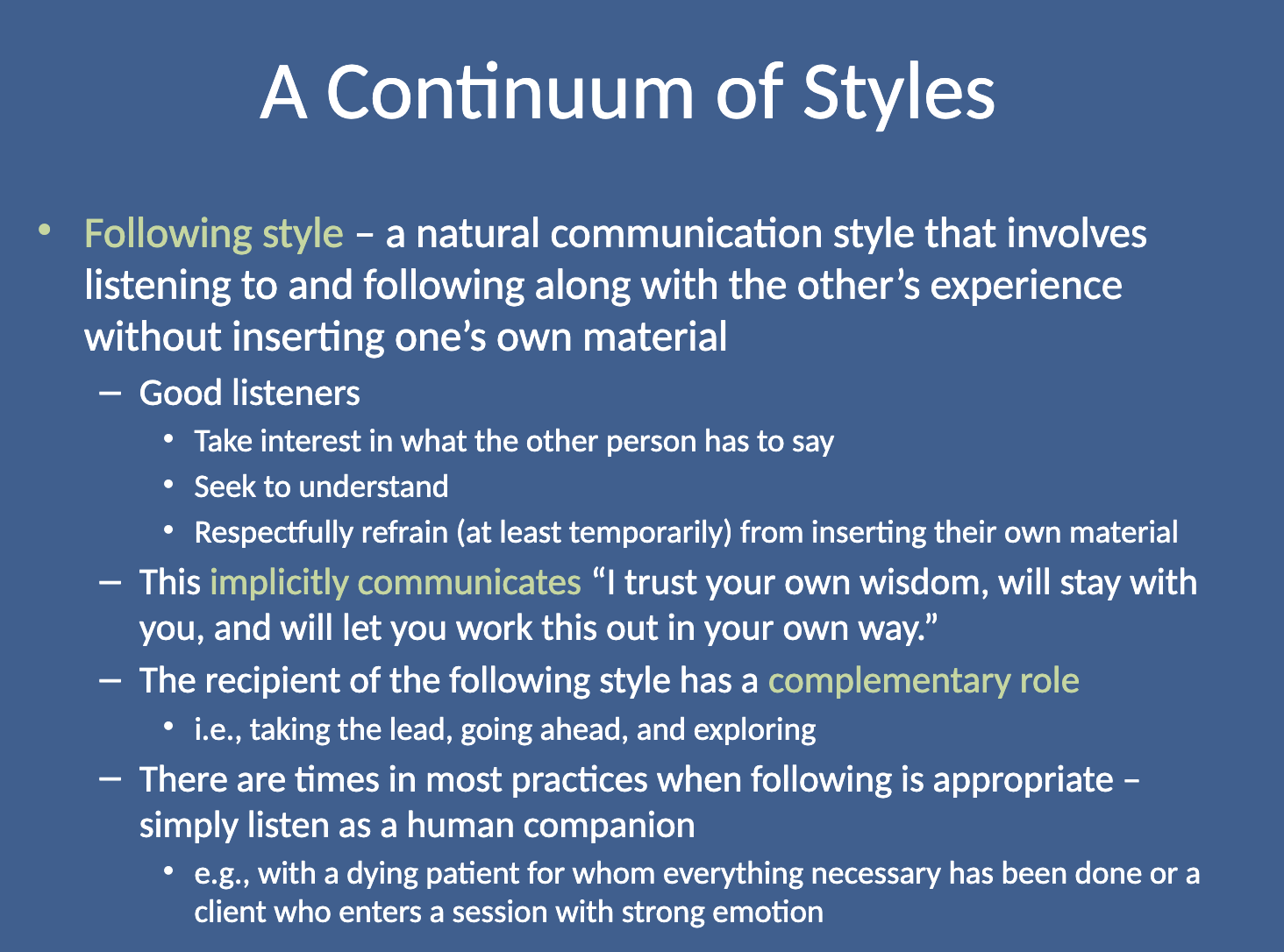
What is the guiding style in communication? (A Continuum of Styles)
The guiding style combines elements of both directing and following. It helps others find their way by listening and offering expertise where needed, without taking full control or simply following.
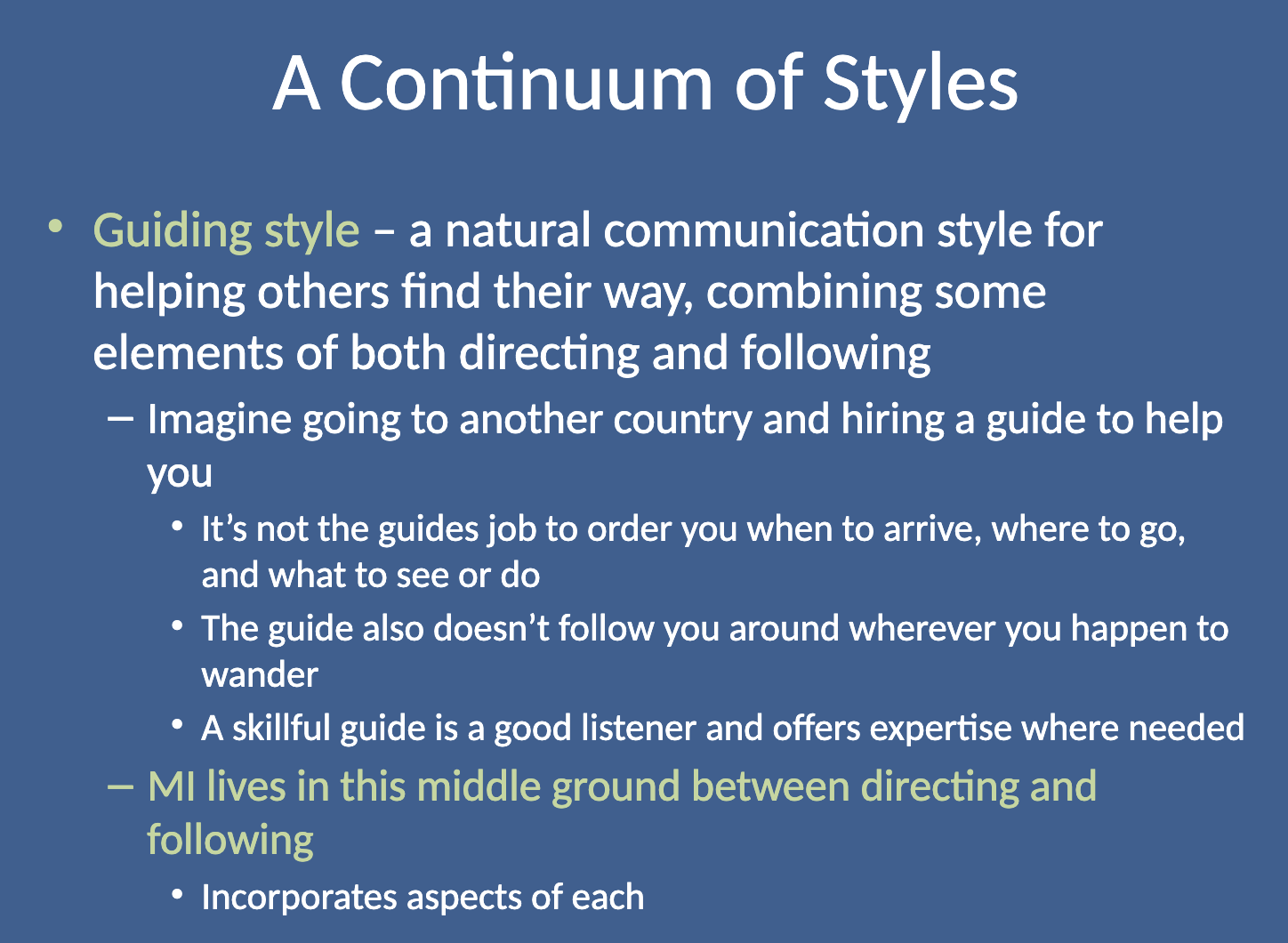
What does the guiding style implicitly communicate? (A Continuum of Styles)
The guiding style implicitly communicates “I’m here to help, and I’ll offer guidance where needed, but ultimately, you’re in control of your journey.”
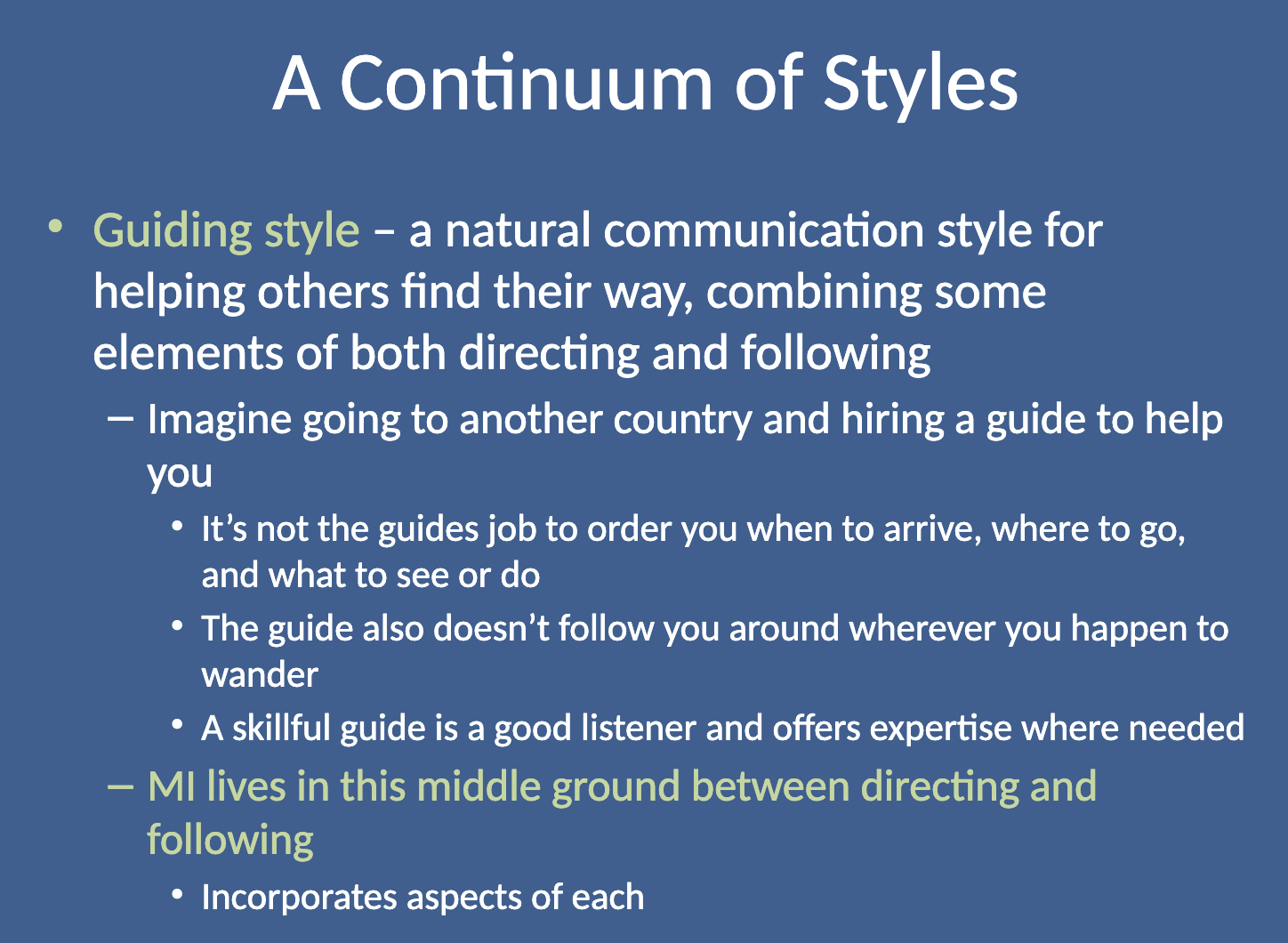
Where does MI (Motivational Interviewing) fit within the communication styles? (A Continuum of Styles)
MI lives in the middle ground between directing and following, combining aspects of both styles to guide individuals effectively.
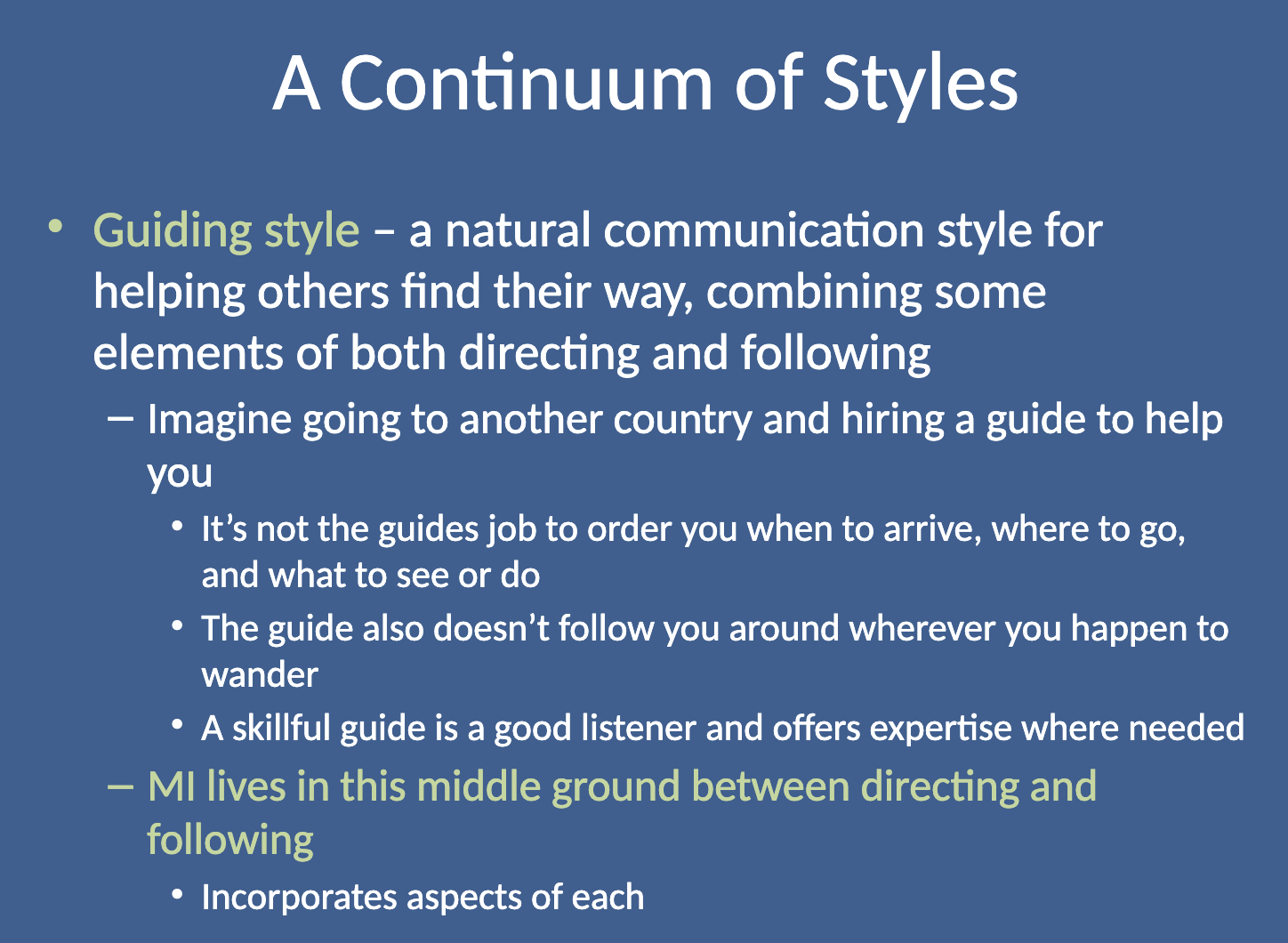
What verbs are commonly associated with the Directing, Following, and Guiding communication styles? (A Continuum of Styles)
Directing: tell, instruct, lead, advise, prescribe, order
Following: listen, reflect, observe, attend, acknowledge, allow
Guiding: suggest, support, collaborate, explore, recommend, encourage
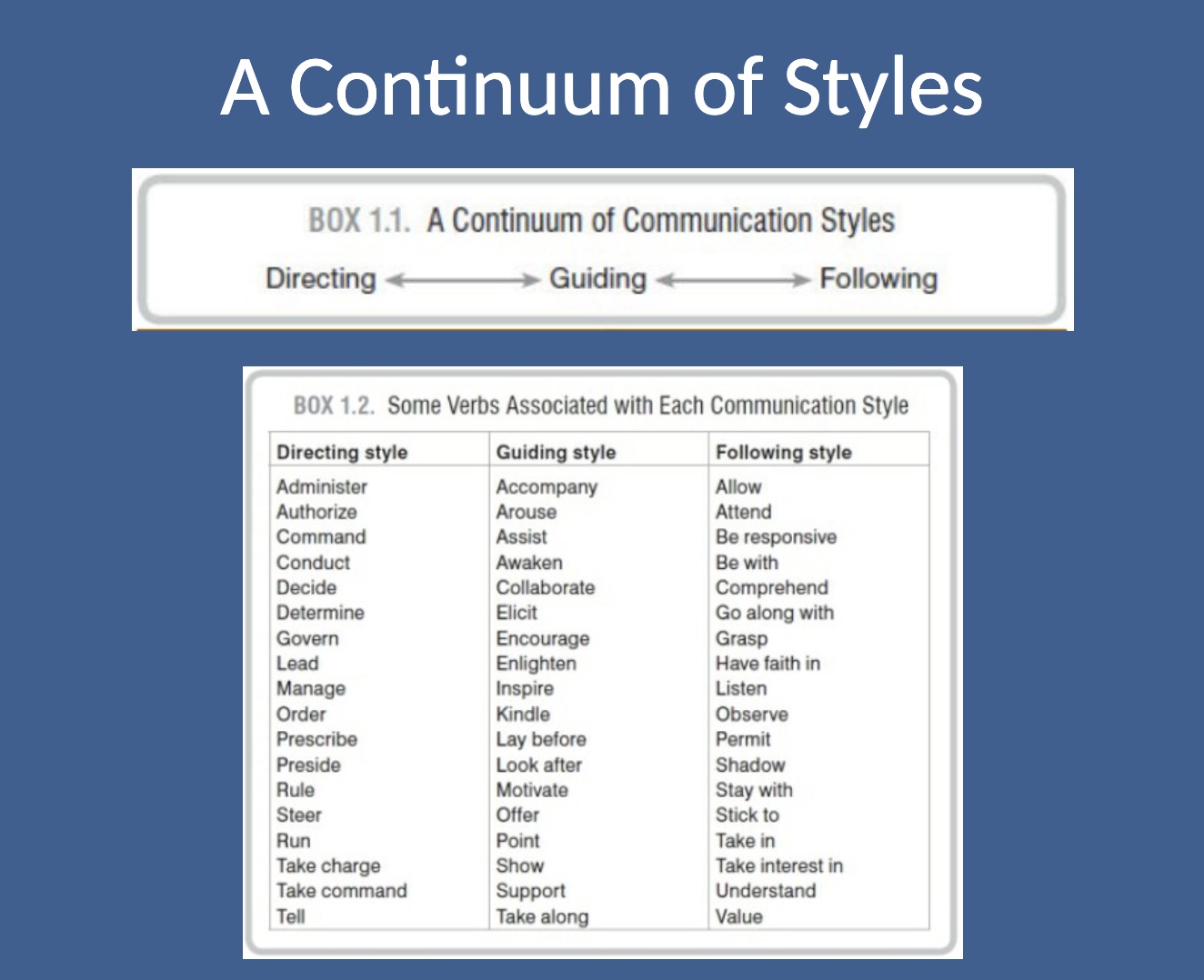
What are some selfless motives that draw people into helping professions? (The Righting Reflex)
Selfless motives include a desire to give back, prevent and alleviate suffering, manifest the love of God, and make a positive difference in others' lives and the world.
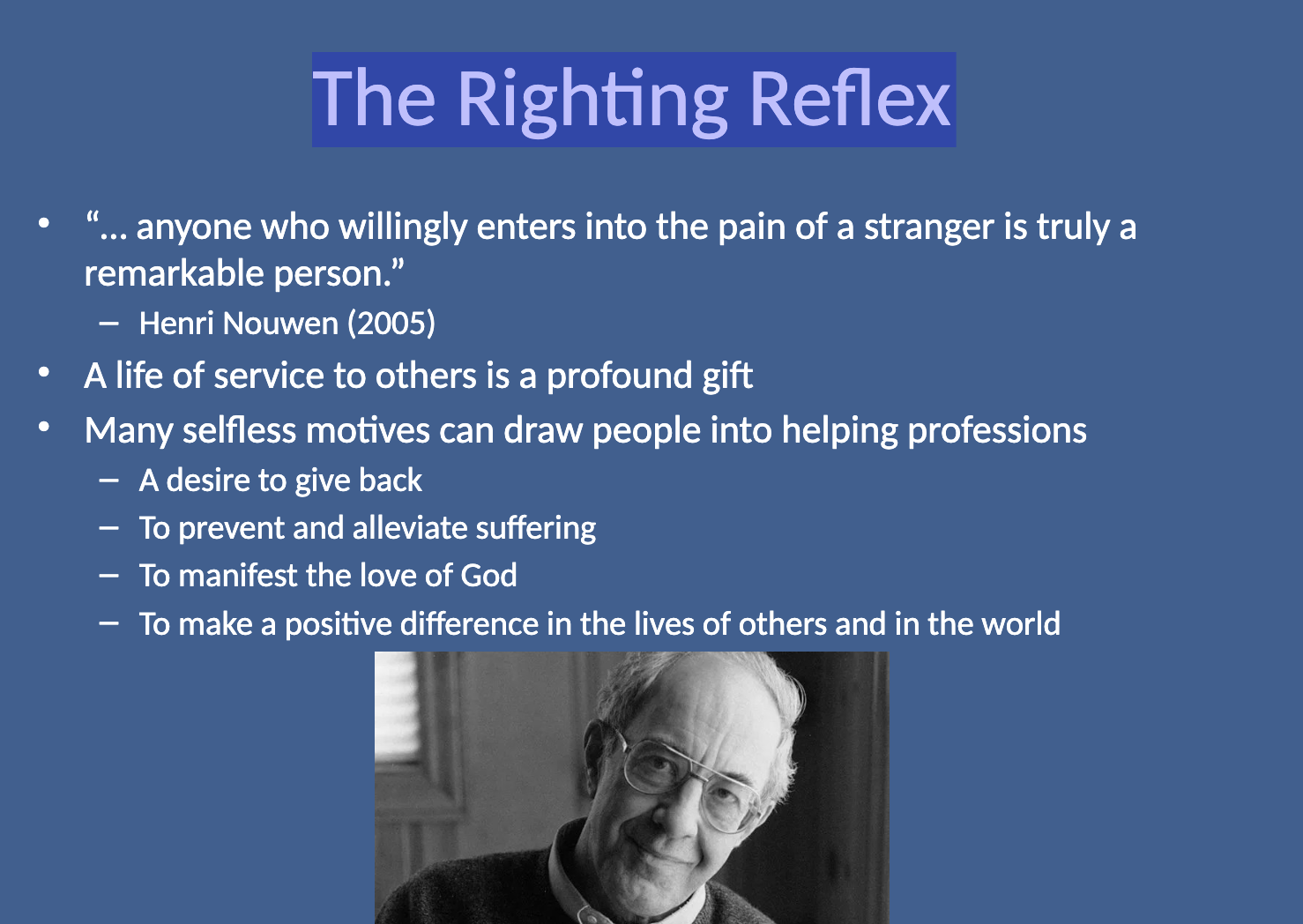
What can selfless motives sometimes lead to, and what does this mean? (The Righting Reflex)
They can lead to the overuse of the directing style, which may be ineffective or counterproductive when helping people change.
When someone is constantly directed, they may feel disempowered or resistant, making it more difficult for them to engage in their own change process.
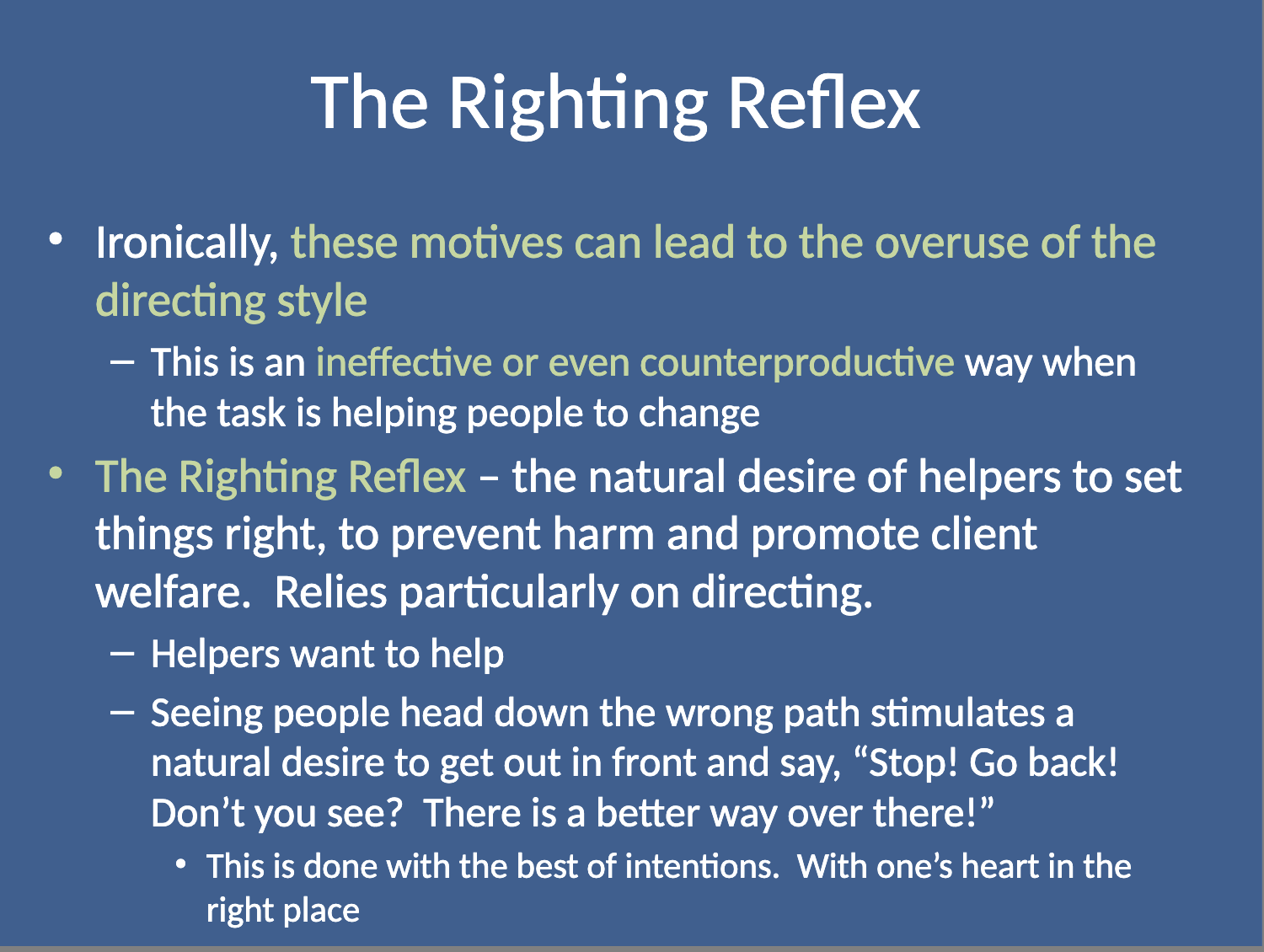
What is the Righting Reflex? (The Righting Reflex)
The Righting Reflex is the natural desire of helpers to fix things, prevent harm, and promote welfare by trying to steer people in the "right" direction—often through directing, even if done with good intentions.
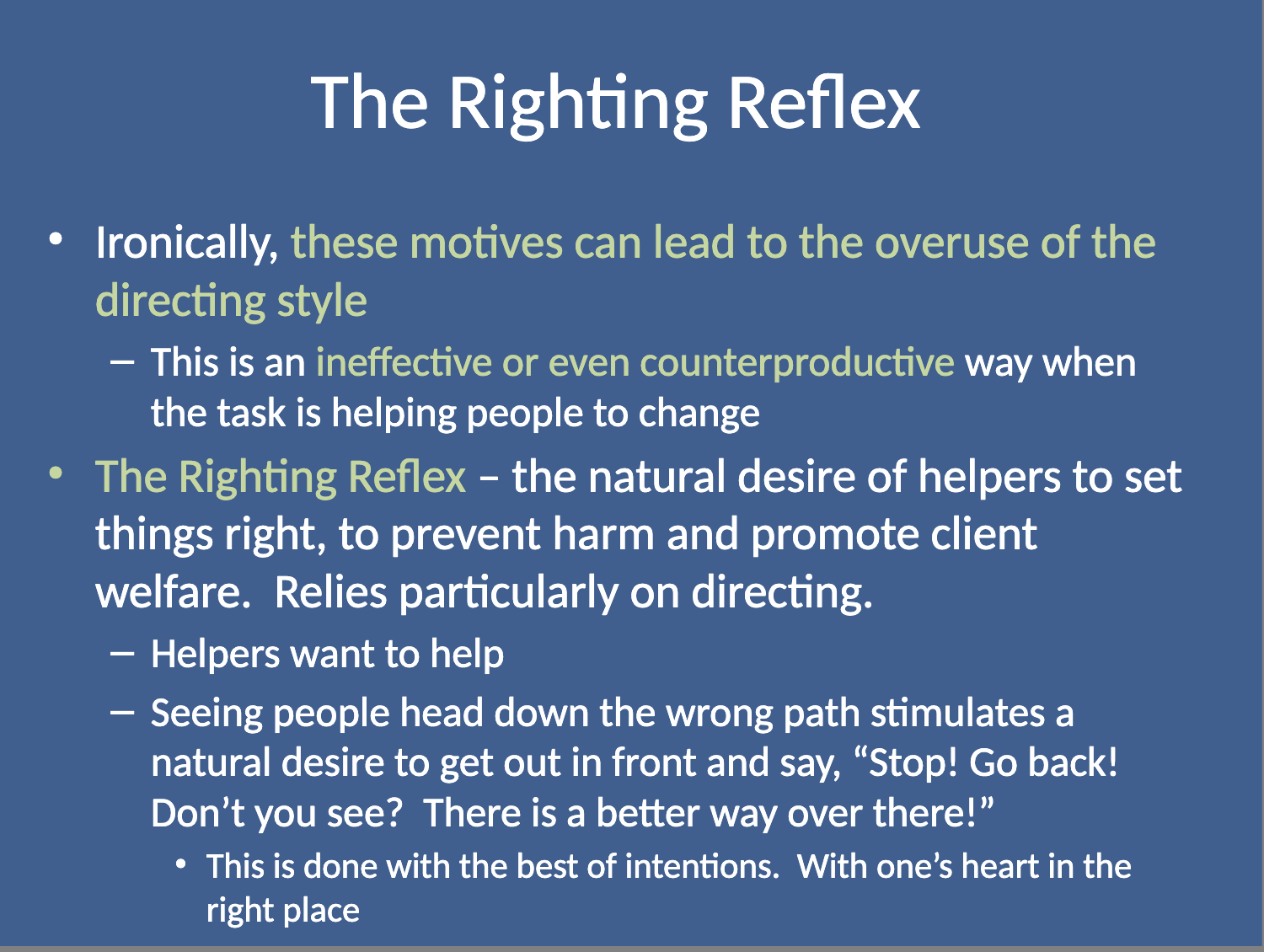
What are most people who need to make a change like, and what does this mean? (Ambivalence)
Most people who need to make a change are ambivalent about it. They see both reasons to change and reasons not to, wanting to change and not wanting to, all at the same time. Ambivalence is a natural part of the change process.
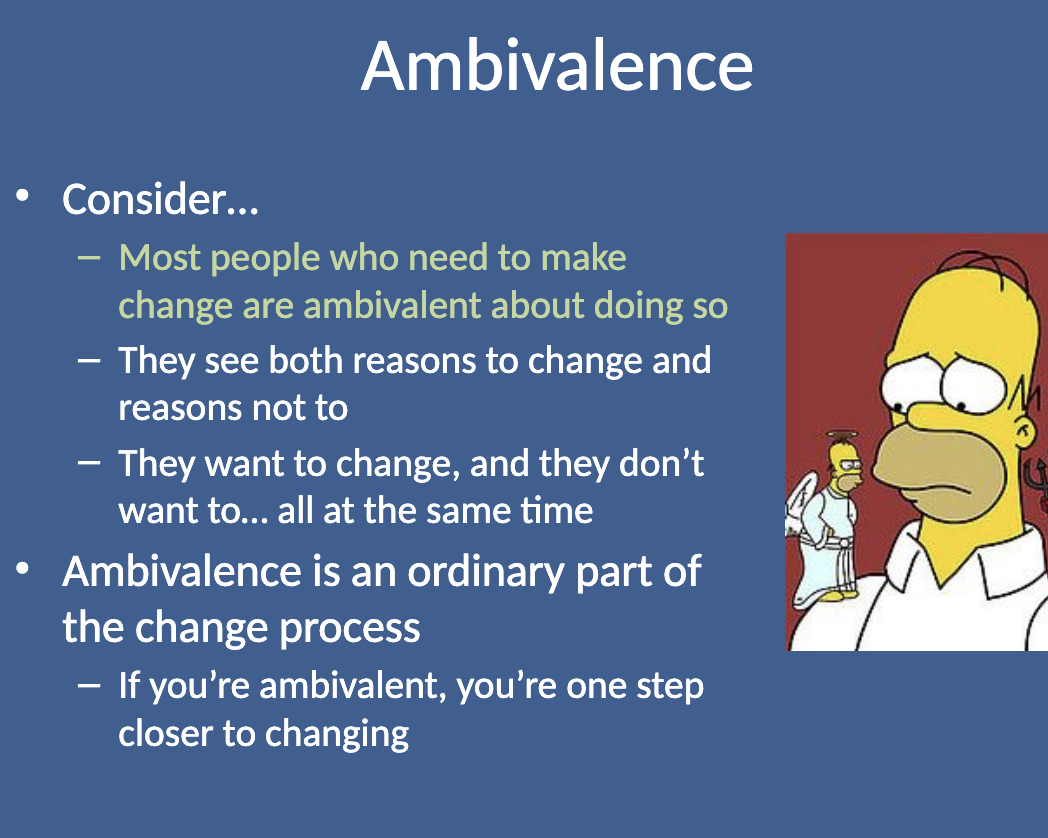
What about people who need to make a change but don’t see any reason to do so? (Ambivalence)
Some people need to make a change (according to others) but see little or no reason to do so. They may like things the way they are or have tried to change in the past and given up. Developing ambivalence is a step forward for them.
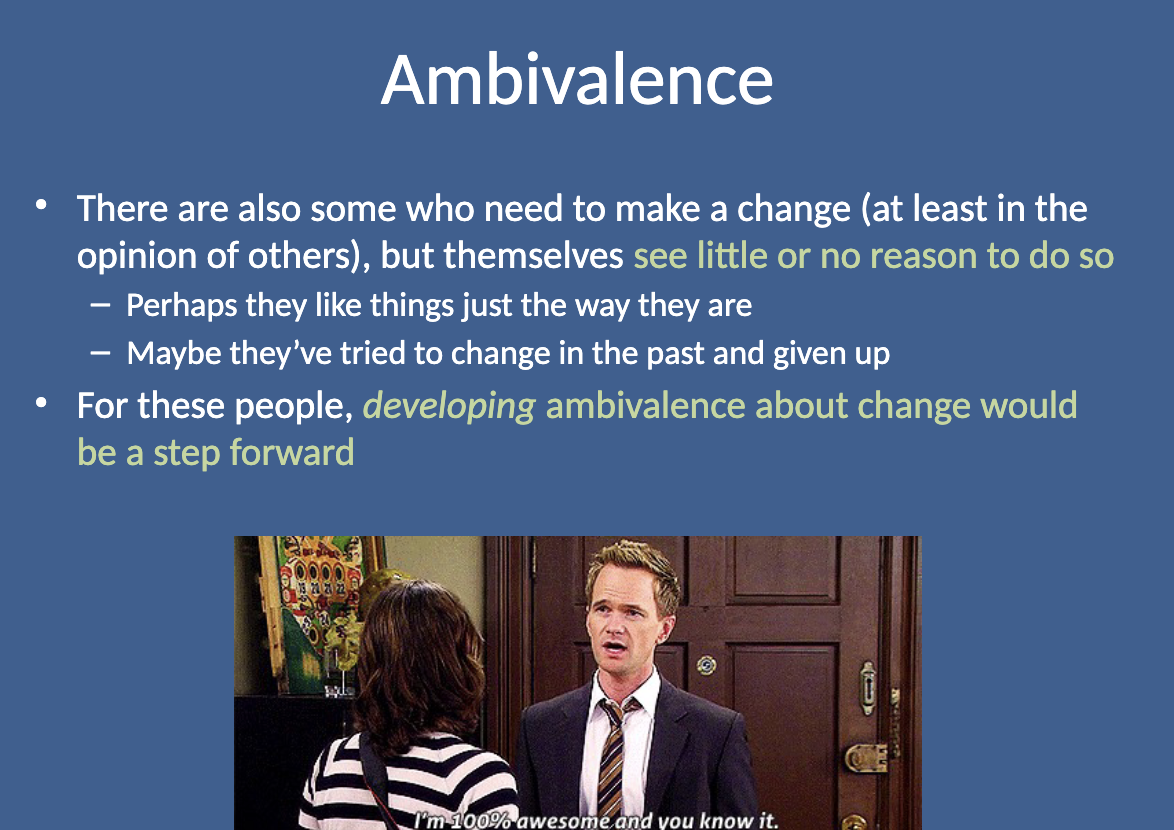
What happens when people don’t have reasons to change and develop ambivalence? (Ambivalence)
People who don't see reasons to change might develop ambivalence, which is a step toward change. Ambivalence involves holding conflicting desires or motivations, such as wanting to change but also resisting it.
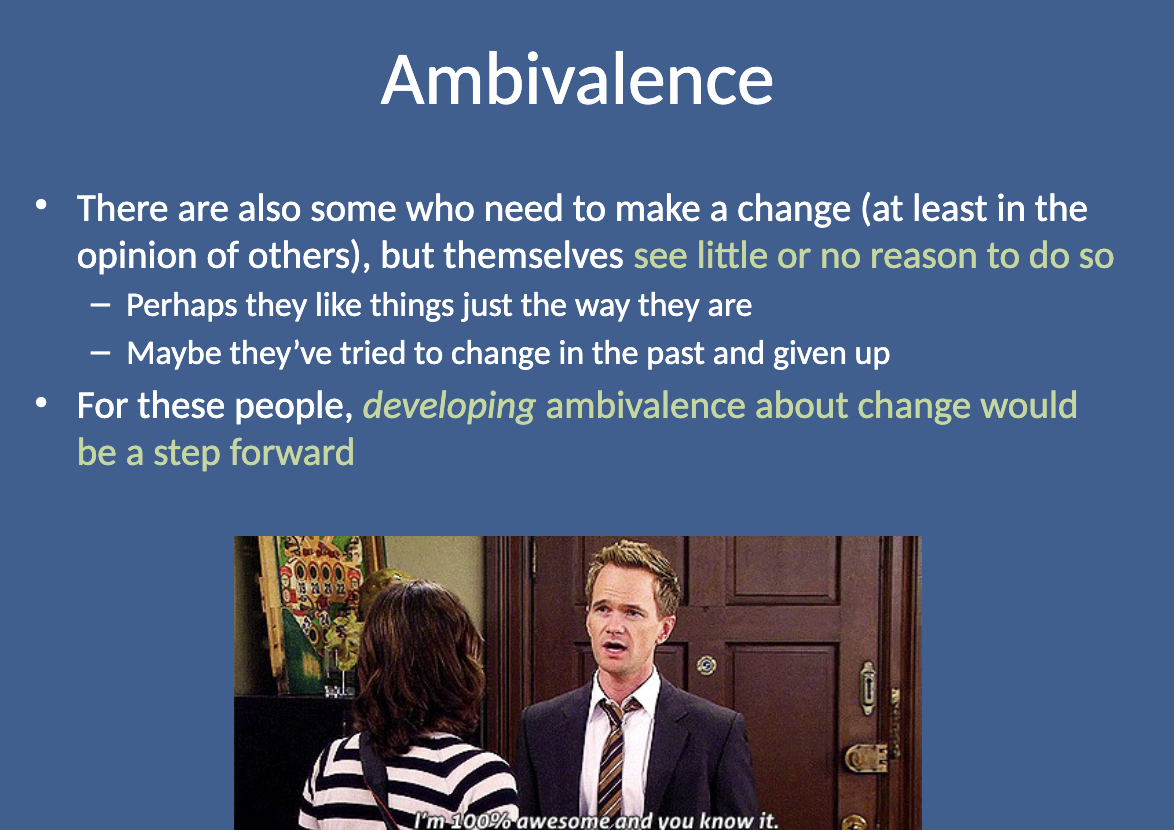
What is ambivalence? (Ambivalence)
Ambivalence is the state of simultaneously wanting and not wanting something or wanting two incompatible things at the same time. It is a normal part of the change process.
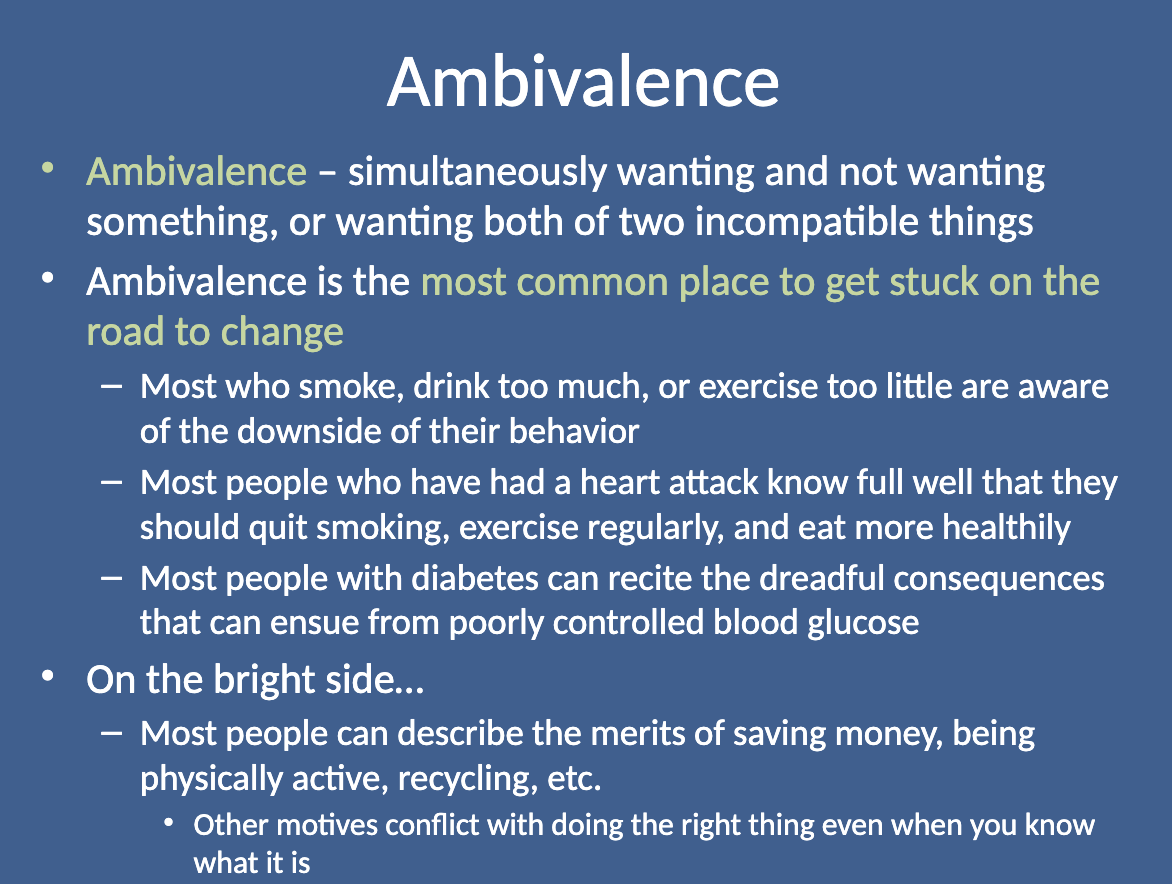
Where do most people get stuck on the road to change? (Ambivalence)
The most common place to get stuck is in ambivalence, where people know the downsides of their behavior but are also conflicted about changing.
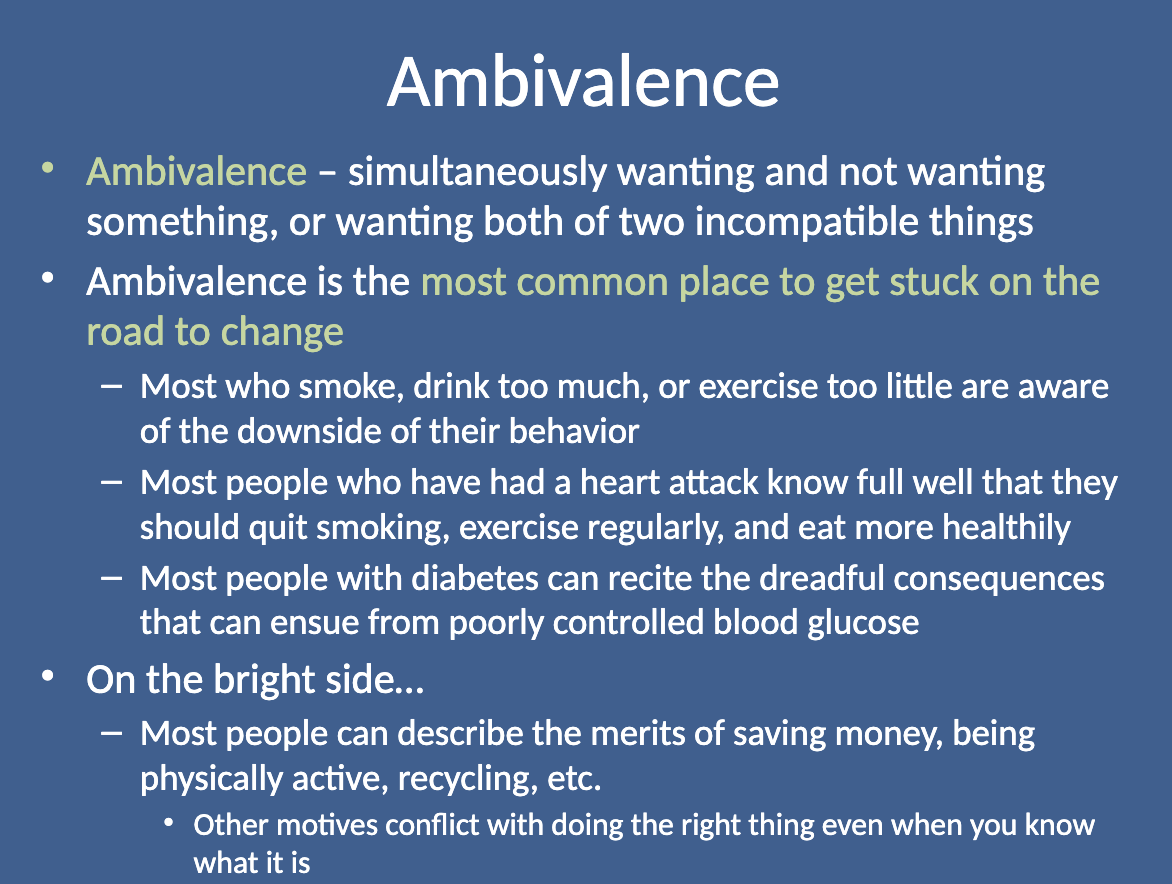
Can you give examples of ambivalence in the road to change? (Ambivalence)
Examples include:
Smokers who know the risks but continue to smoke.
People who had a heart attack but struggle to exercise or eat healthily.
People with diabetes who know the consequences of poor blood glucose control but resist making changes.
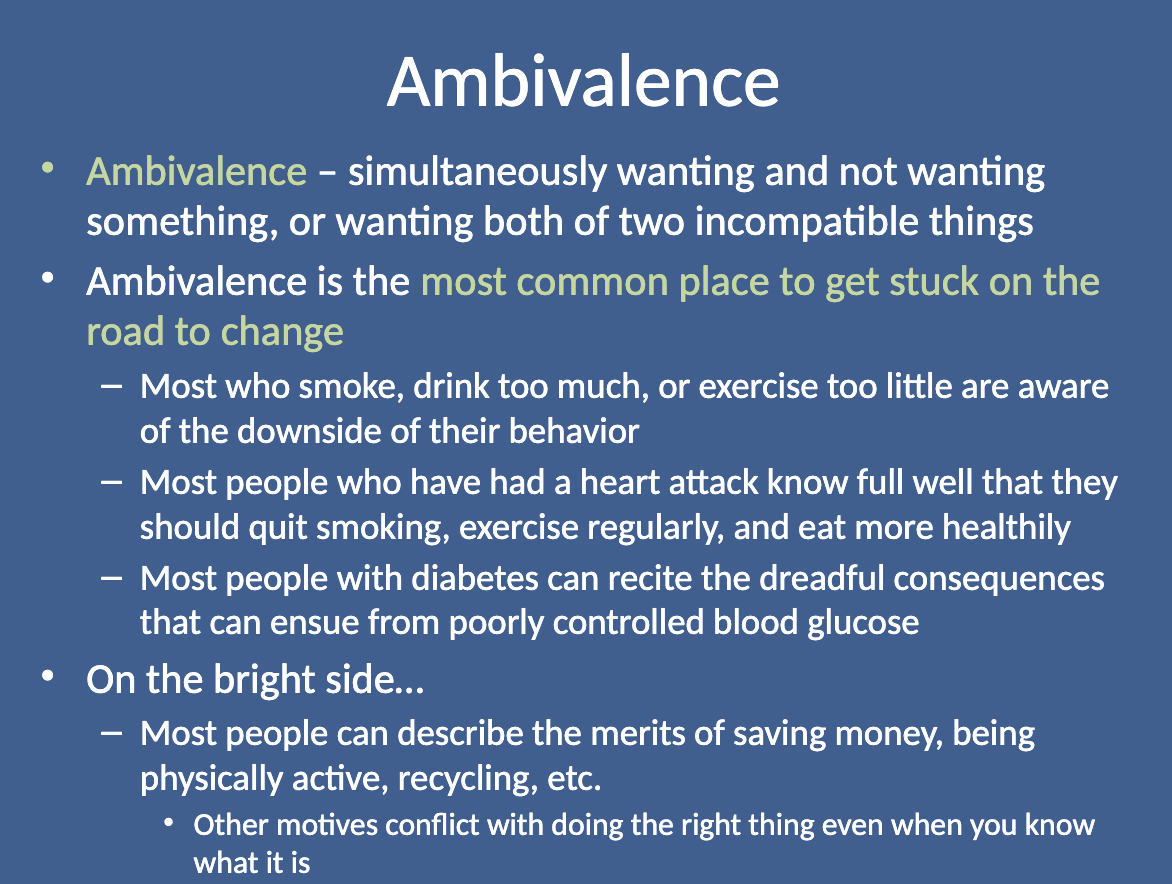
What is normal to hear when a person is ambivalent about change? (Ambivalence)
In ambivalence, it's normal to hear both "change talk" and "sustain talk" mixed together. This often happens in the same sentence.

What are the two kinds of talk commonly heard in ambivalence? (Ambivalence)
The two kinds of talk are:
Change talk: Any speech that favors movement toward a change goal.
Sustain talk: Any speech that favors maintaining the status quo, resisting change.
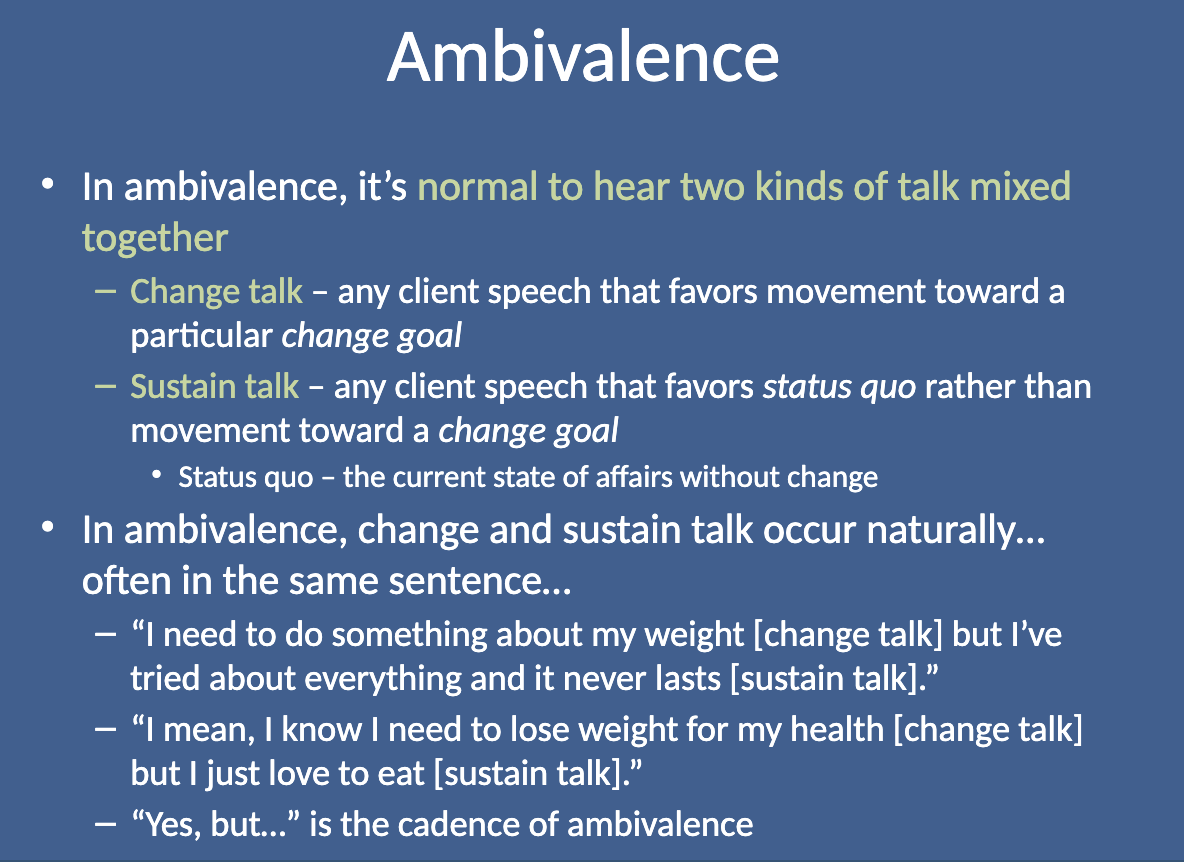
What is change talk in the context of ambivalence? (Ambivalence)
Change talk is speech that favors making a change, such as expressing the desire or need to change.
Example: "I need to do something about my weight."
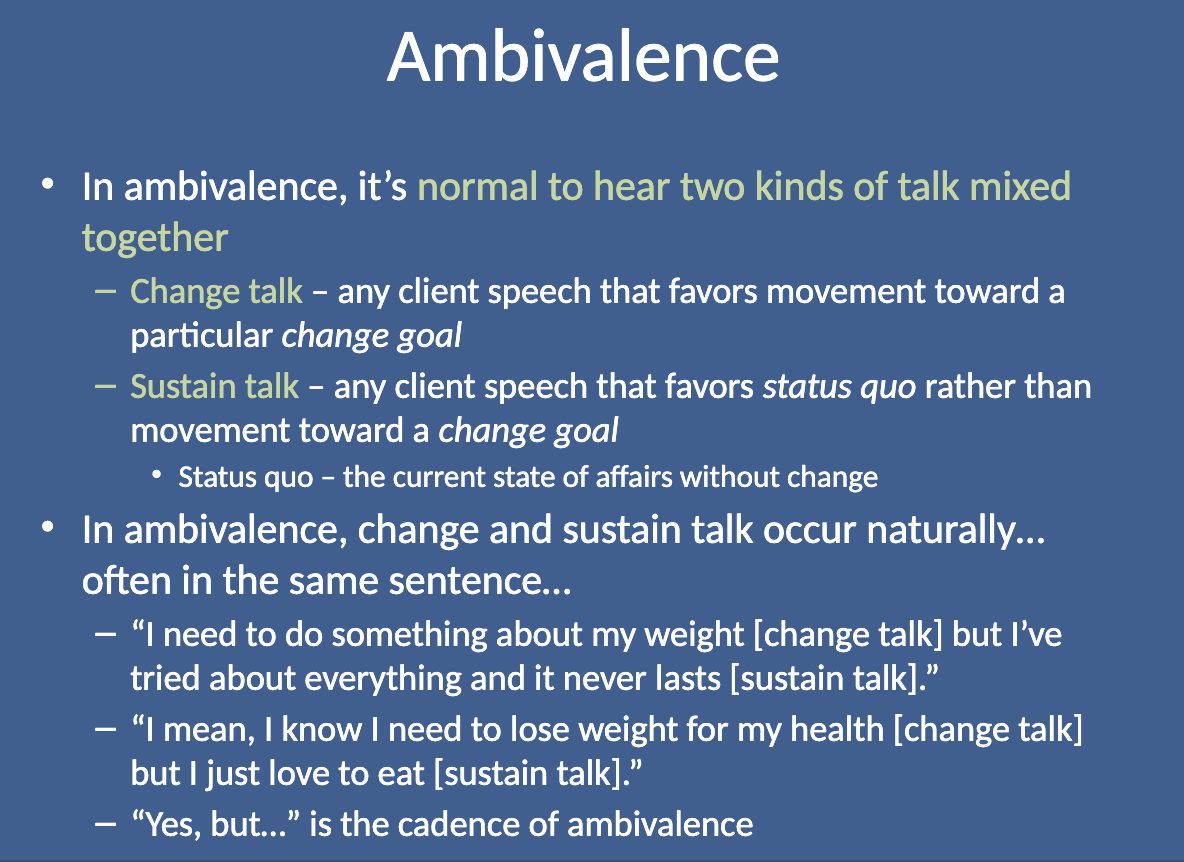
What is sustain talk in the context of ambivalence? (Ambivalence)
Sustain talk is speech that favors maintaining the current state or status quo, resisting change.
Example: "I’ve tried everything, and it never lasts."
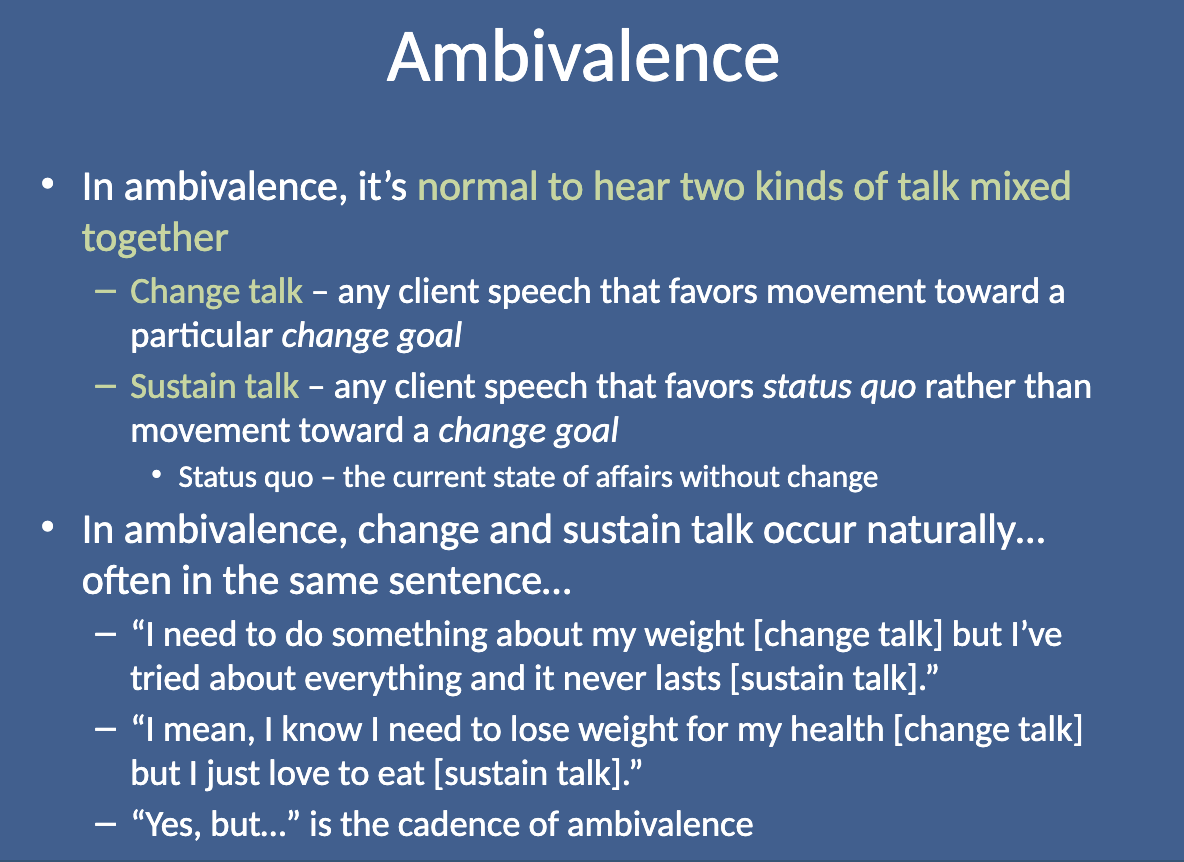
How do people often get stuck in ambivalence? (Ambivalence)
People get stuck in ambivalence by swinging back and forth between reasons to change and reasons not to, leading to indecision. The closer they get to one alternative, the more its disadvantages become apparent, and nostalgia for the other choice grows.
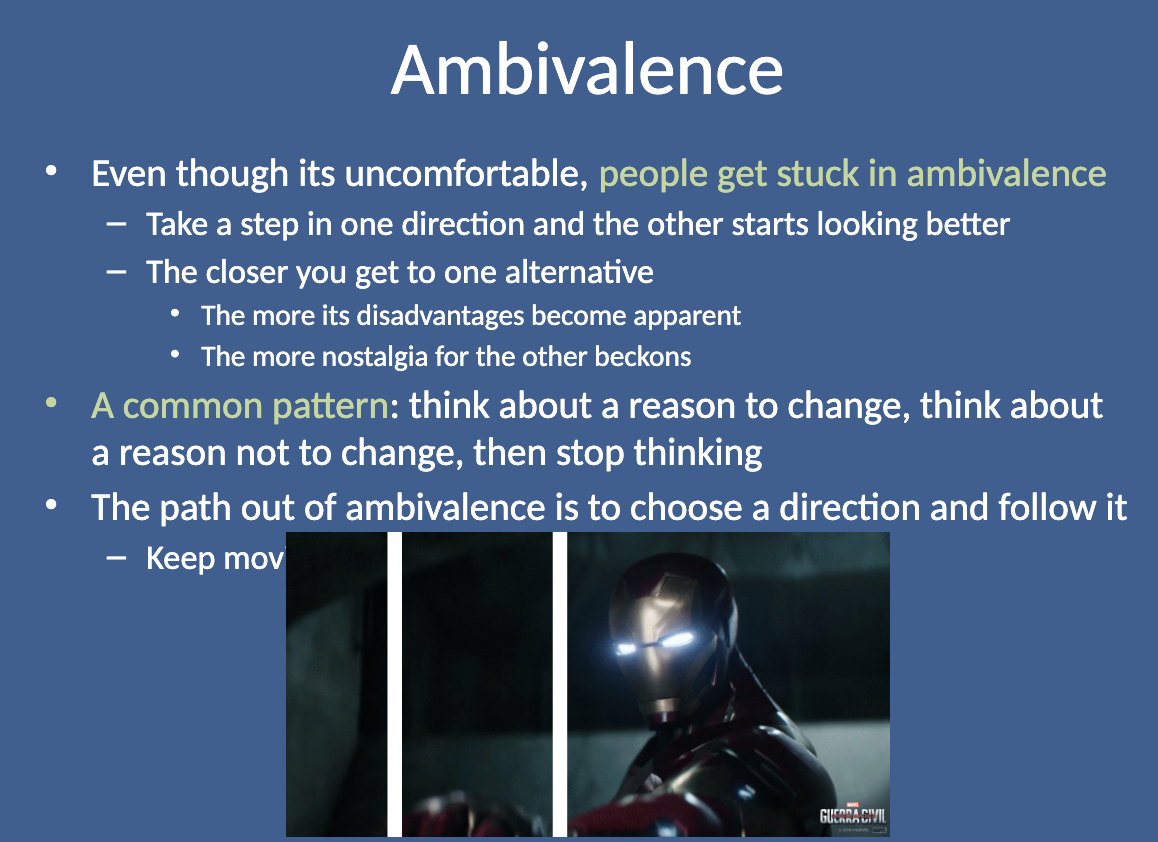
What is the common pattern people follow when they are stuck in ambivalence? (Ambivalence)
The common pattern is: think about a reason to change, think about a reason not to change, and then stop thinking. This leads to inaction.
What happens when an ambivalent person meets a helper with the righting reflex? (Ambivalence)
The helper’s instinct is to argue for the "good" side of change, even though the ambivalent person already knows the arguments for and against it. This can lead to resistance rather than progress.

Can you provide an example of what happens when a helper uses the righting reflex with an alcohol-dependent person? (Ambivalence)
Helper: “You have a serious drinking problem and you need to quit.”
Fantasized reply: “Oh, I see. I just didn’t realize how serious it is. Ok, that’s what I’m going to do!”
Likely reply: “No I don’t.”
The person has already heard the "good" arguments and may resist further persuasion.
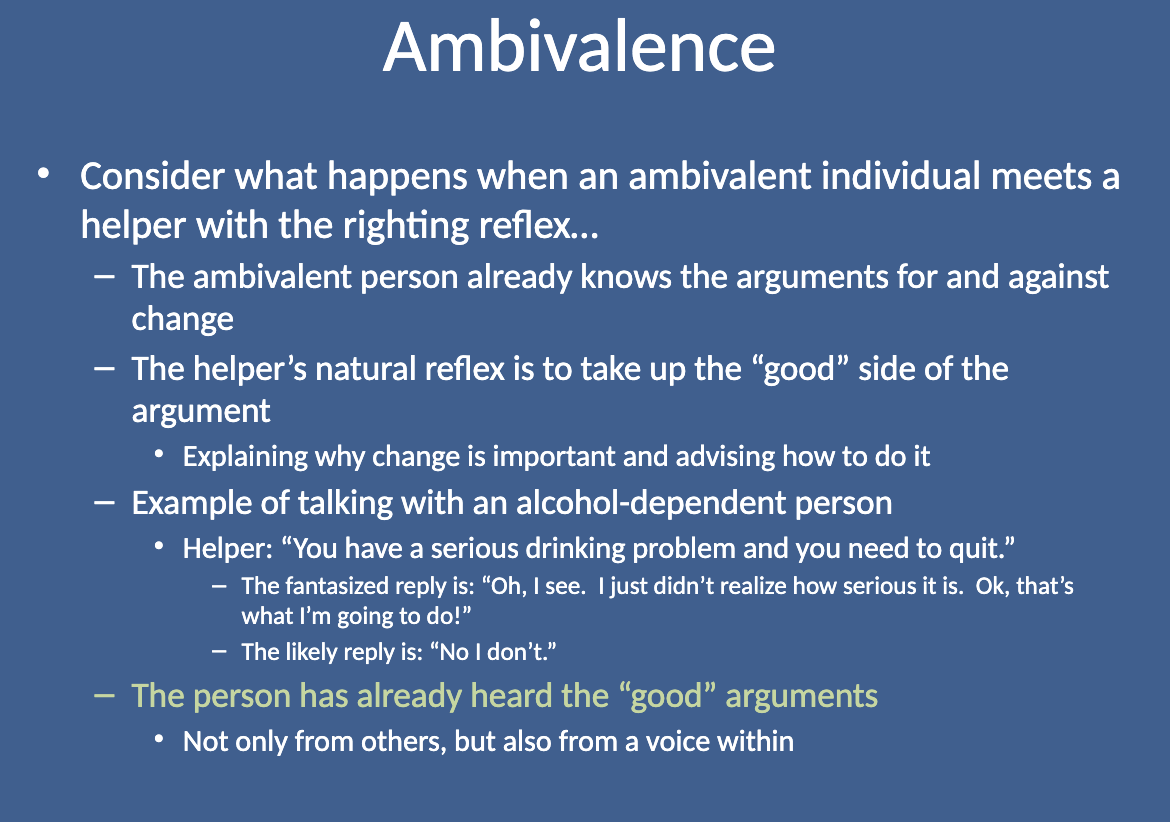
What do most people tend to believe and trust when it comes to opinions? (Ambivalence)
Most people tend to believe and trust their own opinions more than those of others. They are more likely to act on their own reasoning.
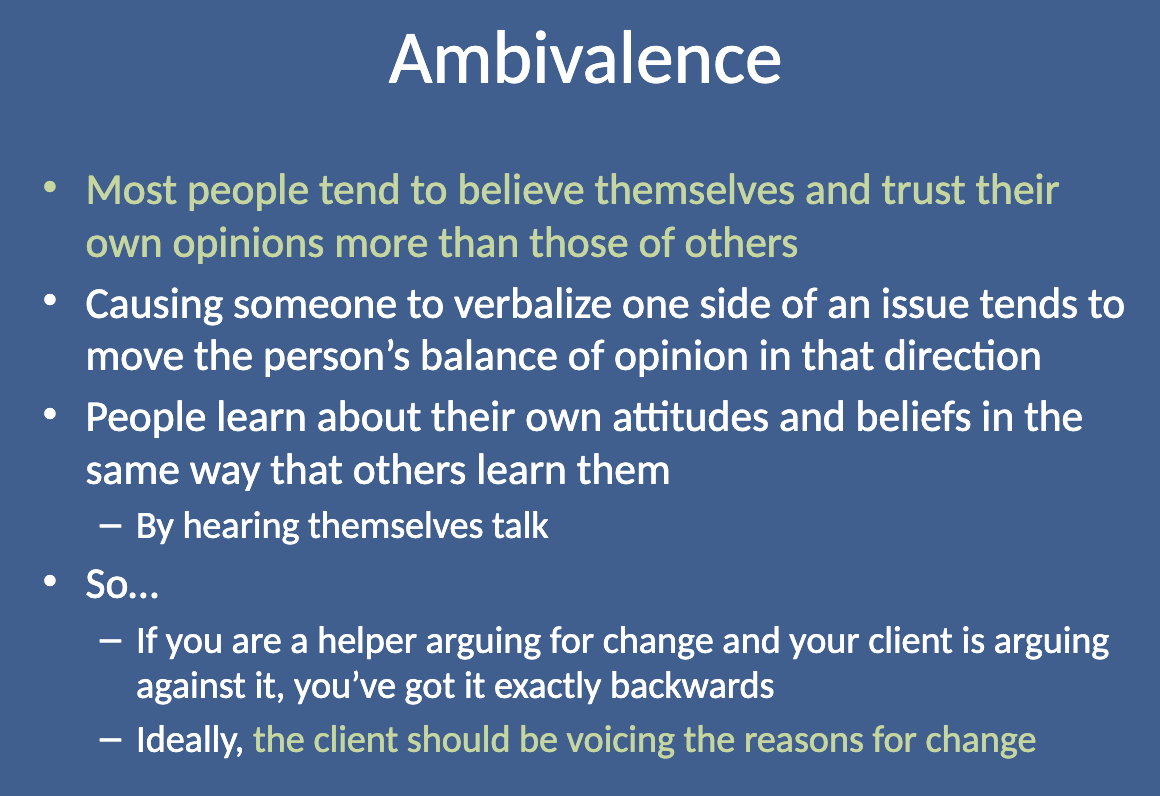
What should ideally be happening when helping someone with change? (Ambivalence)
Ideally, the client should be voicing the reasons for change themselves. This helps move the person toward change, as they are more likely to trust their own reasons and decisions.
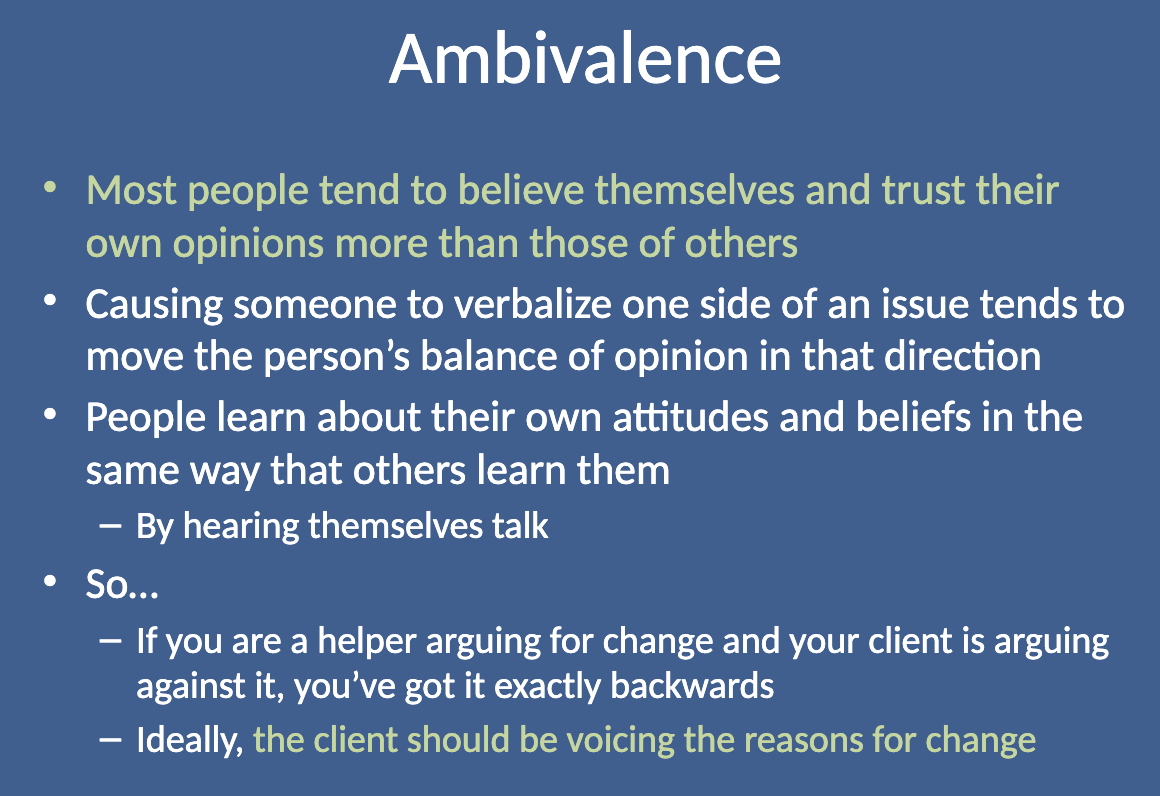
What is the Righting Reflex? (The Dynamics of Change Conversations)
The Righting Reflex is the belief that you must convince or persuade someone to do the "right thing" by providing the correct arguments, solutions, or logic.

What were the primary assumptions of addiction treatments before MI, and how were they ineffective? (The Dynamics of Change Conversations)
Before MI, addiction treatments assumed that to make someone change, you had to:
Ask the right questions
Provide the proper arguments
Give critical information
Trigger the right emotions or logic
This approach triggered the Righting Reflex from the helper, but it wasn’t effective because it often met resistance and didn’t lead to long-term change.

What is a thought experiment related to ambivalence and change? (A Thought Experiment)
The thought experiment involves thinking of a change you want or need to make, but haven’t yet. Imagine a "helper" who tells you why you need to change, provides reasons, tells you how to do it, and encourages you to get started.
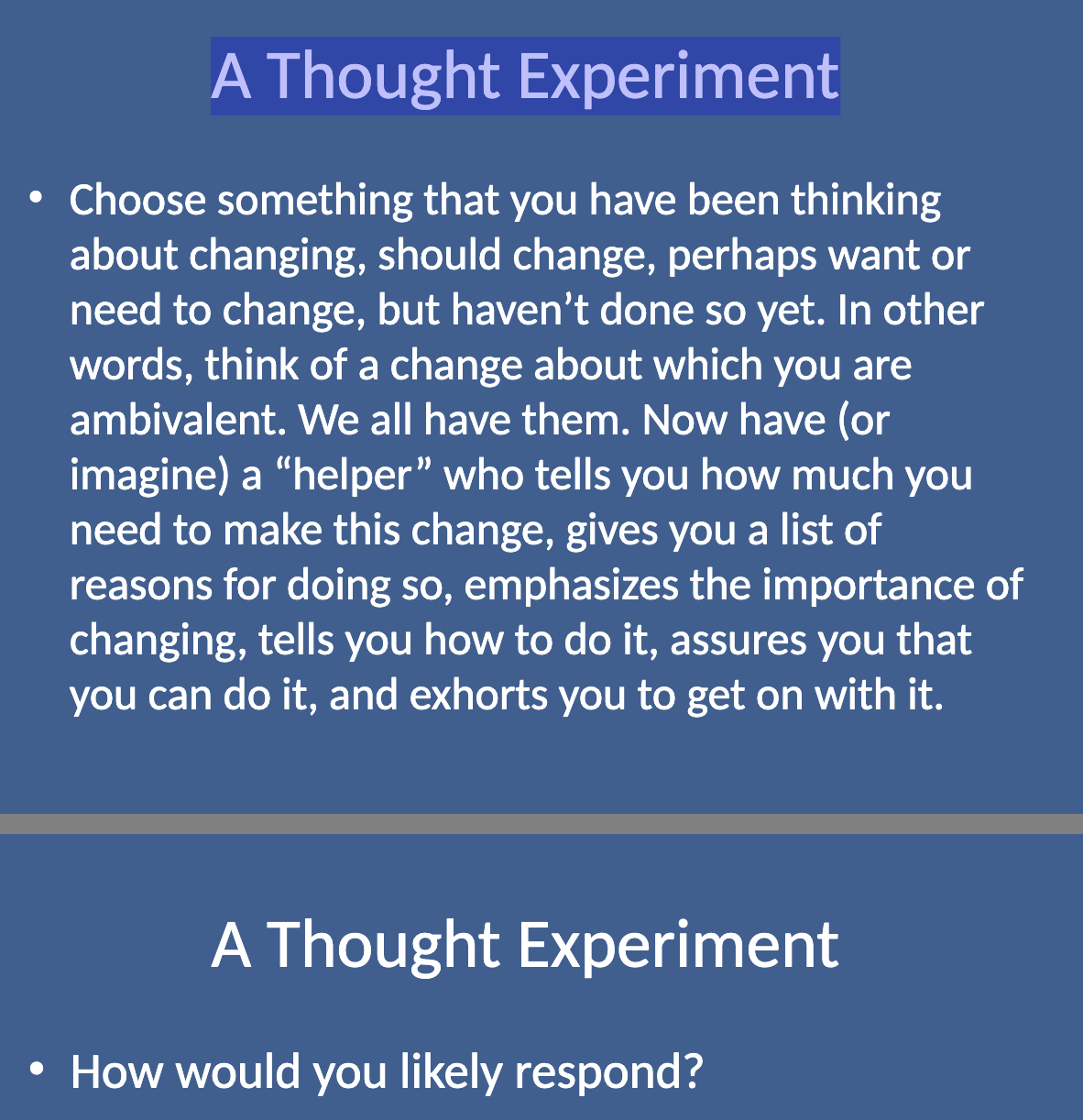
How would the "helped" person most likely respond in the thought experiment? (A Thought Experiment)
Most often, the "helped" person would feel:
Angry (agitated, not heard or understood)
Defensive (oppositional, justifying, unwilling to change)
Uncomfortable (ashamed, overwhelmed, eager to leave)
Powerless (passive, discouraged, disengaged)
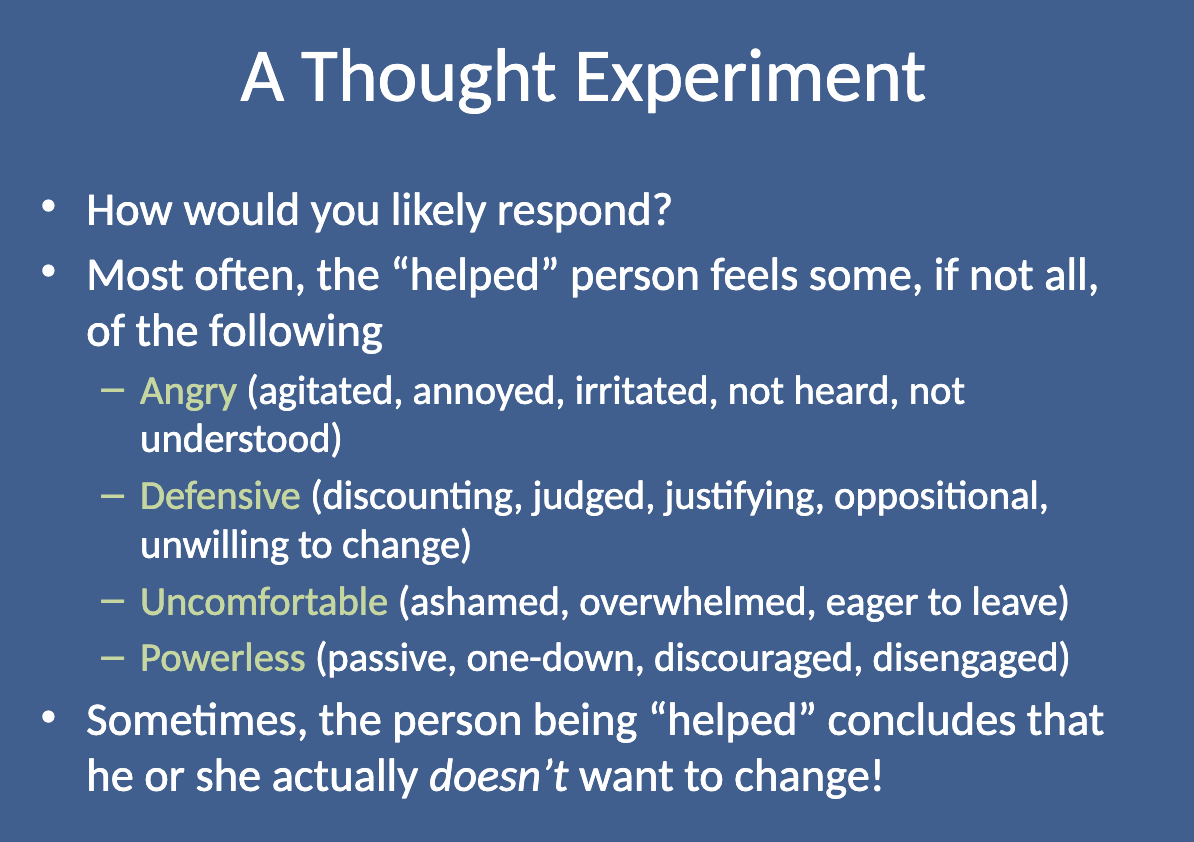
How would the "helped" person respond in each of these four ways? (A Thought Experiment)
Angry: They may feel agitated, not understood, and frustrated with the advice.
Defensive: They might justify their current behavior, discount the advice, or oppose the helper’s suggestions.
Uncomfortable: They could feel ashamed, overwhelmed, or eager to escape the conversation.
Powerless: They may feel passive, discouraged, disengaged, or like they have no control over the situation.
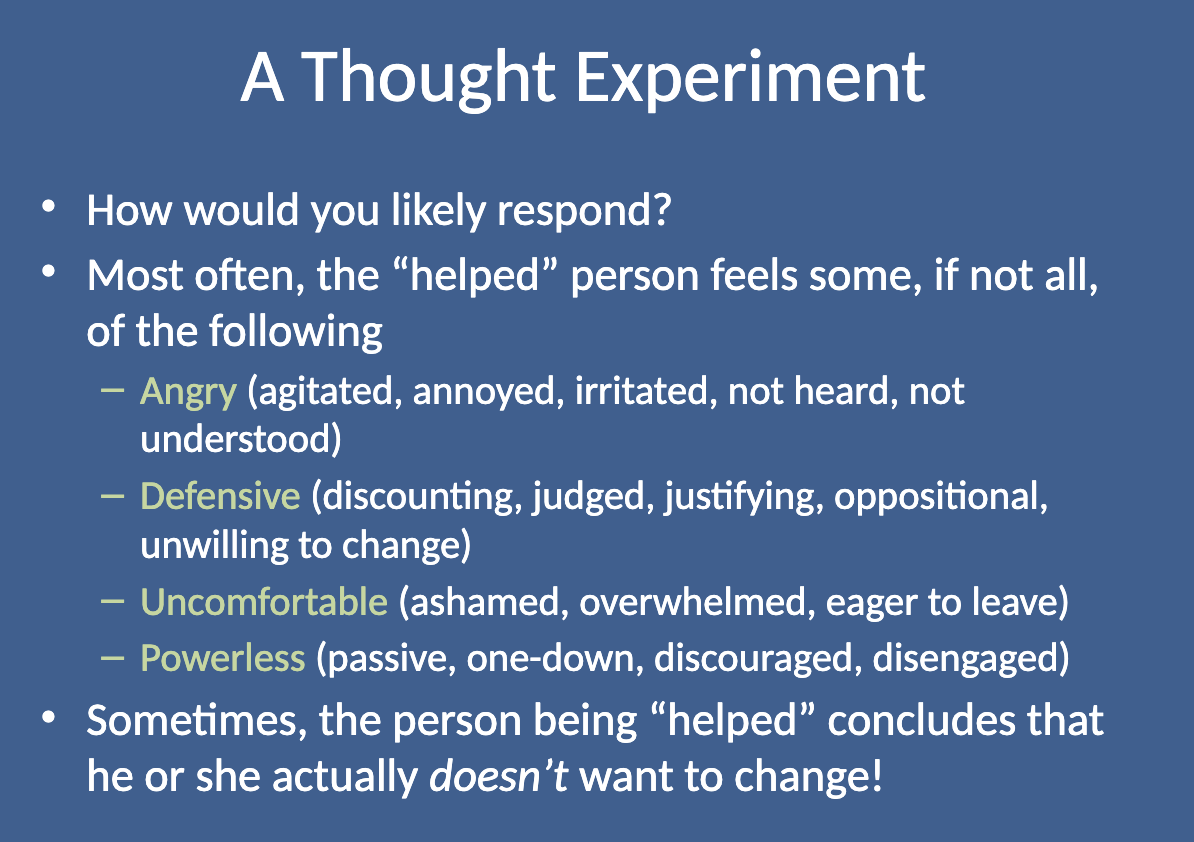
Why would someone feel angry, defensive, uncomfortable, or powerless in response to a helper’s approach? (A Thought Experiment)
These reactions happen because the "helped" person may feel judged, misunderstood, or pushed into a change they aren’t ready for. The helper’s directive approach often creates resistance, leading to these emotional responses.
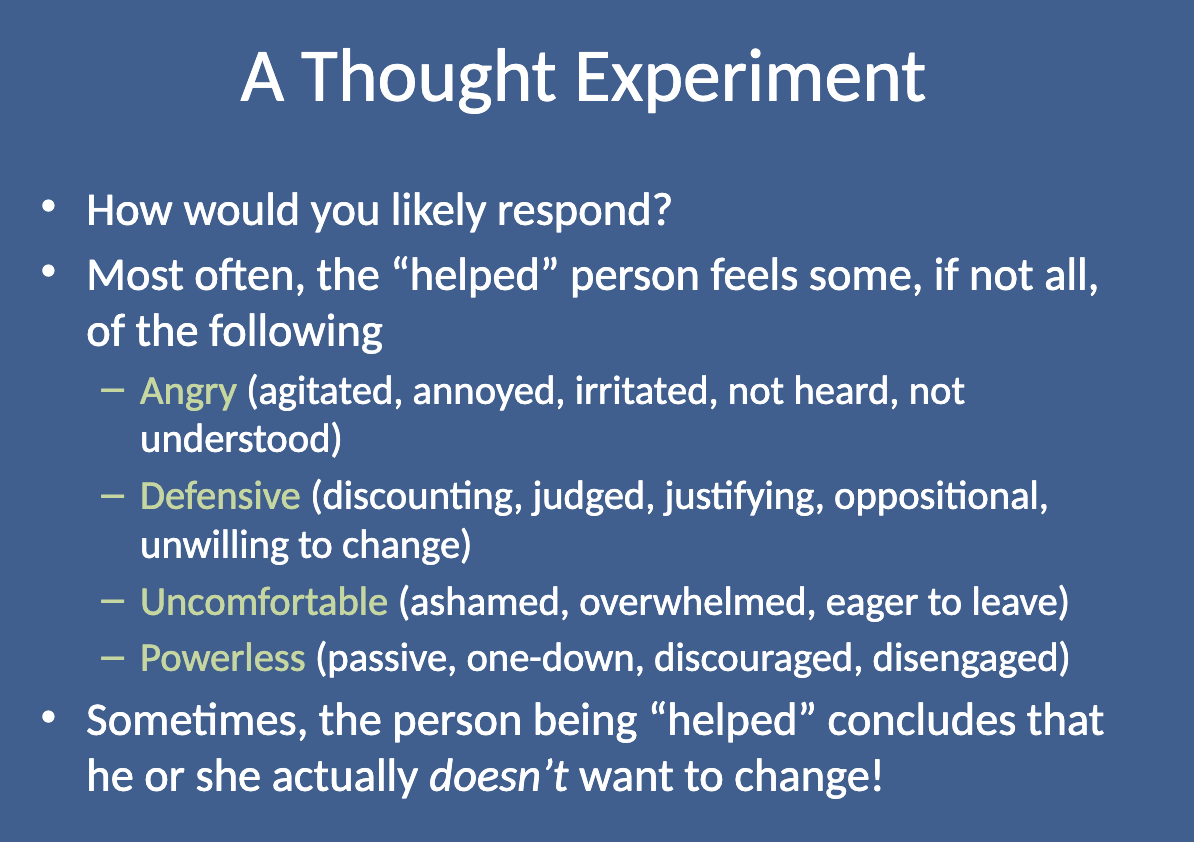
What is the second thought experiment in the context of change? (A(nother)Thought Experiment)
The second thought experiment involves imagining a situation where your friend listens respectfully and asks a series of open-ended questions without giving advice. The questions help you explore your reasons for wanting to change and how you might go about it.
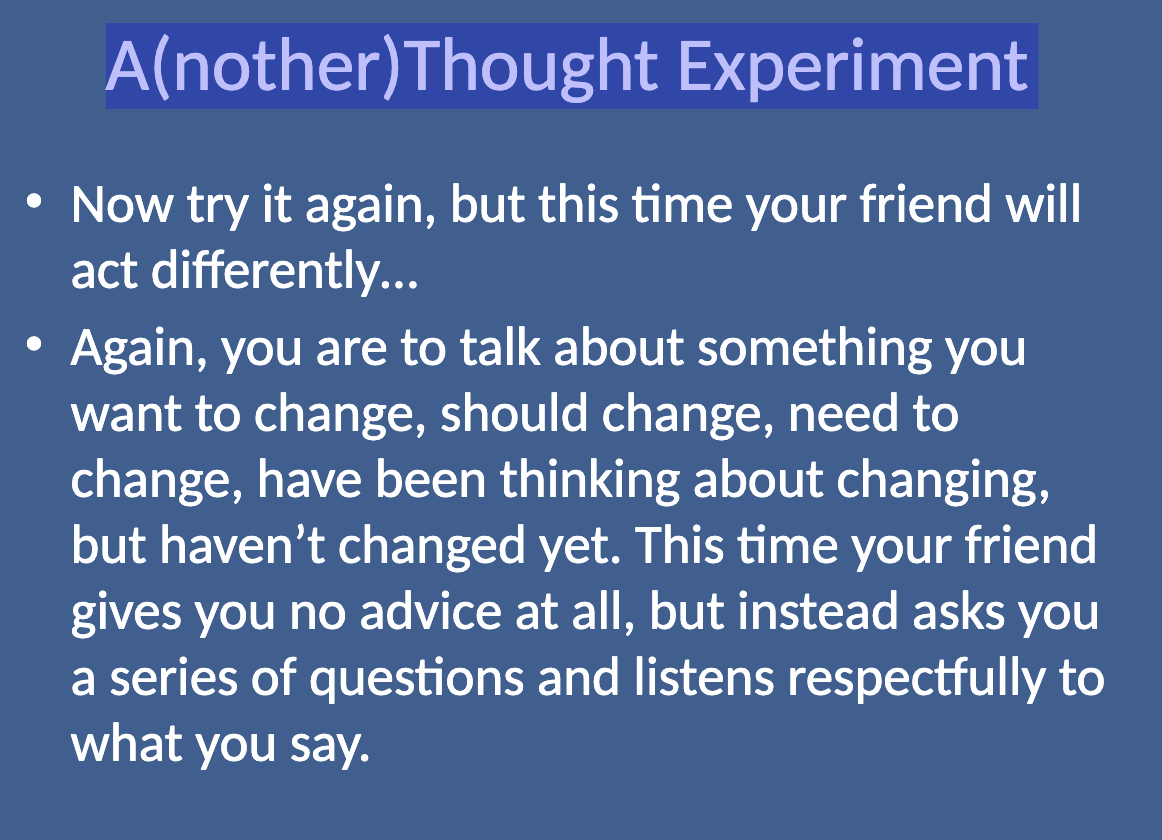
What does the second thought experiment involve, story-wise? (A(nother)Thought Experiment)
In this experiment, you talk about something you want or need to change, but your friend doesn’t give advice. Instead, they ask questions like:
“Why would you want to make this change?”
“How might you go about it to succeed?”
“What are the three best reasons for you to do it?”
“How important is it for you to make this change, and why?”
Your friend then listens and summarizes your reasons and thoughts. Finally, they ask, “So, what do you think you’ll do?”
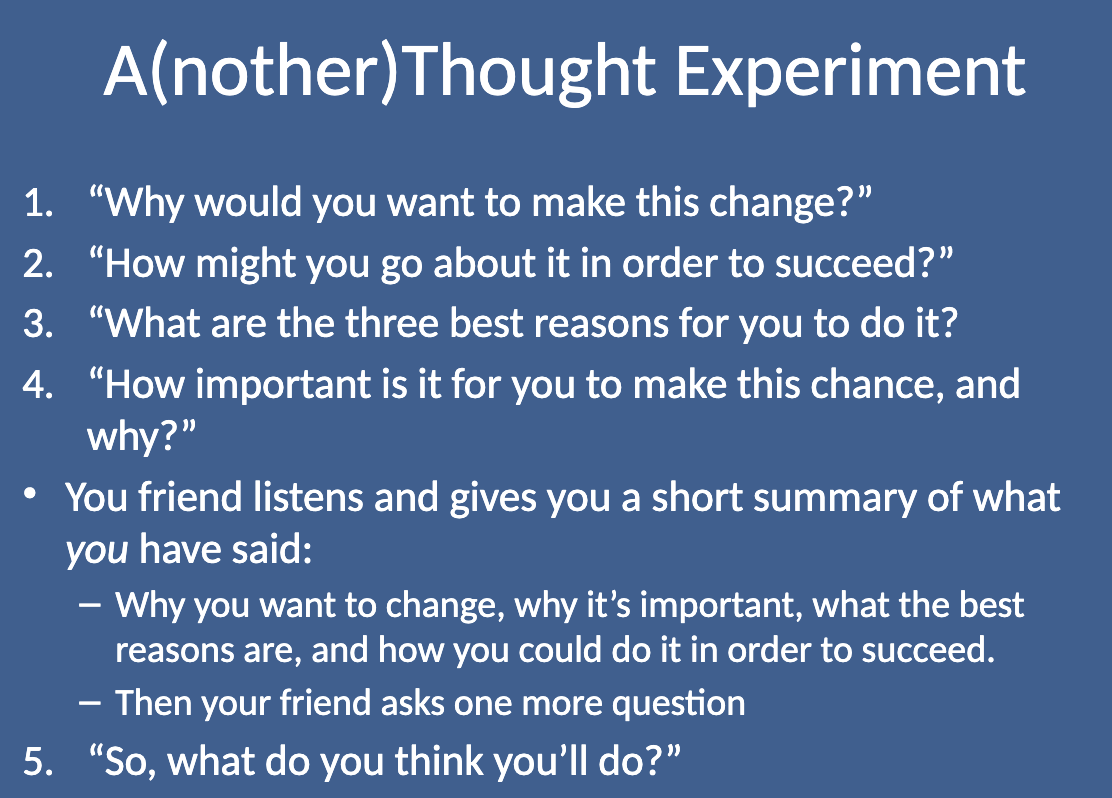
What is the "That's it" moment in the second thought experiment? (A(nother)Thought Experiment)
The "That's it" moment is when your friend finishes summarizing what you've said and asks, “So, what do you think you’ll do?” There is no further explanation, advice, or intervention, just a reflective summary and a question to prompt your next steps.

How would the "helped" person likely respond in this second thought experiment? (A(nother)Thought Experiment)
The "helped" person would most often feel:
Engaged (interested, cooperative, ready to keep talking)
Empowered (feeling able to change, hopeful, optimistic)
Open (feeling accepted, comfortable, safe, and respected)
Understood (feeling connected, heard, and listened to)

What do the four responses (engaged, empowered, open, understood) present as? (A(nother)Thought Experiment)
Engaged: The person is interested and ready to continue the conversation, feeling that their input is valued.
Empowered: The person feels capable of making changes, with a sense of hope and optimism about their ability to succeed.
Open: The person feels accepted and respected, leading to a comfortable and safe environment for exploring change.
Understood: The person feels truly heard and connected, fostering a sense of mutual respect and trust in the relationship.
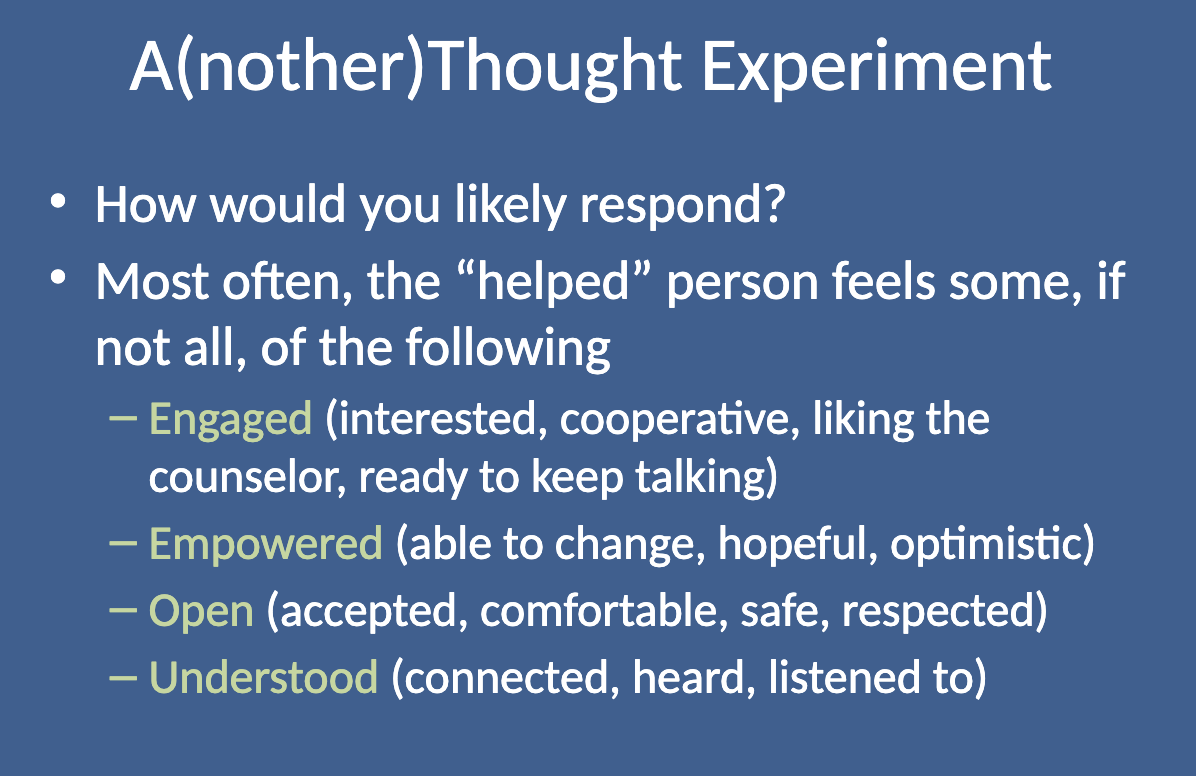
Is the subject of conversation the same or different in both thought experiments? (These Two Thought Experiments)
The subject of conversation is the same in both thought experiments — a possible change characterized by ambivalence.
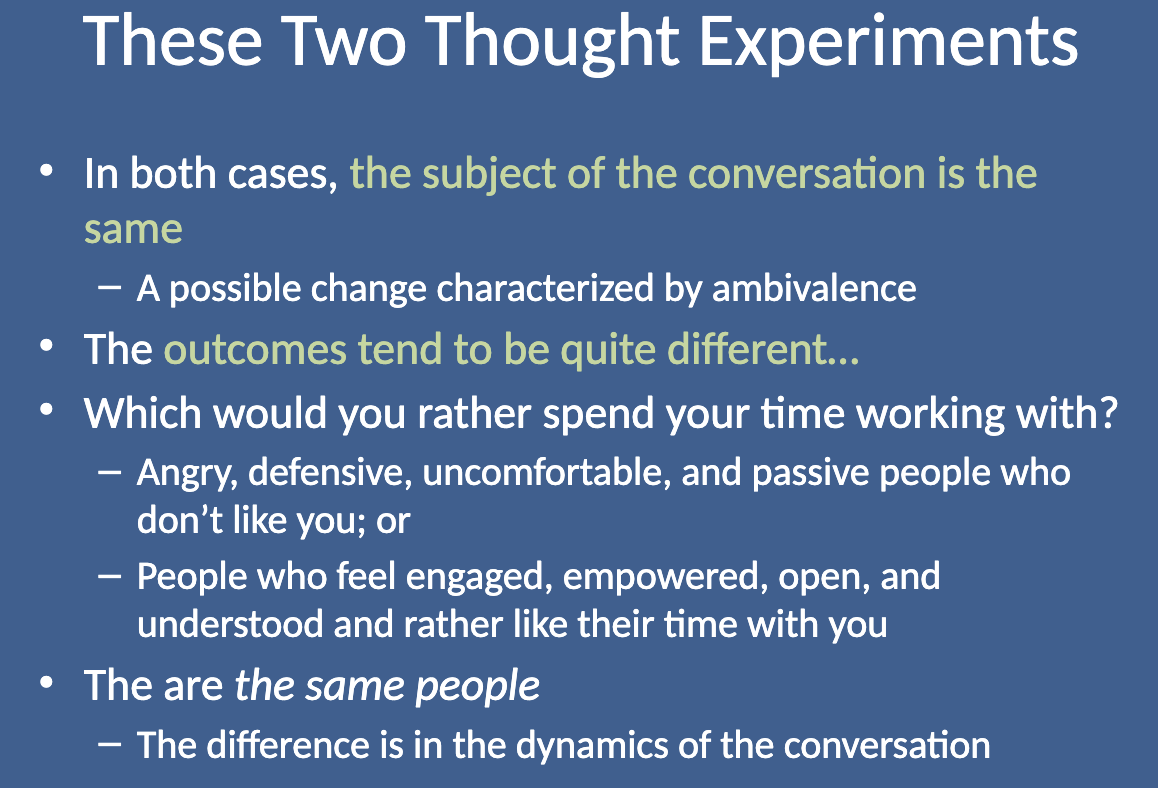
What is the subject of conversation in both thought experiments? (These Two Thought Experiments)
The subject of conversation is a possible change that the person is ambivalent about, meaning they both want to change and don’t want to change at the same time.
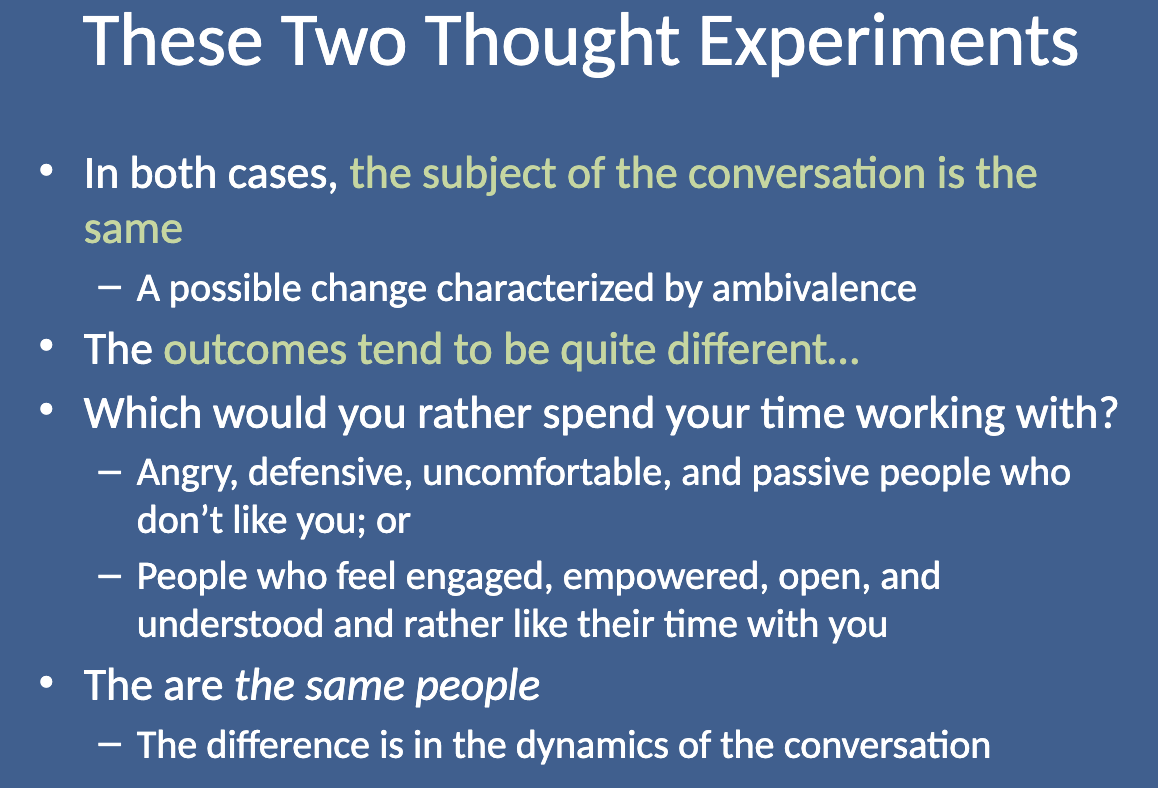
Are the outcomes the same or different in the two thought experiments? (These Two Thought Experiments)
The outcomes are different in the two thought experiments.
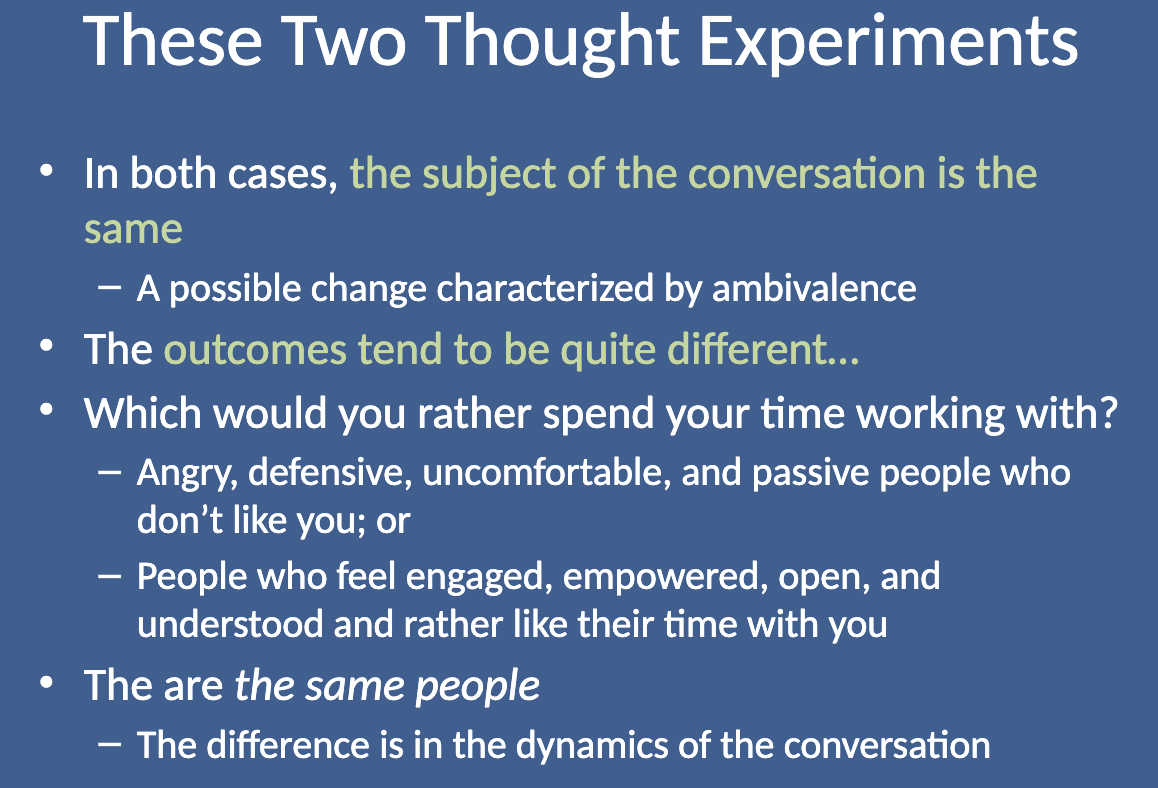
How are the outcomes different in the two thought experiments? (These Two Thought Experiments)
In the first experiment, the person feels angry, defensive, uncomfortable, and passive, often leading to resistance. In the second experiment, the person feels engaged, empowered, open, and understood, leading to greater cooperation and readiness for change.
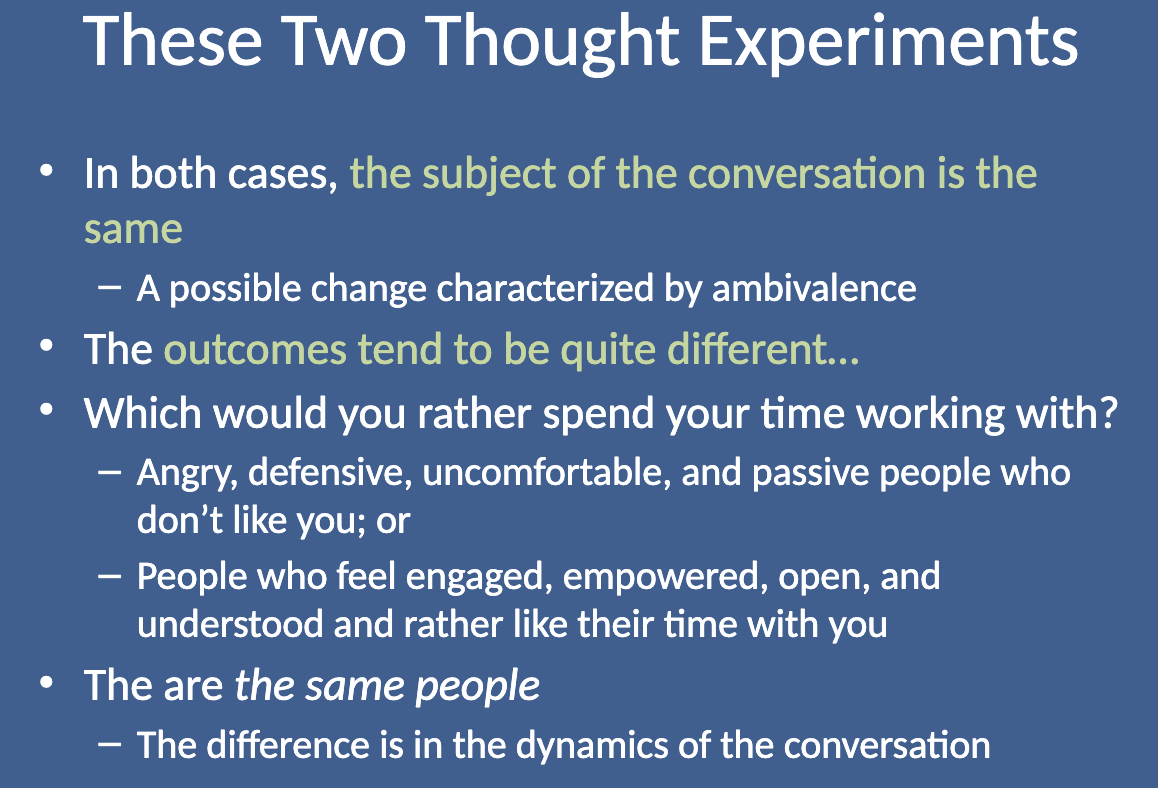
What type of style is Motivational Interviewing (MI) and what does this mean? (A Beginning Definition)
Motivational Interviewing is a collaborative conversation style, meaning it involves working together with the person to explore change, rather than directing or advising them. It aims to strengthen the person’s own motivation and commitment to change.
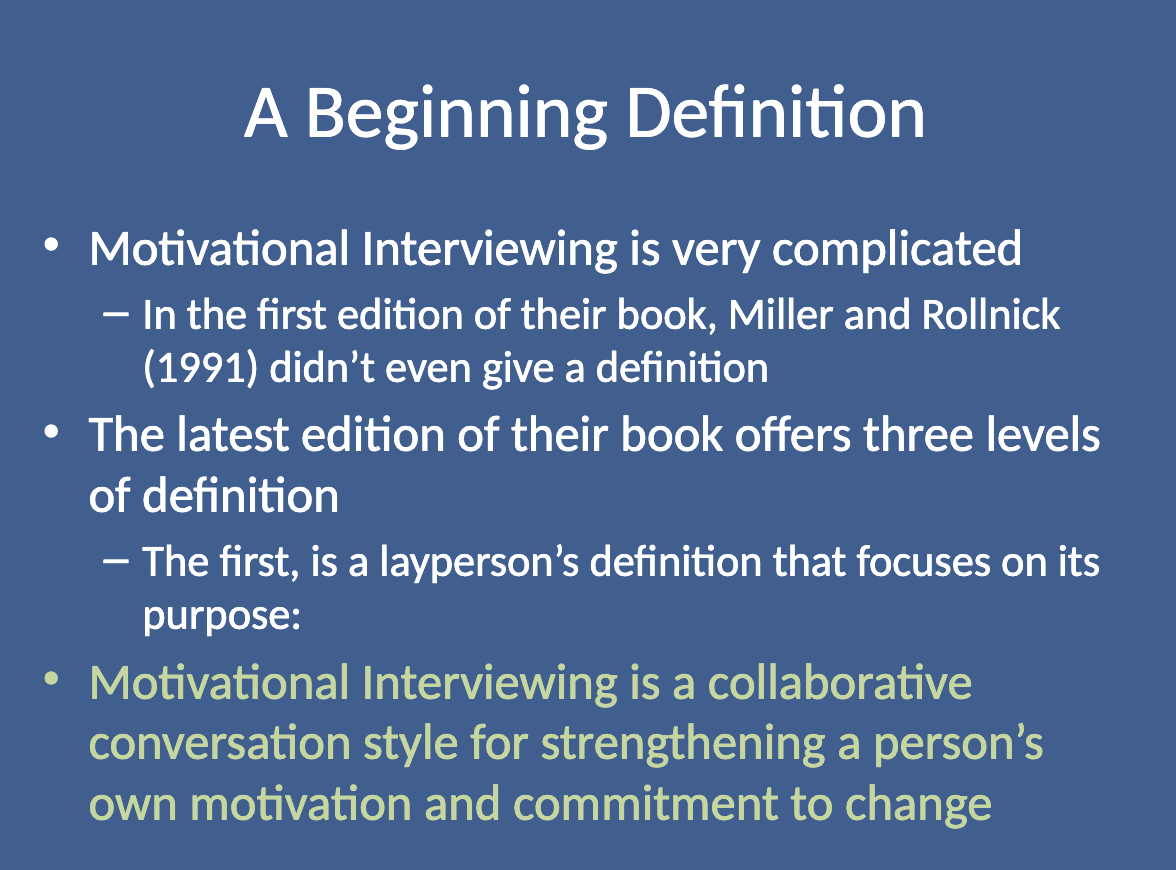
What is the conversation about in Motivational Interviewing (MI)? (A Beginning Definition)
The conversation in Motivational Interviewing is always about change — specifically, helping the person strengthen their own motivation and commitment to make a change.
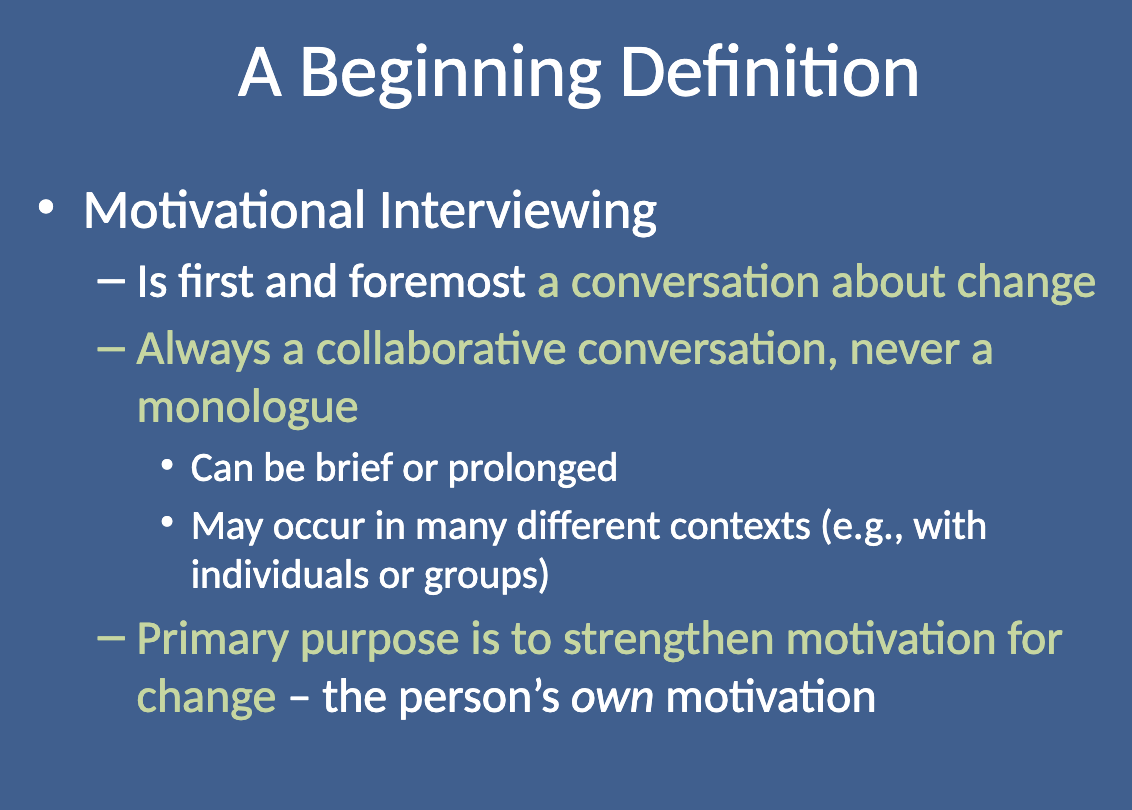
What is Motivational Interviewing never about, and what does this mean? (A Beginning Definition)
Motivational Interviewing is never a monologue. It’s a dialogue, meaning the person’s thoughts and feelings about change are explored collaboratively, not imposed by the helper.
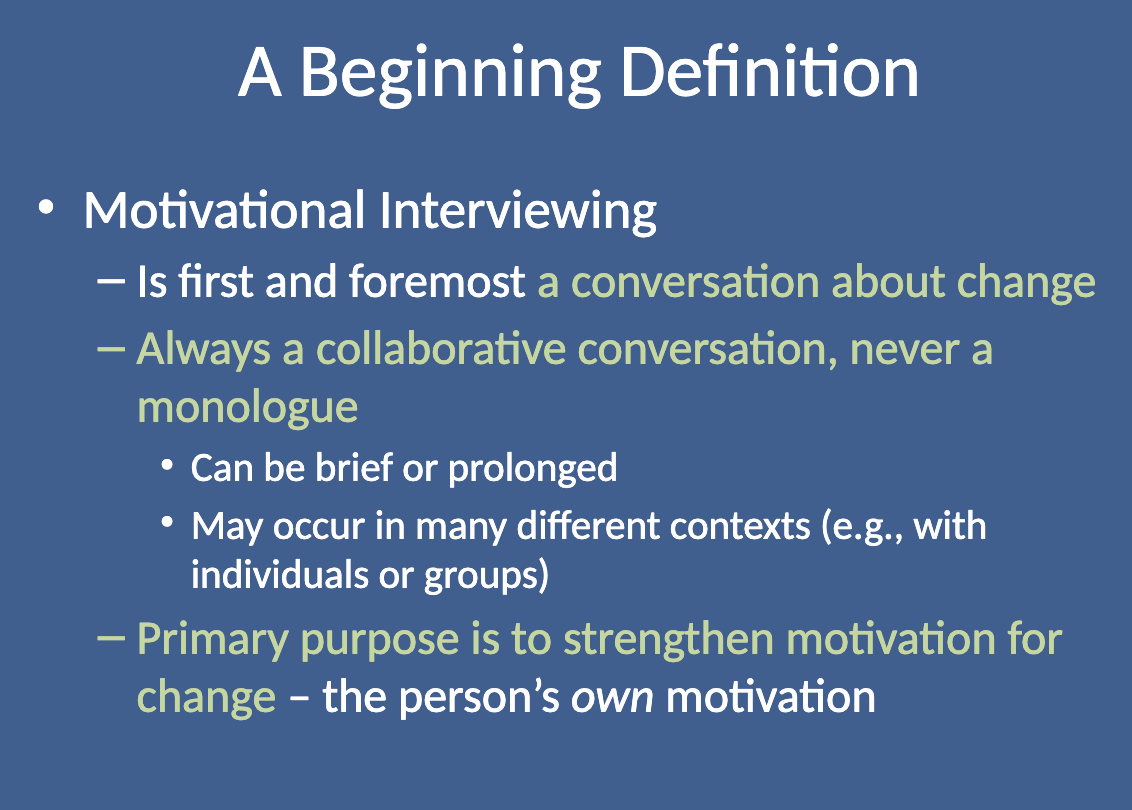
What is the primary purpose of Motivational Interviewing? (A Beginning Definition)
The primary purpose of Motivational Interviewing is to strengthen a person’s motivation for change — specifically, their own motivation, not the helper’s agenda or view.
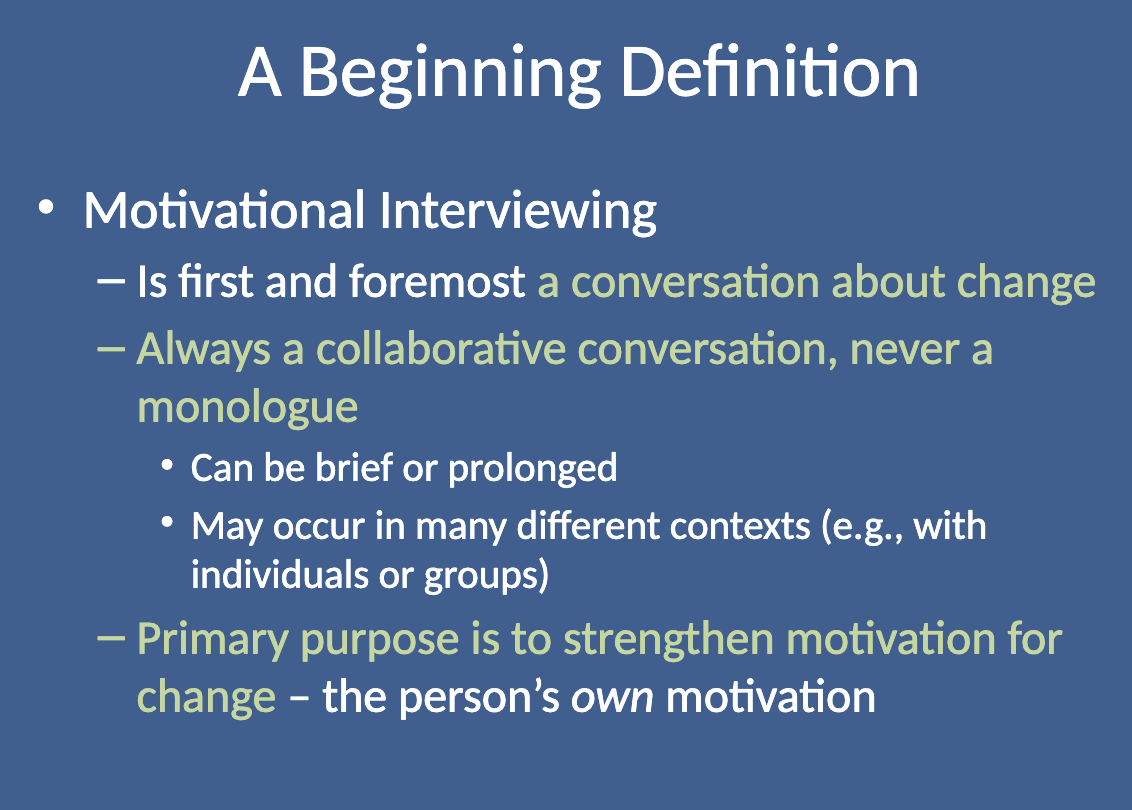
What are the four key elements of the spirit of Motivational Interviewing (MI)? (The Spirit of Motivational Interviewing)
The four key elements are Partnership, Acceptance, Compassion, and Evocation.
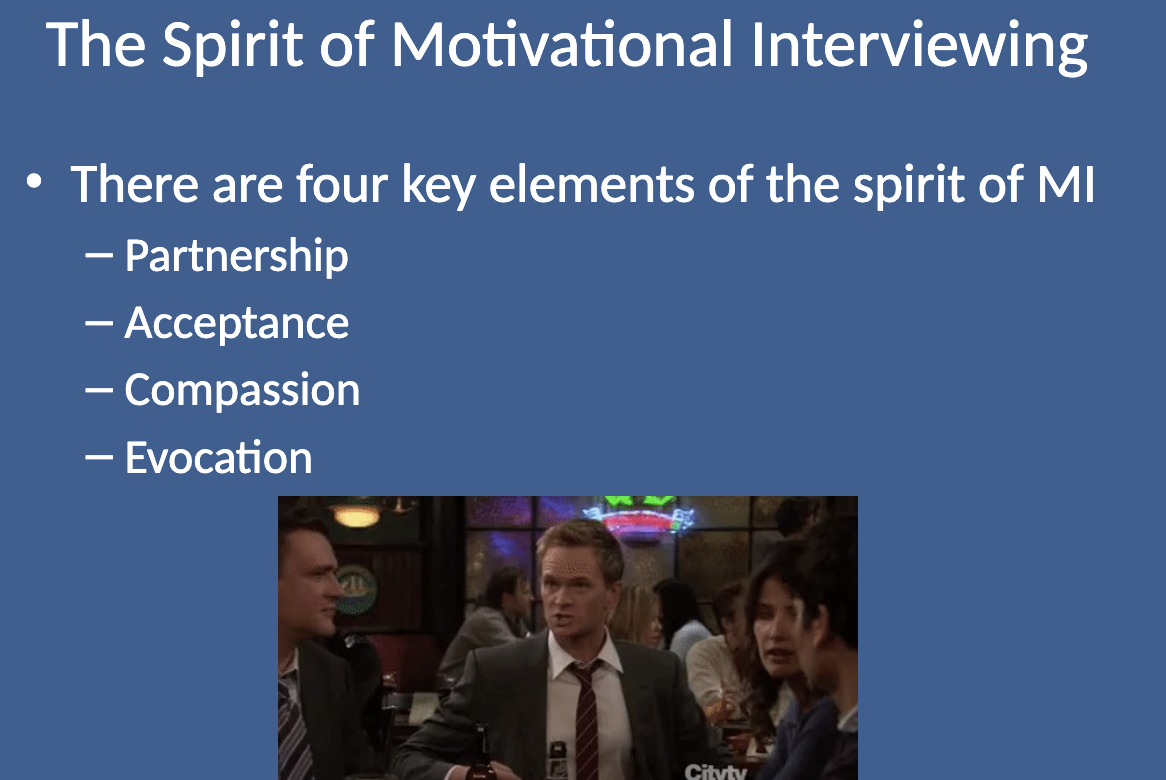
What is the concept of partnership in Motivational Interviewing (MI)? (The Spirit of Motivational Interviewing)
Partnership in MI means it’s an active collaboration between the helper and the client. It’s not about the helper being the expert, but about working together. The client is the expert on their own life, and the helper is a companion in the process.
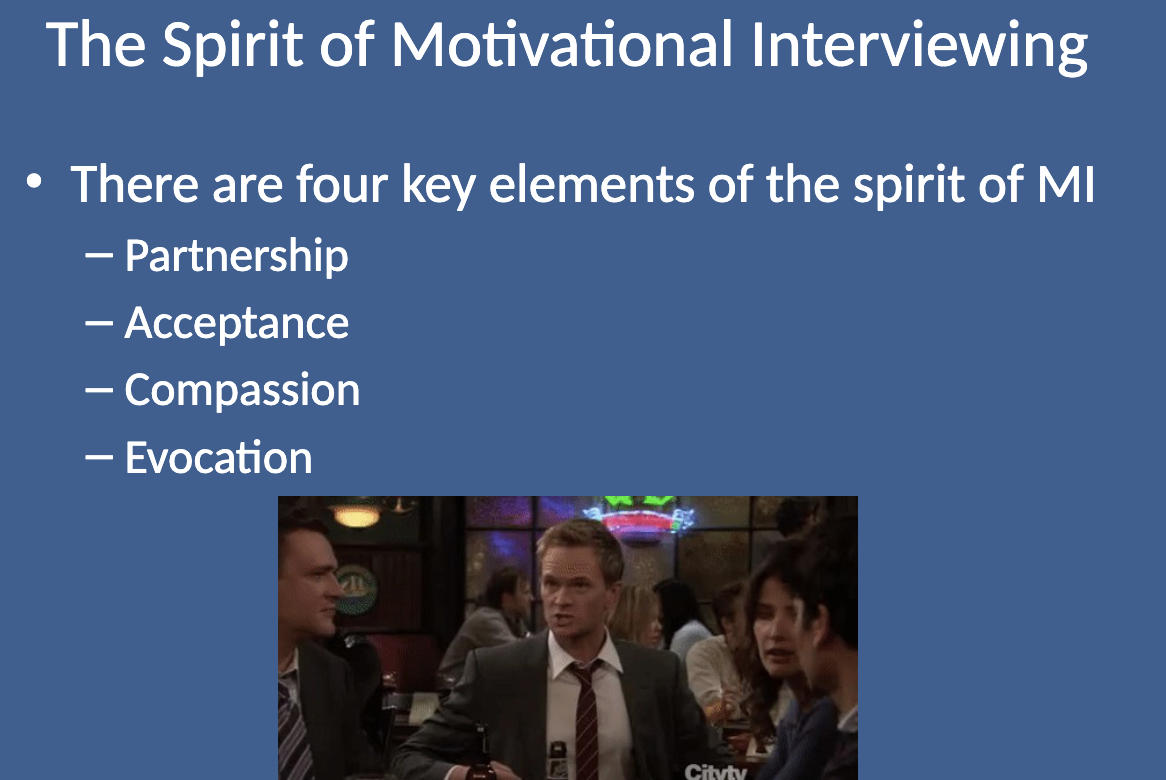
What does acceptance mean in Motivational Interviewing (MI)? (The Spirit of Motivational Interviewing)
Acceptance in MI involves four aspects:
Absolute worth — prizing the inherent value of every person.
Accurate empathy — understanding and reflecting the person's meaning.
Autonomy support — respecting the person’s right to self-determination.
Affirmation — acknowledging strengths and efforts.
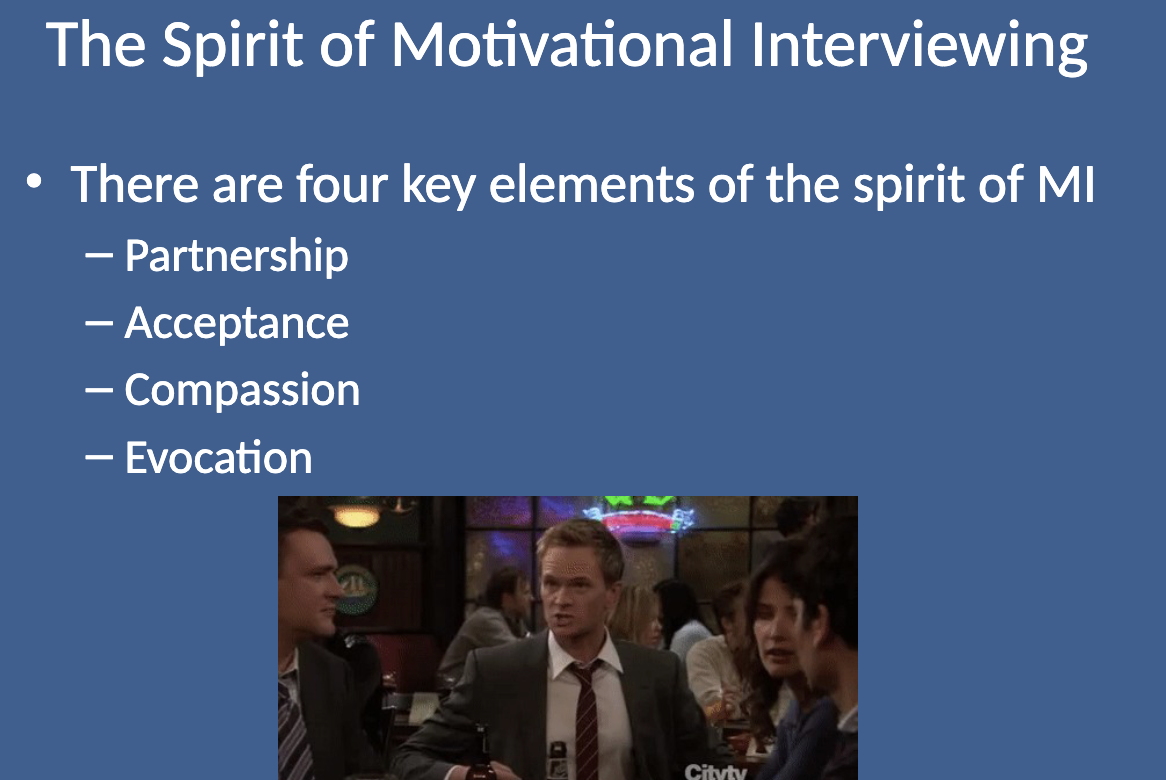
What does compassion mean in Motivational Interviewing (MI)? (The Spirit of Motivational Interviewing)
Compassion in MI means actively promoting the other person’s welfare and giving priority to their needs. It’s a deliberate commitment to pursuing the other’s best interests.
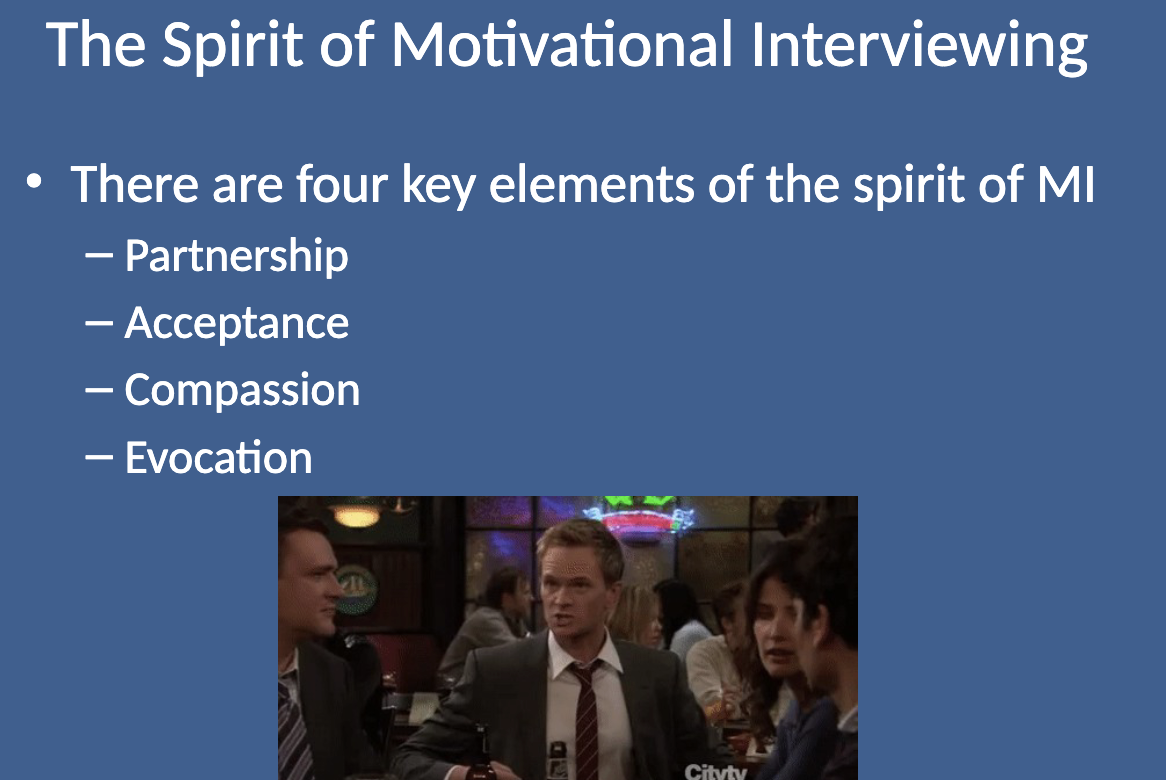
What does evocation mean in Motivational Interviewing (MI)? (The Spirit of Motivational Interviewing)
Evocation in MI means bringing forth the person’s own strengths, motivations, and resources. It’s about recognizing that people already have much of what they need, and the role of the helper is to evoke and explore these internal resources to help facilitate change.
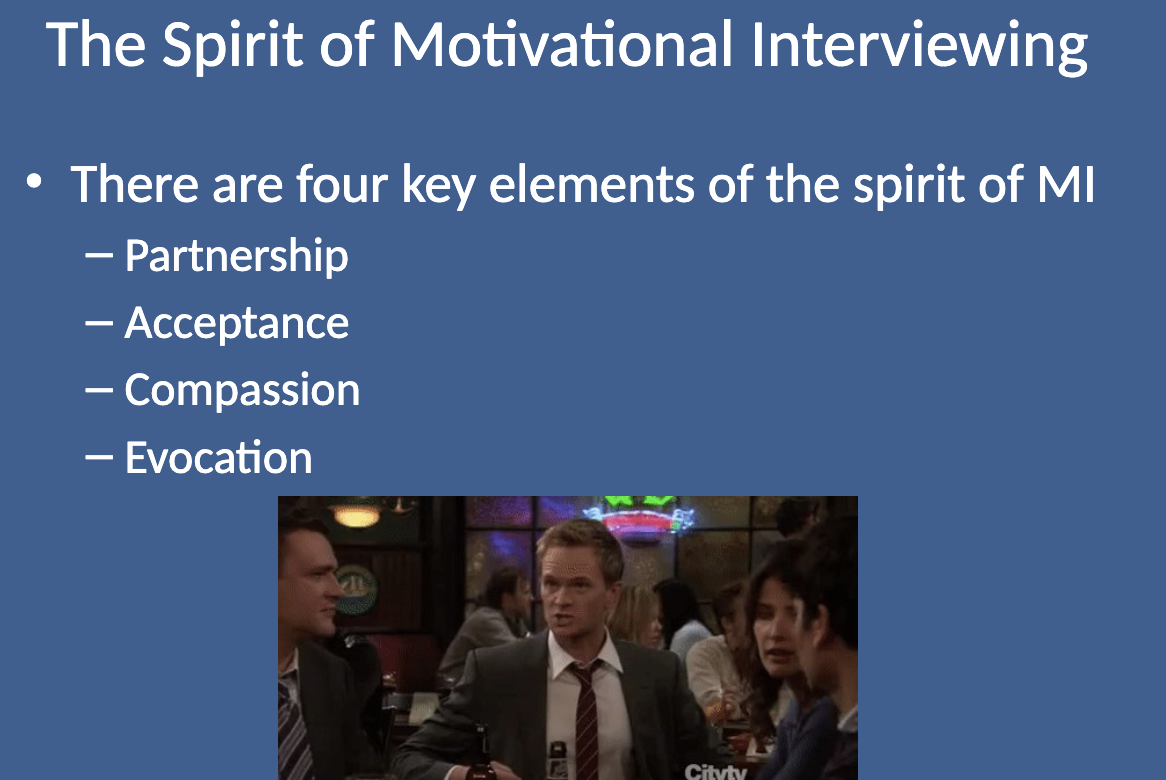
What is Motivational Interviewing (MI) NOT? (Partnership)
MI is not something done by an expert to a passive recipient, a teacher to a pupil, or a master to a disciple. It is not about the helper giving all the answers.

MI is not something done by an expert to a passive recipient, a teacher to a pupil, or a master to a disciple. It is not about the helper giving all the answers. (Partnership)
MI is an active collaboration between experts, where the person is the undisputed expert on themselves. The helper is a companion who engages in a two-way conversation, with the person doing much of the talking.
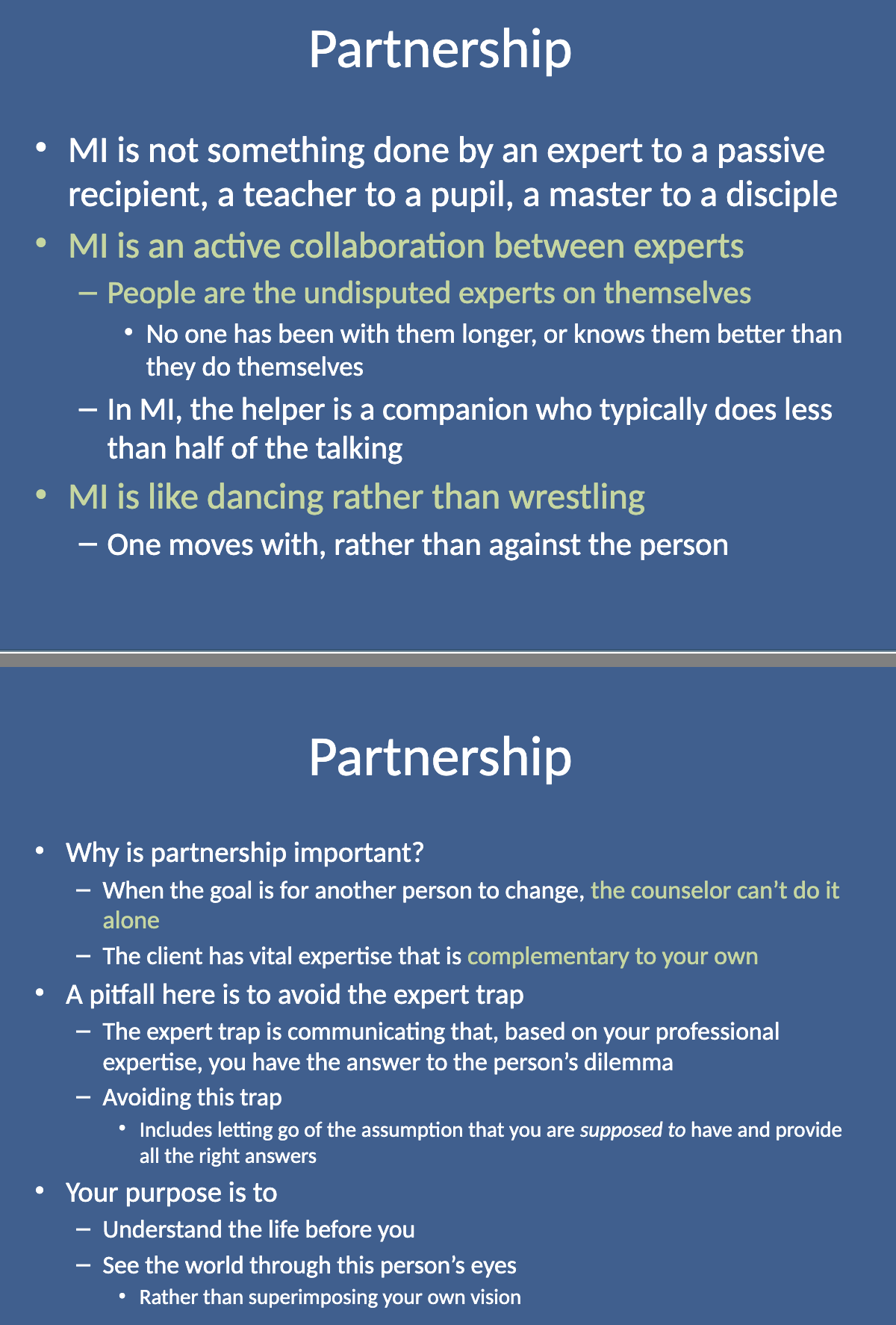
What are people to themselves in Motivational Interviewing (MI)? (Partnership)
People are the undisputed experts on themselves. They have been with themselves longer and know themselves better than anyone else.
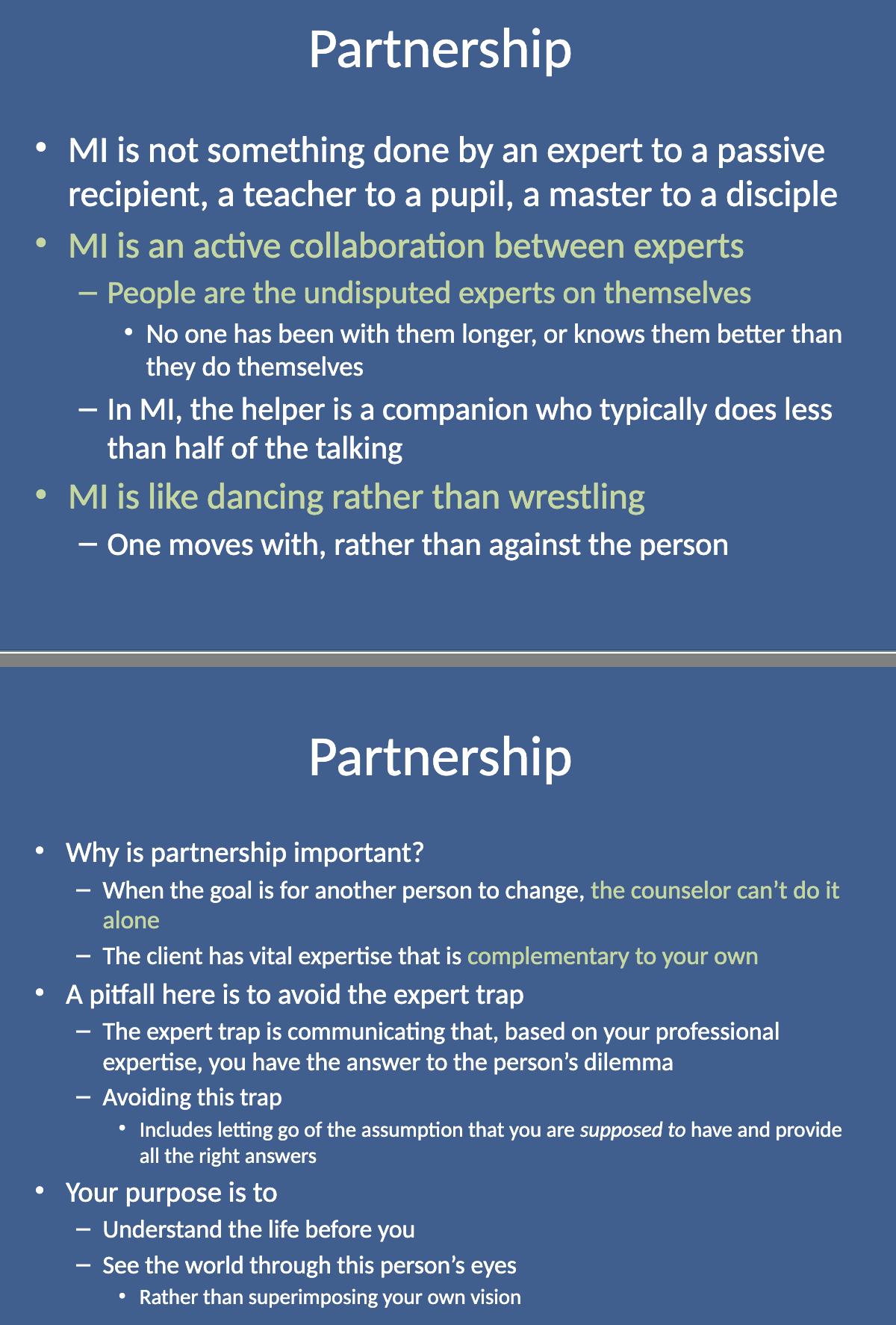
What is MI more like, and what does this mean? (Partnership)
MI is more like dancing than wrestling. This means moving with the person, supporting them in their process, and adapting to their needs, rather than imposing solutions or forcing change.
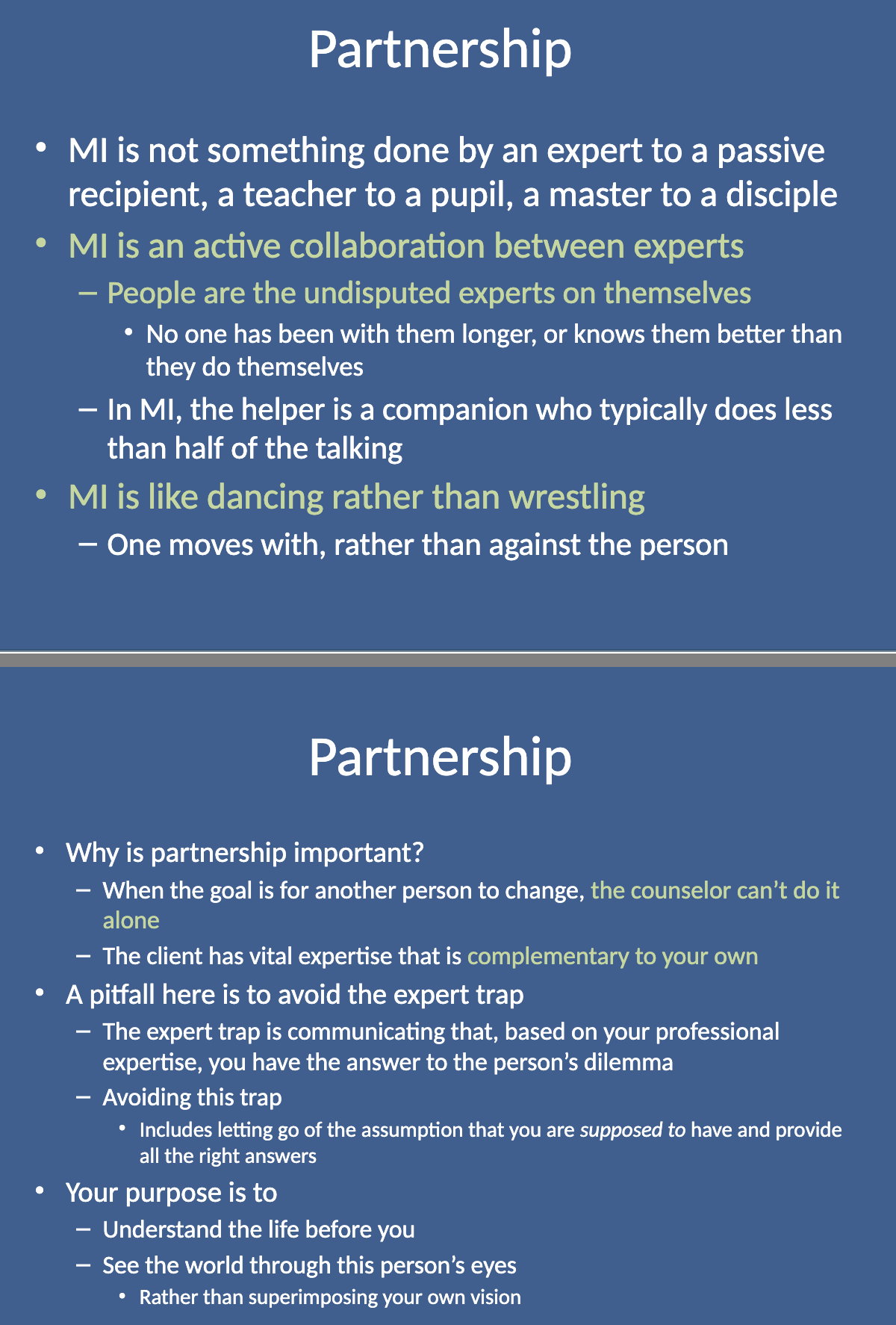
Why is the partnership in MI important? (Partnership)
Partnership is important because the counselor can't make the change alone. The client has vital expertise that complements the counselor's knowledge, making collaboration crucial for success.
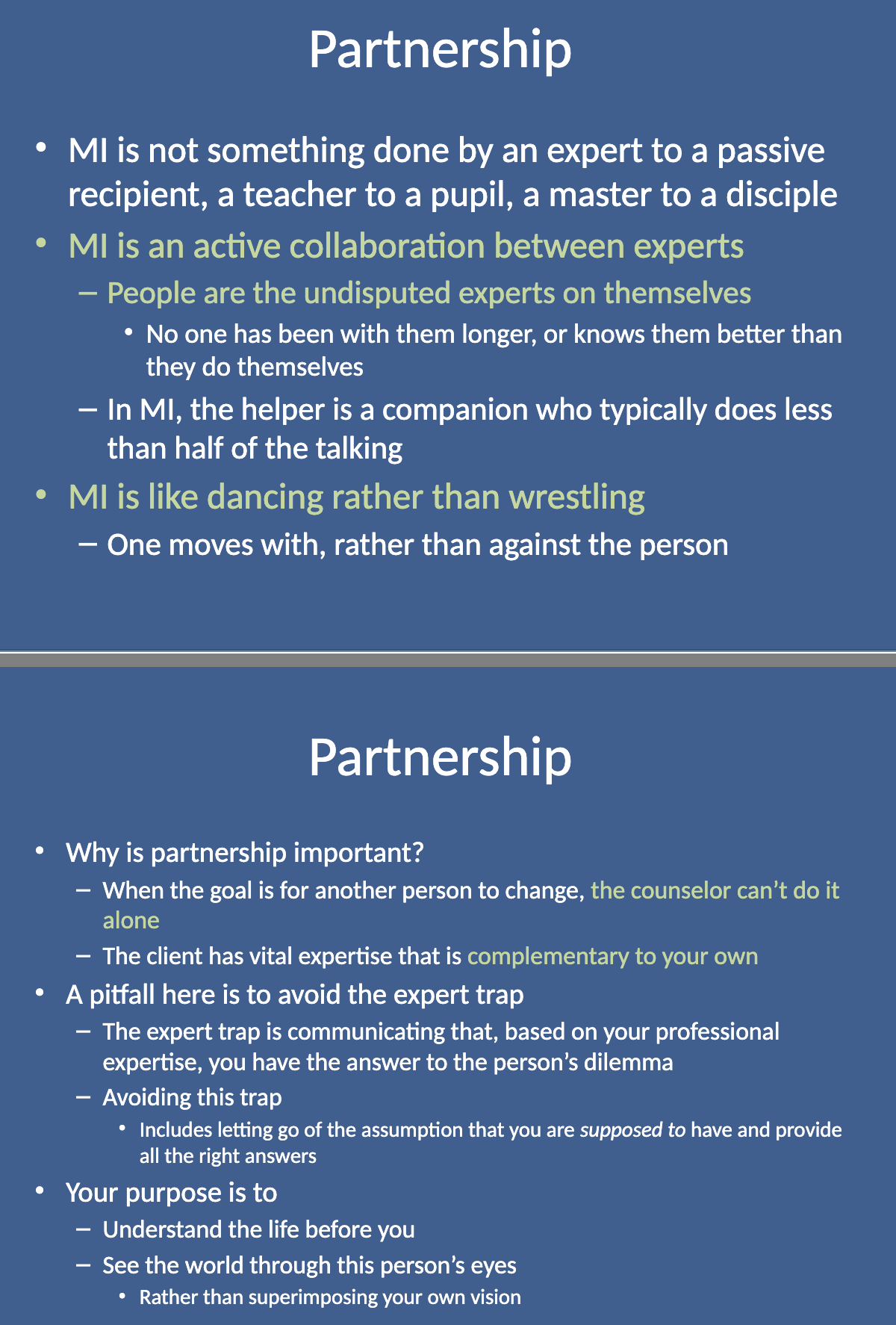
What is the pitfall in Motivational Interviewing (MI)? (Partnership)
The pitfall is the expert trap, where the counselor assumes they have all the answers and imposes their perspective on the client. This prevents true collaboration and mutual understanding.
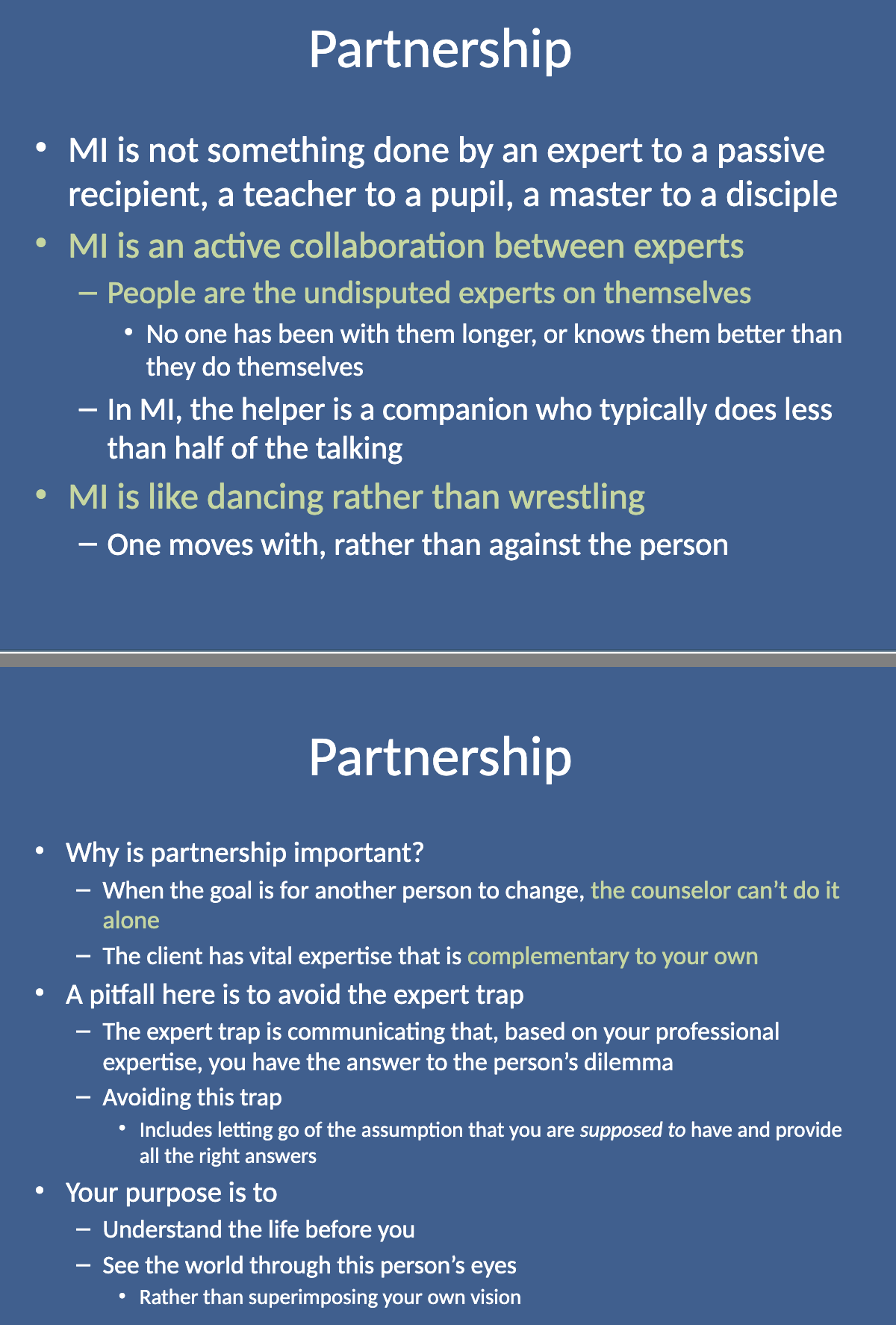
What is the purpose of Motivational Interviewing (MI)? (Partnership)
The purpose of MI is to understand the life of the person before you, see the world through their eyes, and facilitate their self-discovery and change, rather than imposing a vision from the outside.
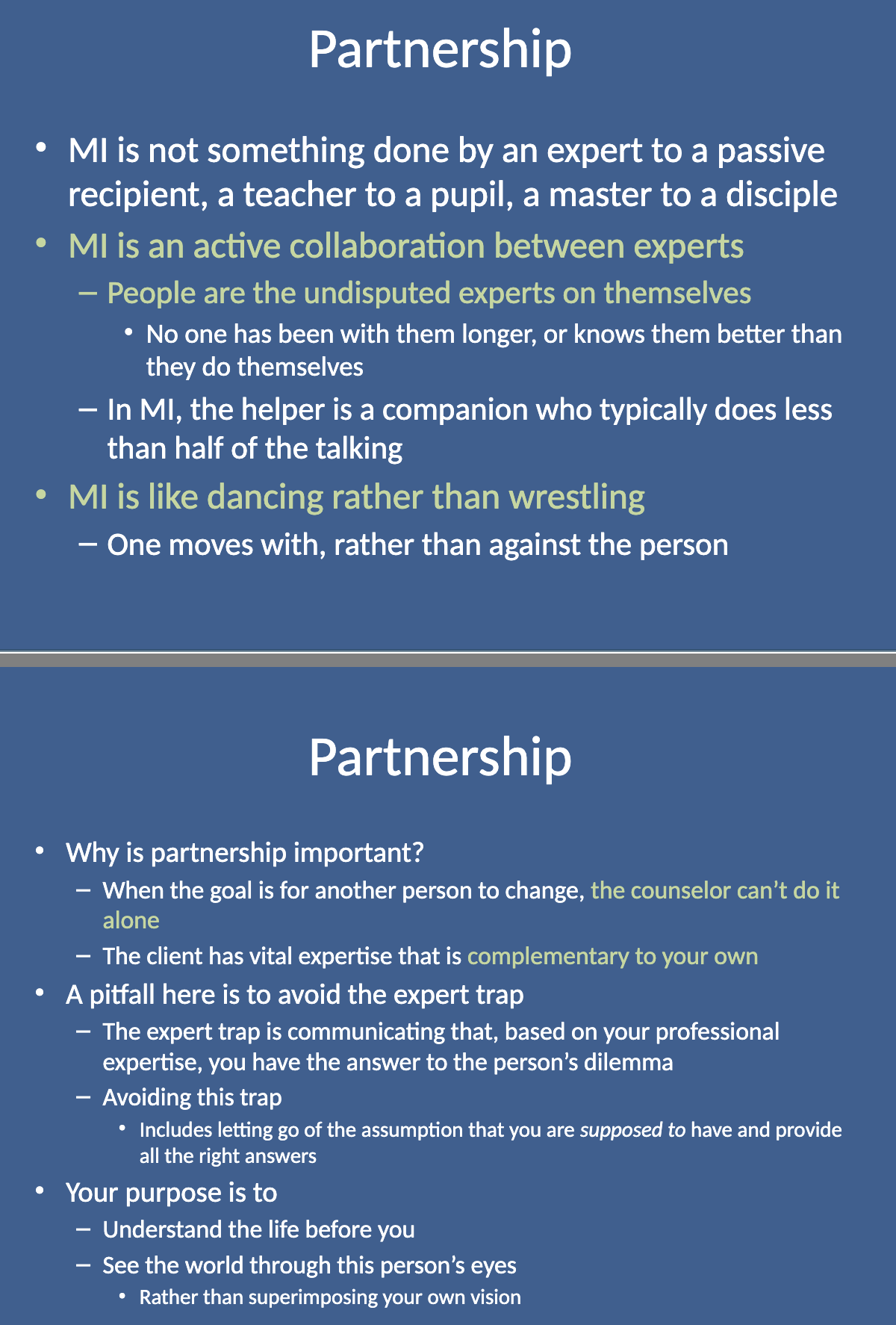
What is Acceptance in Motivational Interviewing? (Acceptance)
Acceptance is a Rogerian principle that involves prizing the inherent value and potential of every person. It is characterized by unconditional positive regard and non-possessive caring, aiming to create a supportive and non-judgmental environment.

What are the four aspects of Acceptance in Motivational Interviewing? (Acceptance)
The four aspects of Acceptance are:
Absolute worth
Accurate empathy
Autonomy support
Affirmation
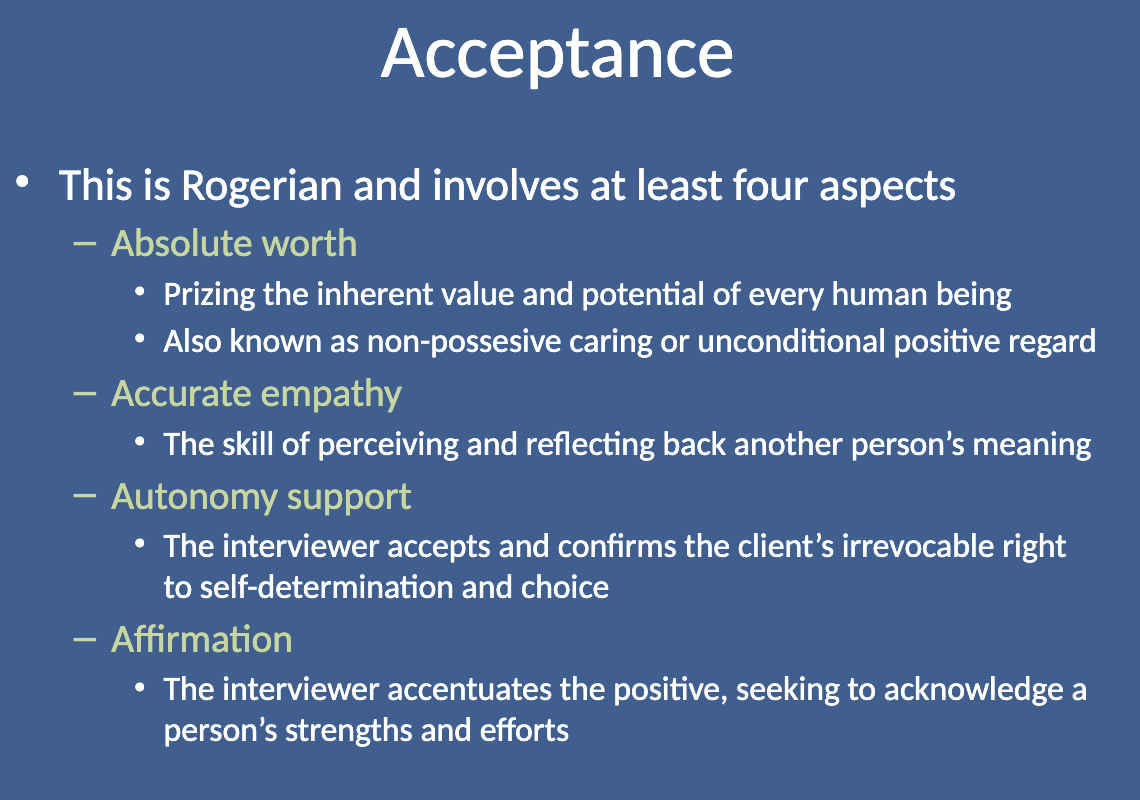
What is Absolute Worth in the context of Acceptance? (Acceptance)
Absolute worth involves prizing the inherent value and potential of every human being. It’s also known as non-possessive caring or unconditional positive regard, where the counselor recognizes and values the person for who they are, without judgment.
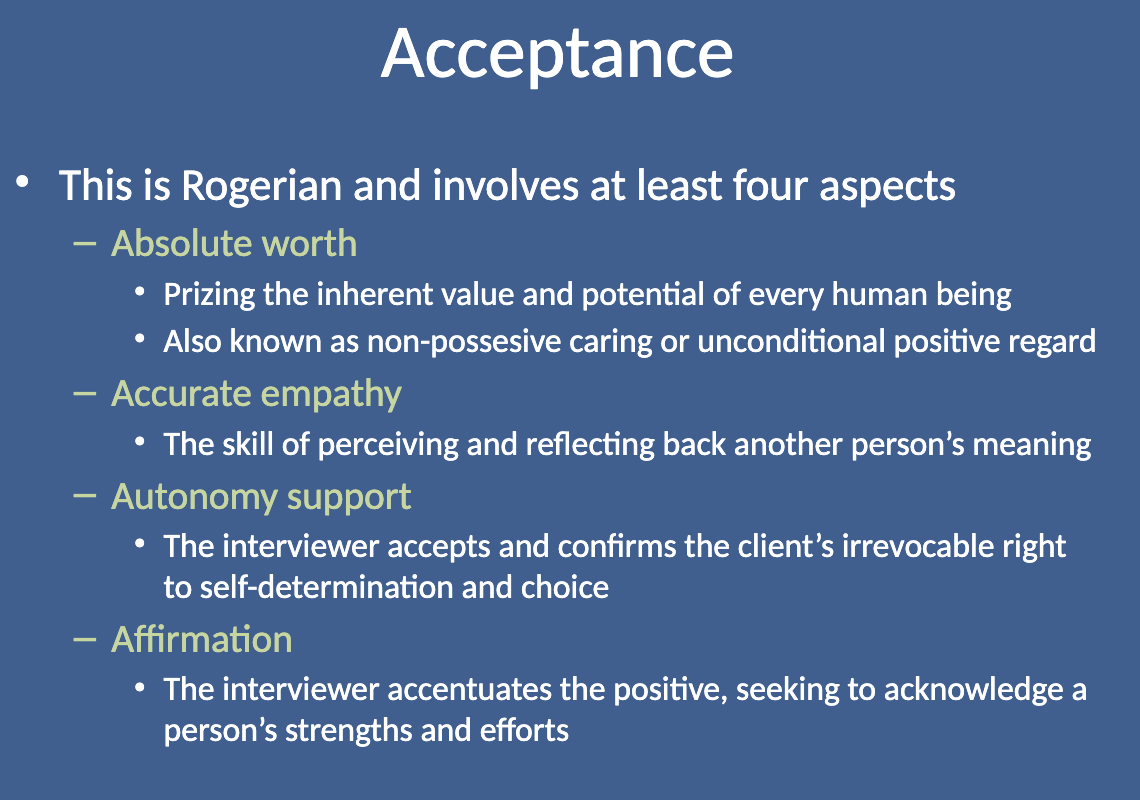
What is Accurate Empathy in the context of Acceptance? (Acceptance)
Accurate empathy is the skill of perceiving and reflecting back another person’s meaning. It involves deeply understanding the client’s perspective and feelings, and showing that understanding through reflective listening.
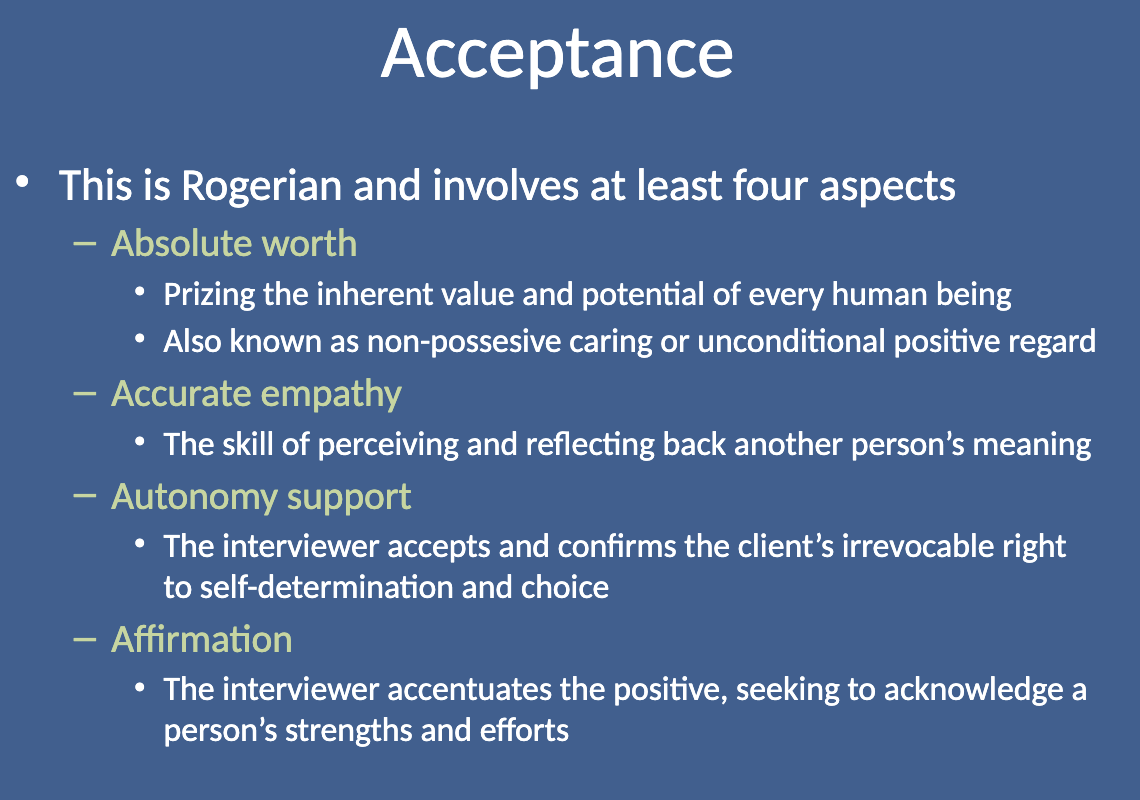
What is Autonomy Support in the context of Acceptance? (Acceptance)
Autonomy support involves accepting and confirming the client’s irrevocable right to self-determination and choice. It acknowledges the client’s ability and right to make their own decisions and fosters a sense of empowerment.
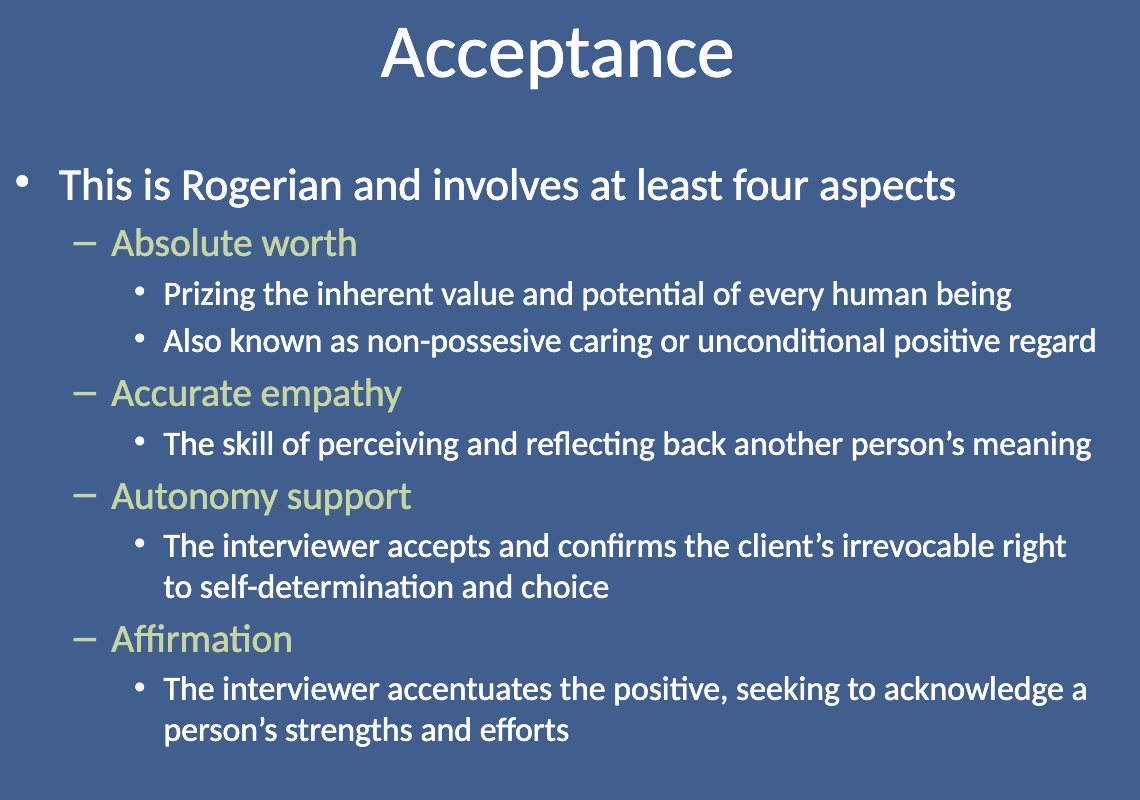
What is Affirmation in the context of Acceptance? (Acceptance)
Affirmation is the act of accentuating the positive. It involves recognizing and acknowledging a person’s strengths, efforts, and progress, helping to build confidence and motivation.

What is Compassion as a factor in Motivational Interviewing? (Compassion)
Compassion involves actively promoting the other person’s welfare and giving priority to their needs. It is a deliberate commitment to pursuing the best interests of the individual being helped.
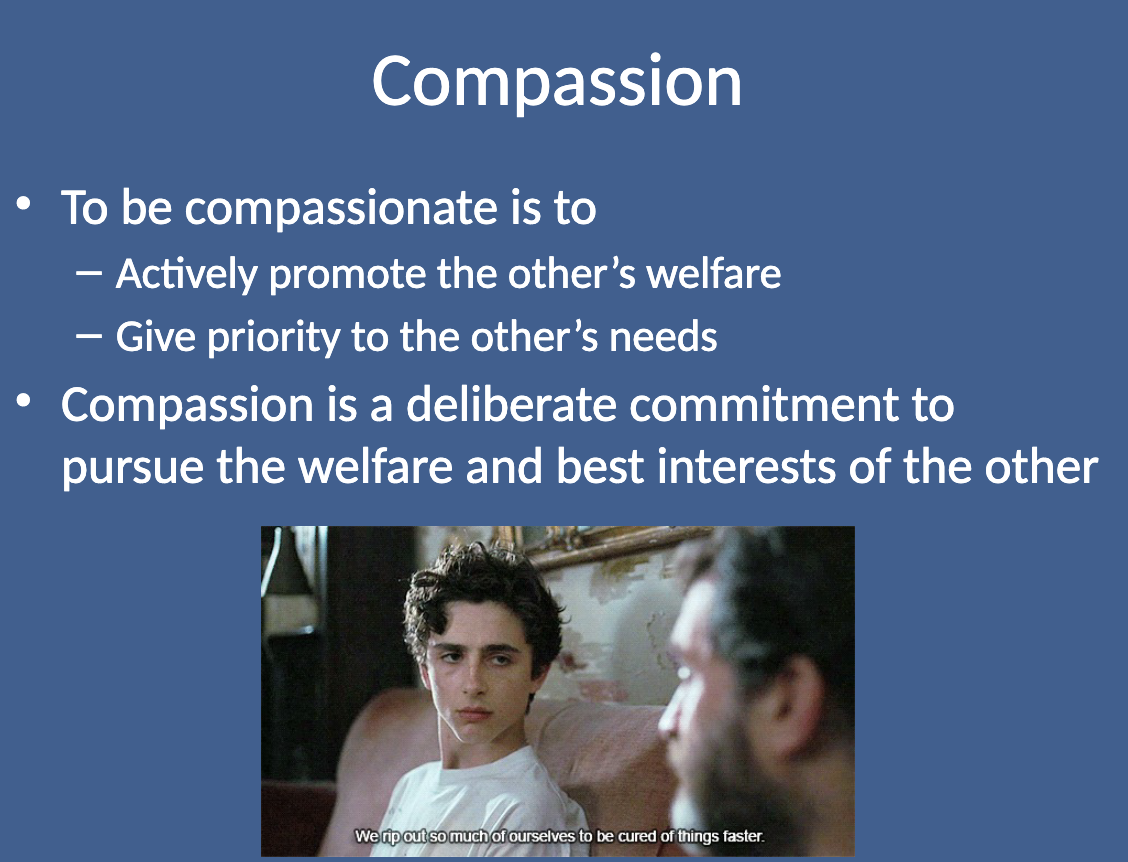
What kind of commitment is Compassion in Motivational Interviewing? (Compassion)
Compassion is a deliberate commitment to actively pursue the welfare and best interests of the other person, ensuring their needs are prioritized in the change process.
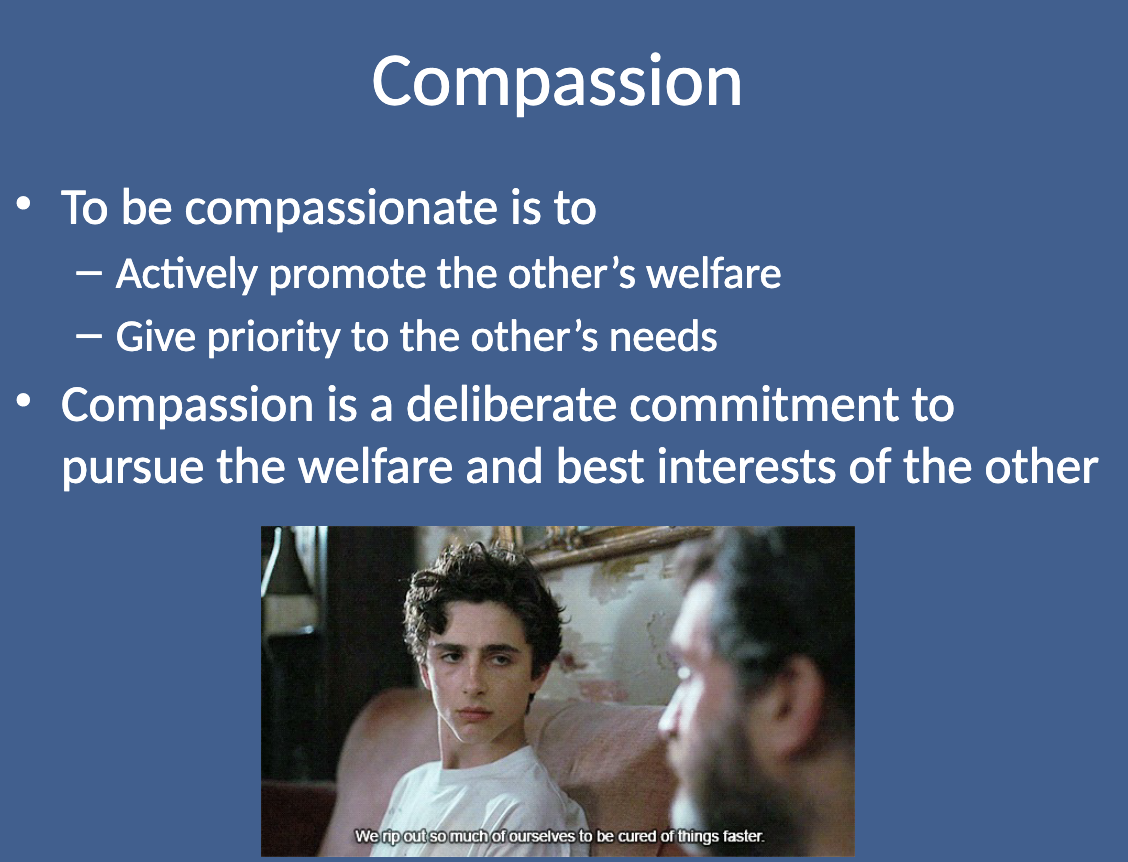
What is Evocation in the context of Motivational Interviewing? (Evocation)
Evocation is the process of calling forth the intrinsic motivation and resources already present in the individual. It involves drawing out the person’s own thoughts, feelings, and abilities rather than imposing solutions.
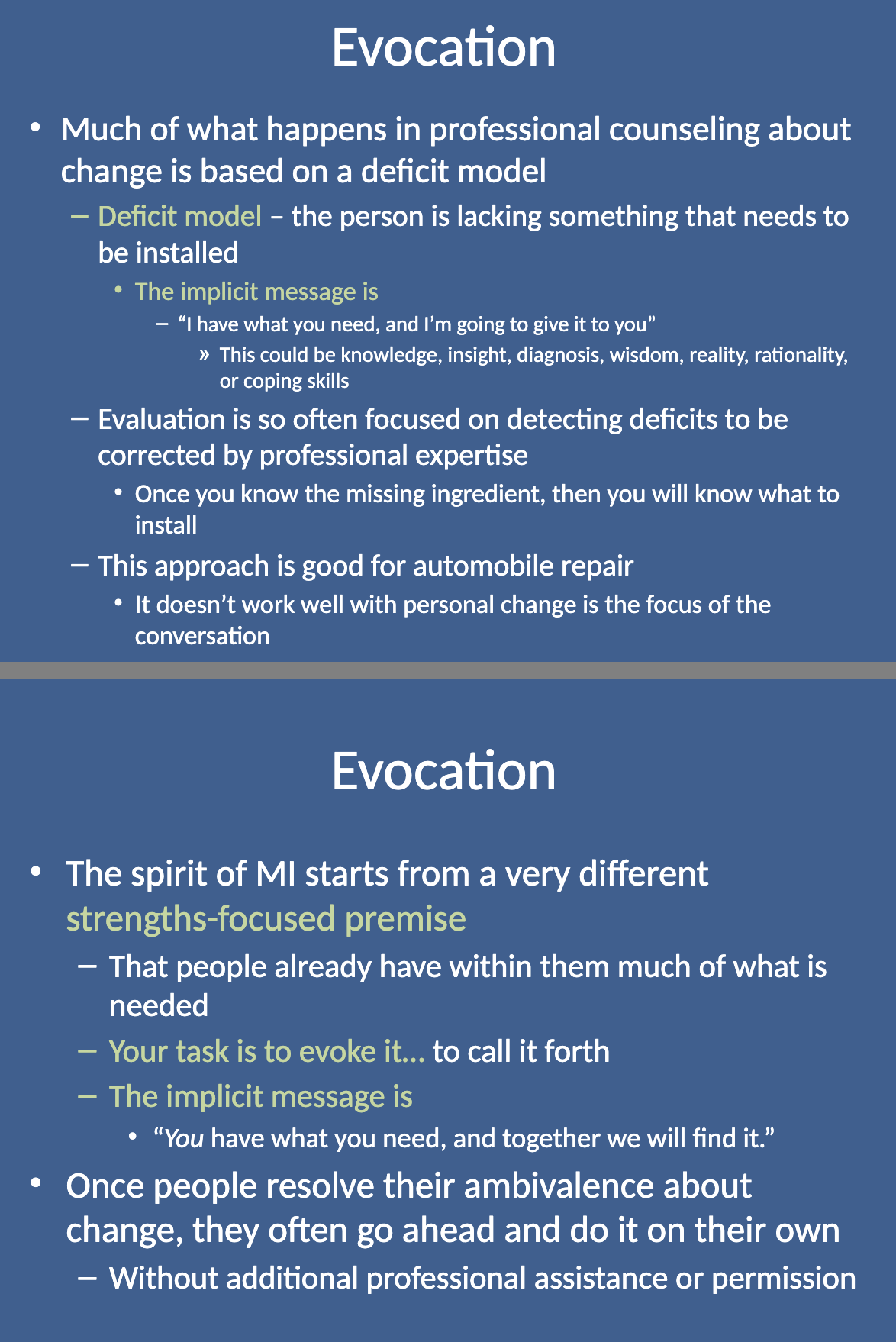
What model is most commonly used in traditional counseling about change? (Evocation)
Traditional counseling is often based on the deficit model, which assumes that the person lacks something that needs to be fixed or installed to make change happen.
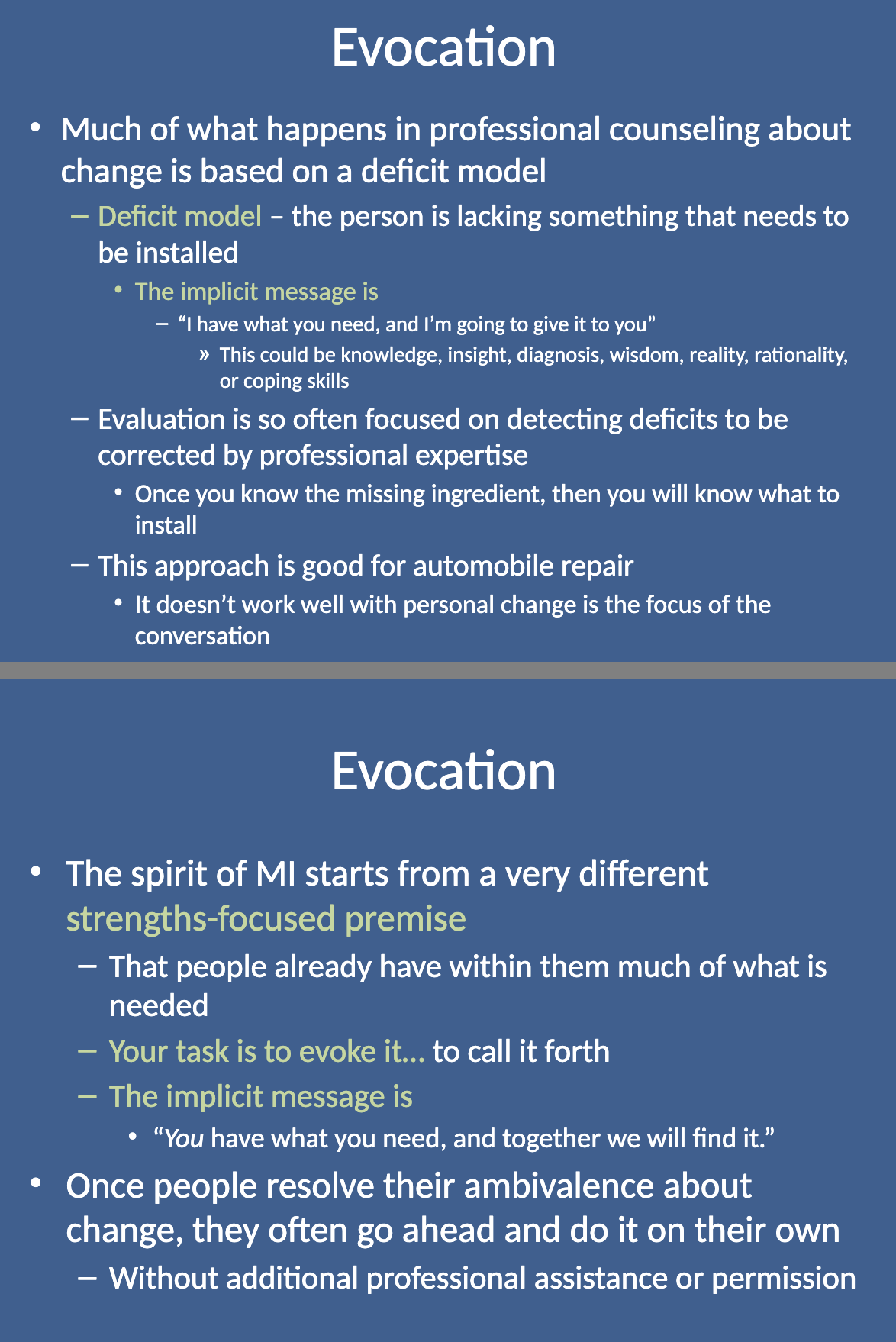
What is the Deficit Model in counseling? (Evocation)
The Deficit Model operates on the assumption that the individual is lacking something, whether it be knowledge, skills, insight, or coping mechanisms, that needs to be provided by the helper to facilitate change.
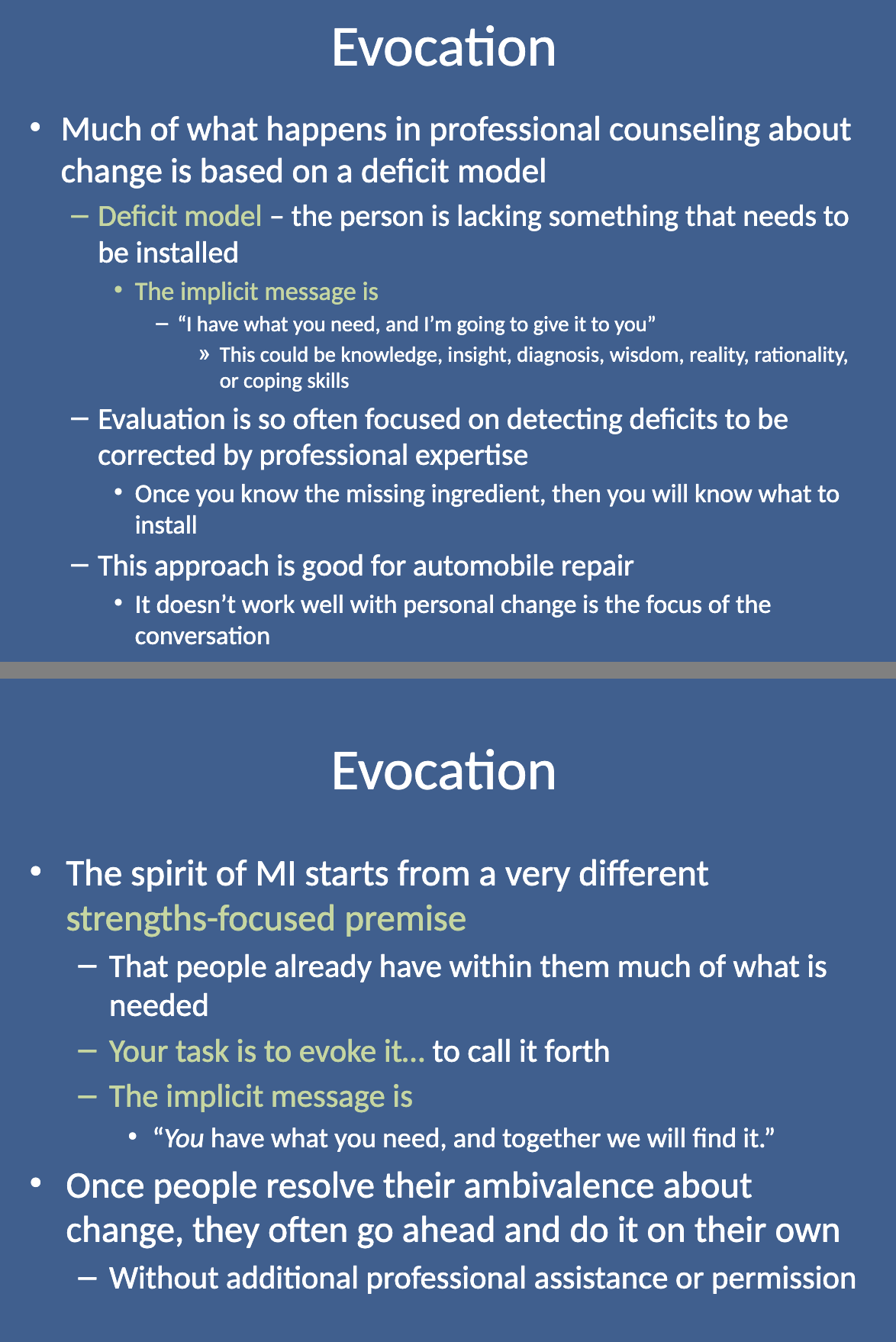
What is the implicit message of the Deficit Model? (Evocation)
The implicit message of the Deficit Model is: “I have what you need, and I’m going to give it to you.” This suggests the counselor or helper is the source of knowledge or solutions, rather than the person themselves.
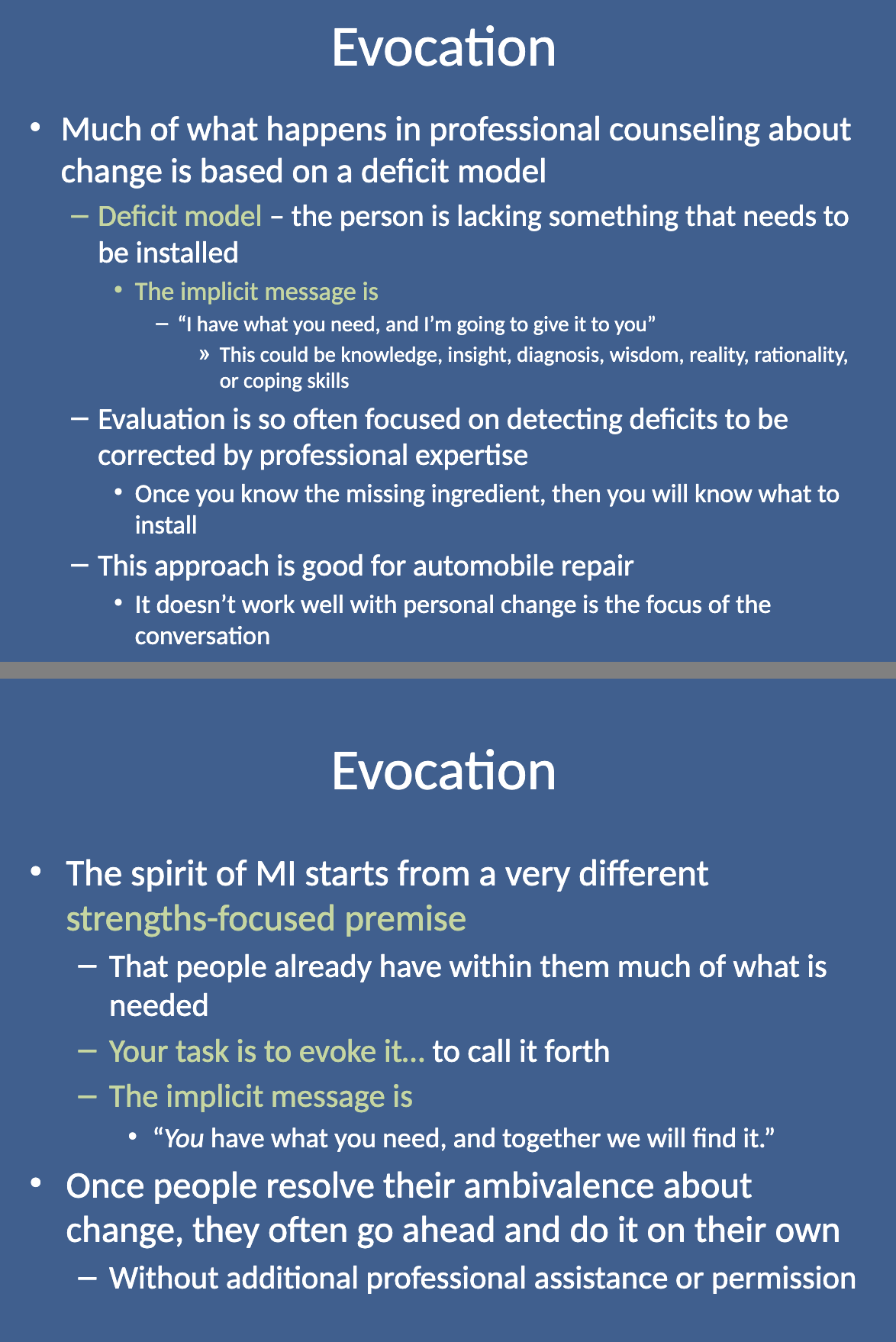
What is evaluation focused on in the Deficit Model? (Evocation)
In the Deficit Model, evaluation is focused on identifying the deficits or missing elements that need to be corrected or addressed through professional expertise.
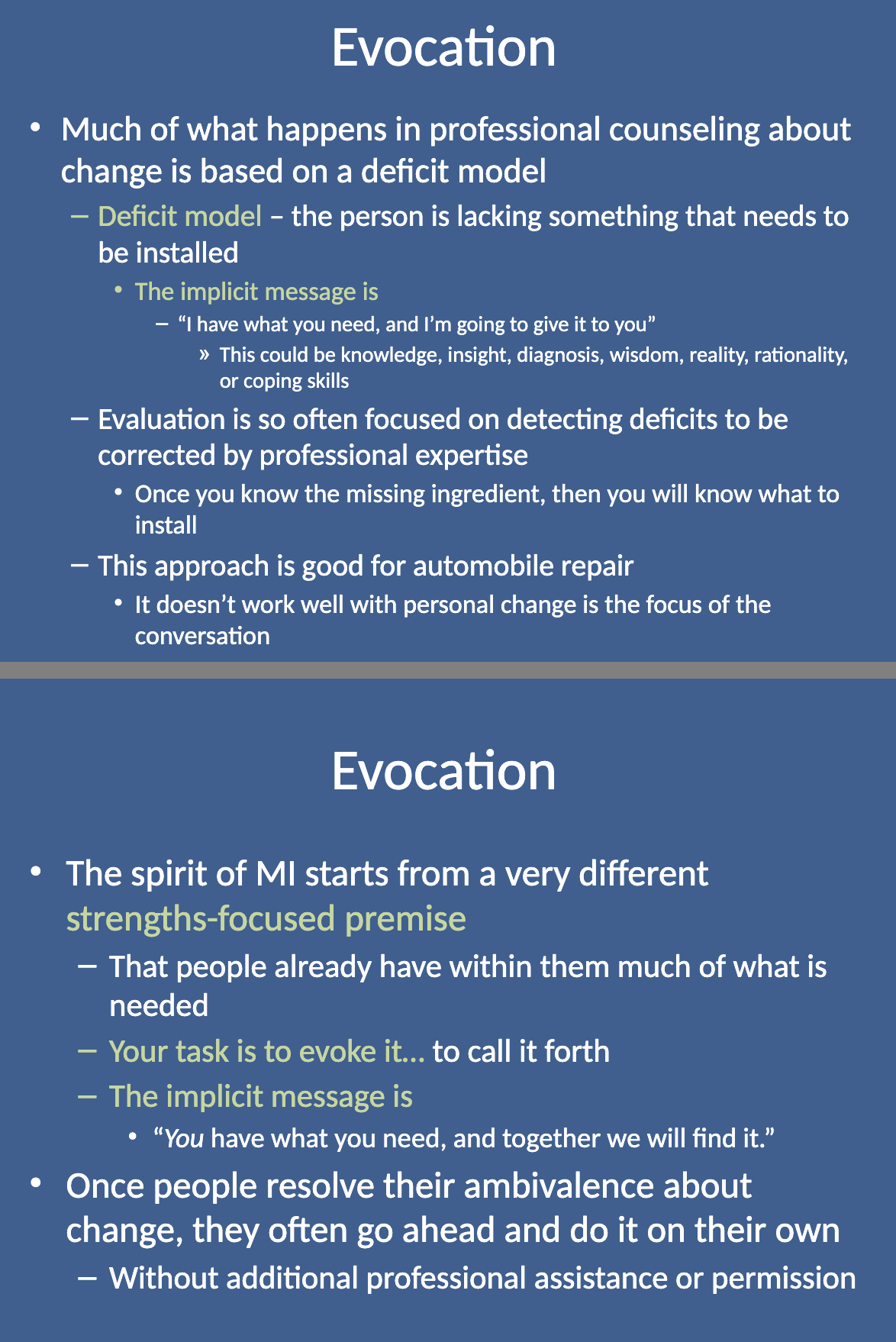
What is the Deficit Model good for? (Evocation)
The Deficit Model is effective for situations like automobile repair, where identifying and fixing something that is broken or missing is appropriate. However, it is less effective for facilitating personal change in counseling.
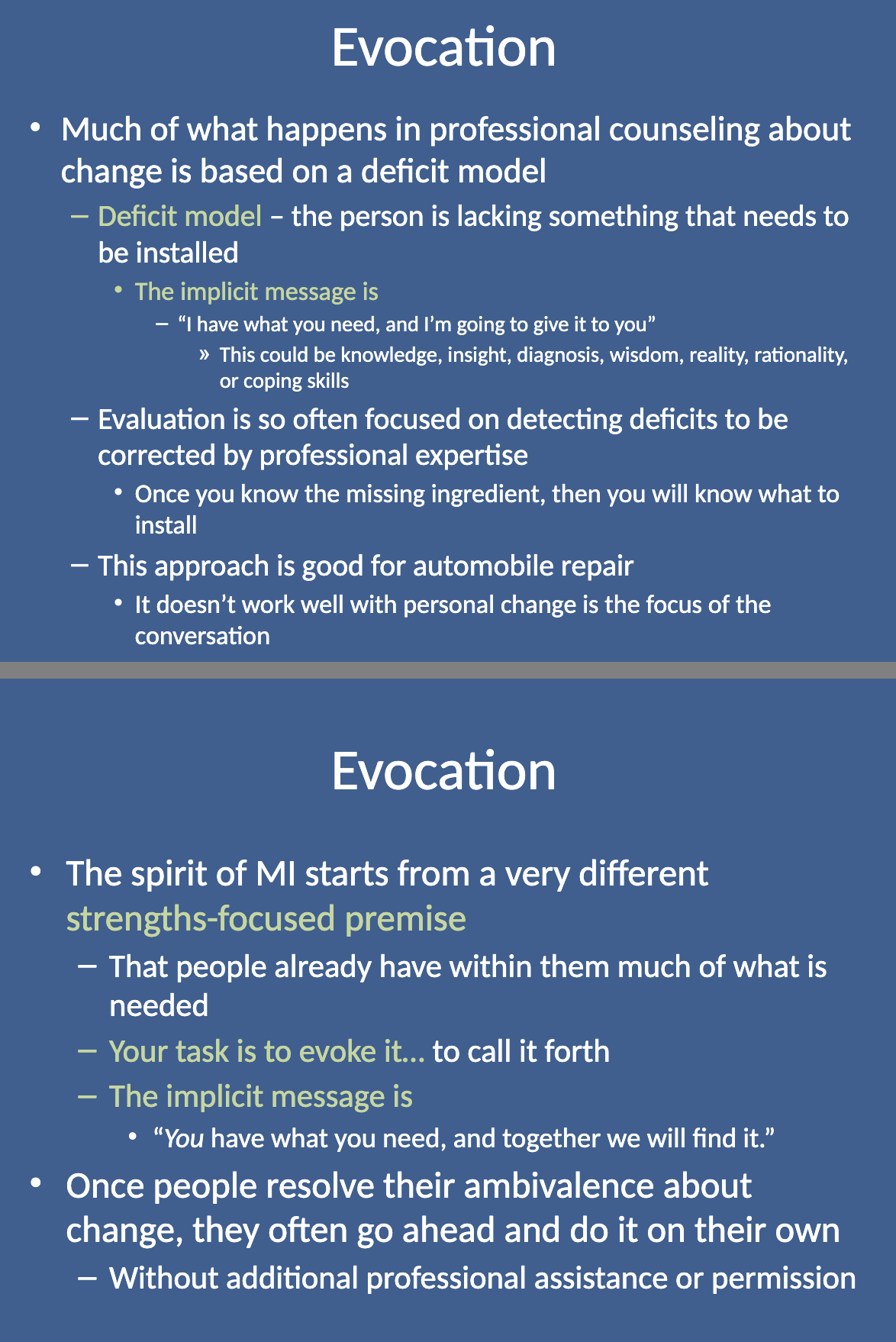
What does the spirit of MI start from, and what does this mean? (Evocation)
The spirit of MI starts from a strengths-focused premise, meaning that people already have within them much of what is needed for change. The task is to evoke these inner strengths and resources rather than impose external solutions.
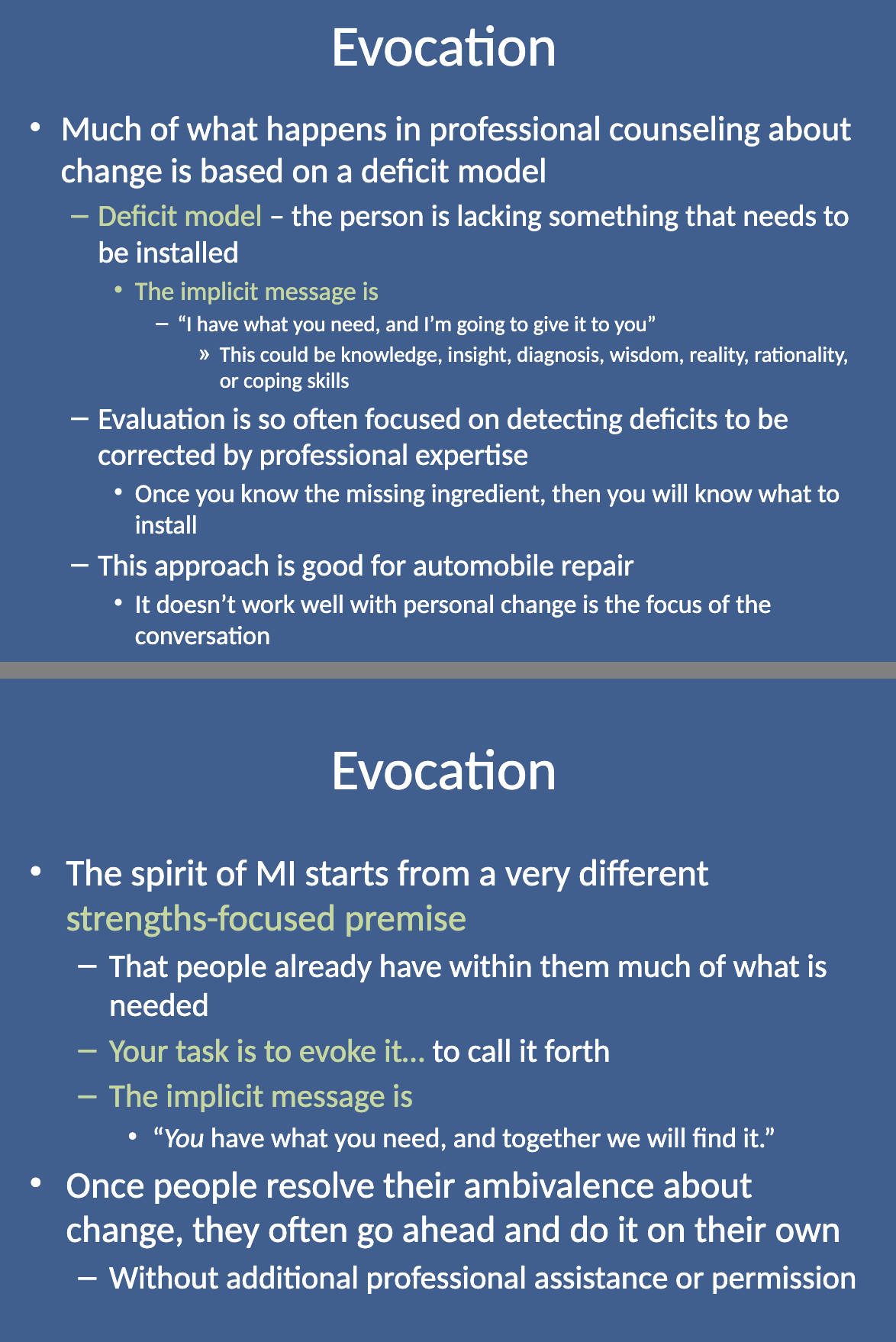
What is the task of the therapist in Motivational Interviewing? (Evocation)
The therapist’s task in MI is to evoke the person’s intrinsic motivation and resources. The implicit message is: “You have what you need, and together we will find it.”
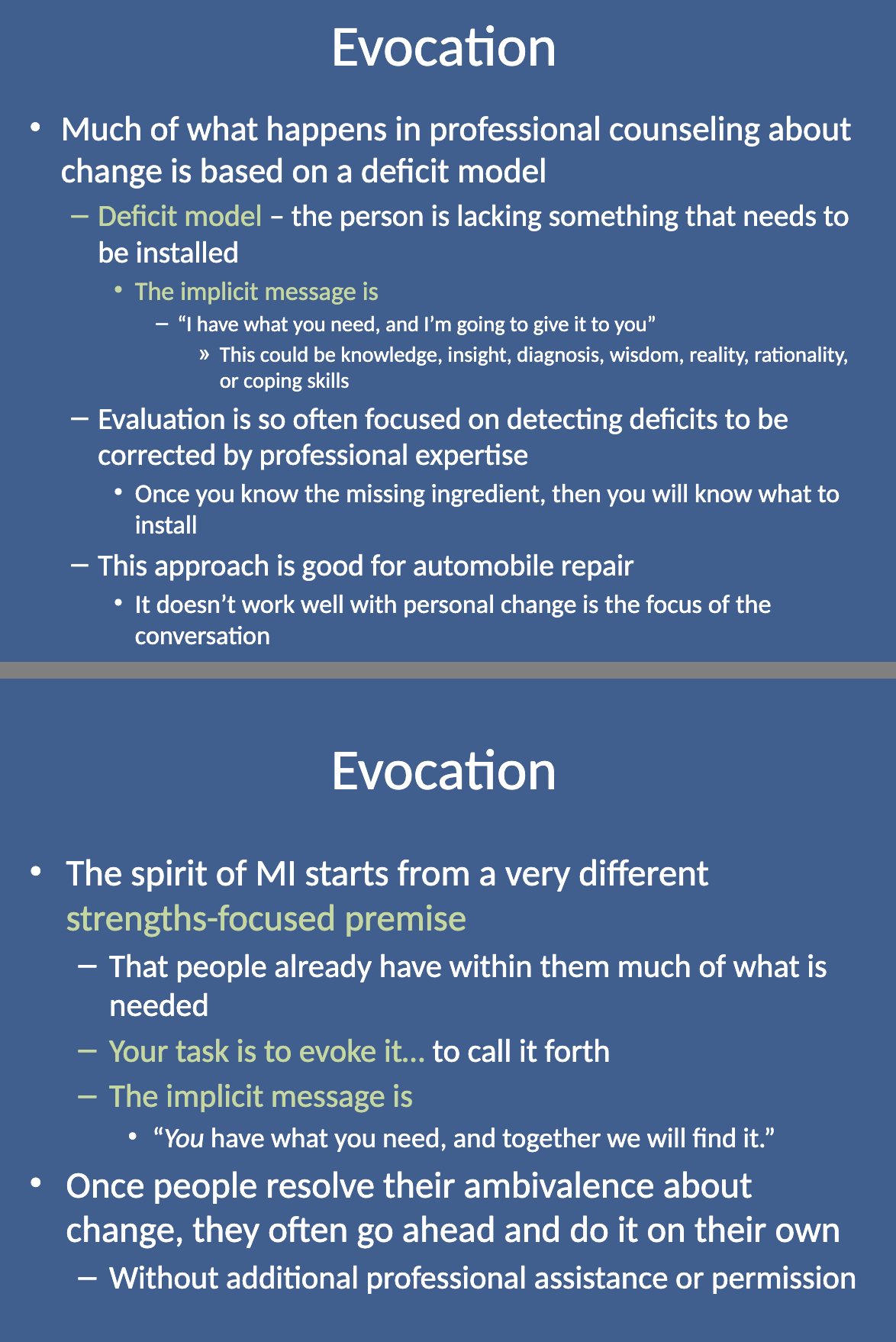
What is the first principle of person-centered care? (Some Principles of Person-Centered Care (Rogerian))
Our services exist to benefit the people we serve, not the other way around. The needs of the clients (patients, consumers, etc.) come first and have priority.
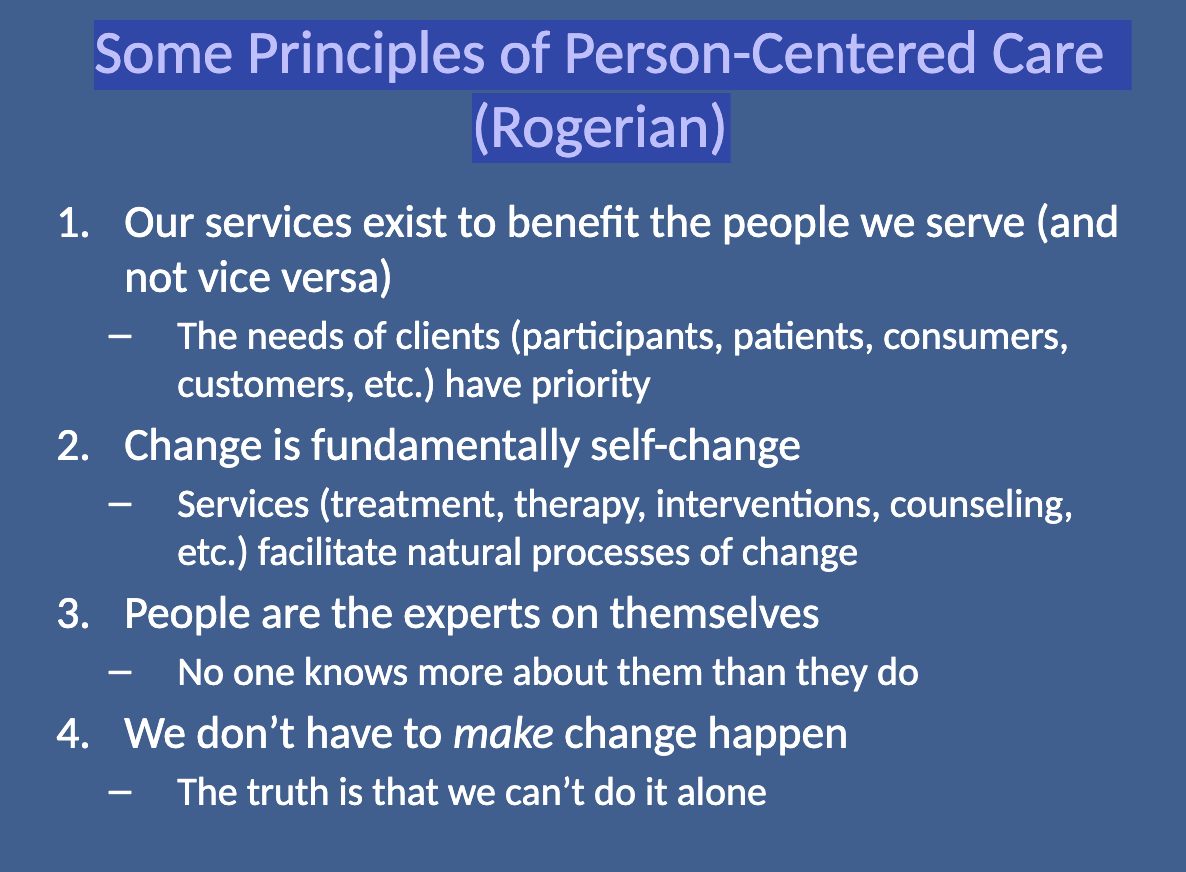
What is the second principle of person-centered care? (Some Principles of Person-Centered Care (Rogerian))
Change is fundamentally self-change. Services (such as therapy or counseling) facilitate natural processes of change but do not impose change from the outside.
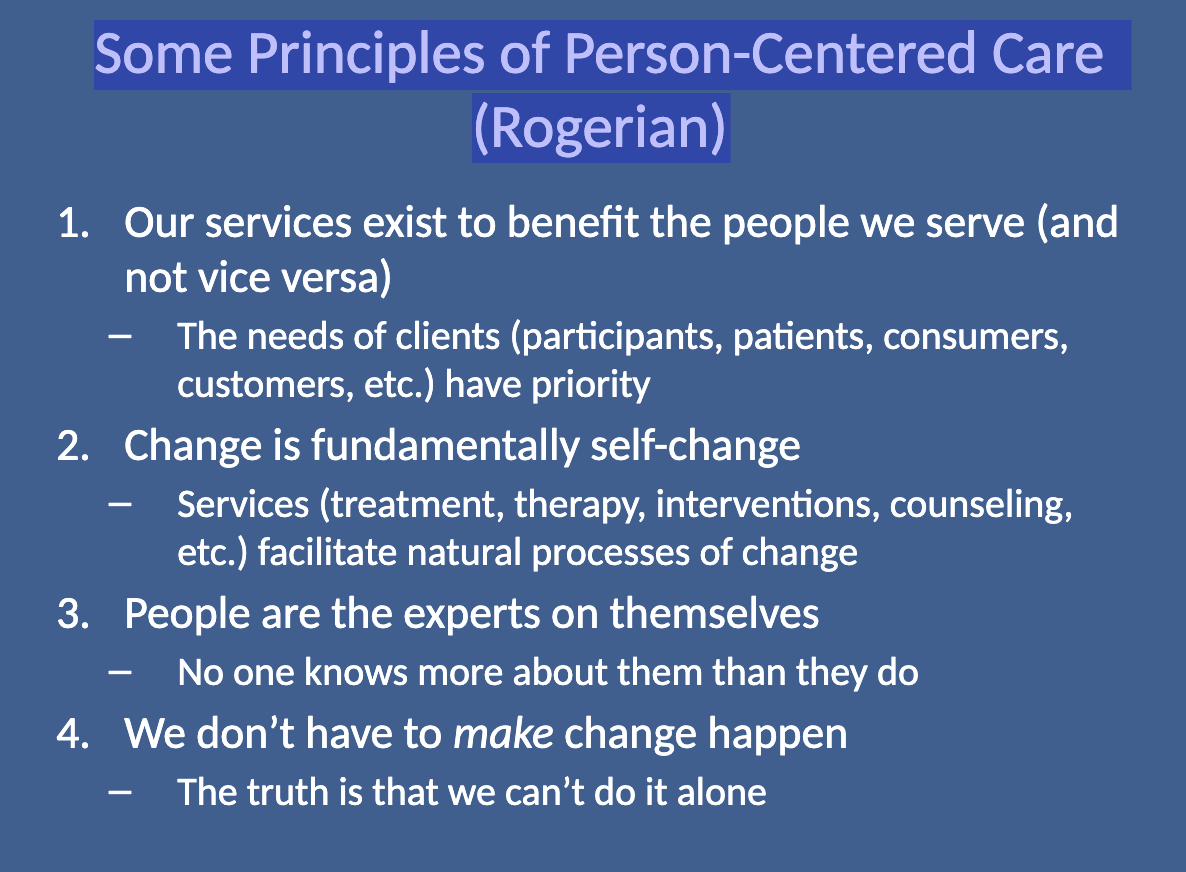
What is the third principle of person-centered care? (Some Principles of Person-Centered Care (Rogerian))
People are the experts on themselves. No one knows more about an individual’s life, experiences, or needs than the individual themselves.

What is the fourth principle of person-centered care? (Some Principles of Person-Centered Care (Rogerian))
We don’t have to make change happen. Change is not something we can force; it is a natural process, and we cannot do it alone.
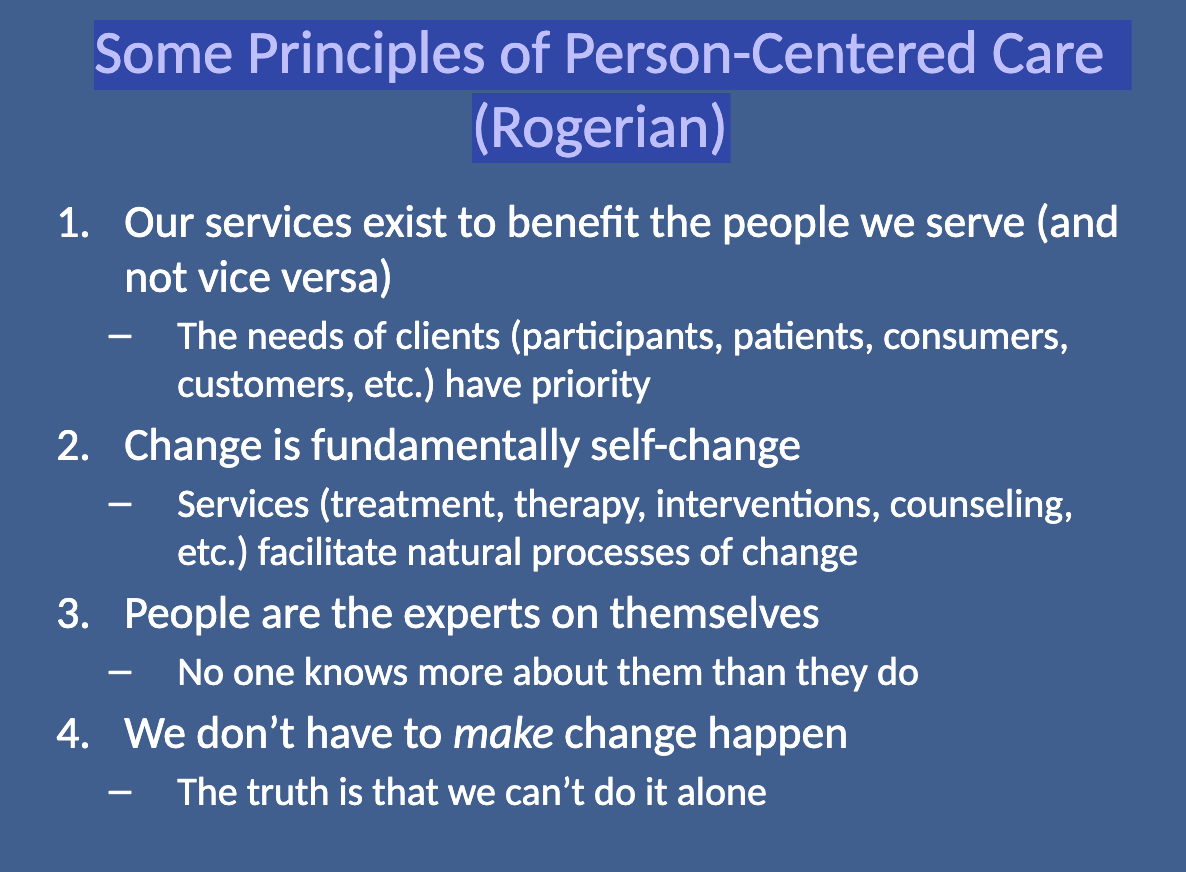
What is the fifth principle of person-centered care? (Some Principles of Person-Centered Care (Rogerian))
We don’t have to come up with all the good ideas. Often, the client’s own ideas are the best, and our role is to support them in discovering their own solutions.
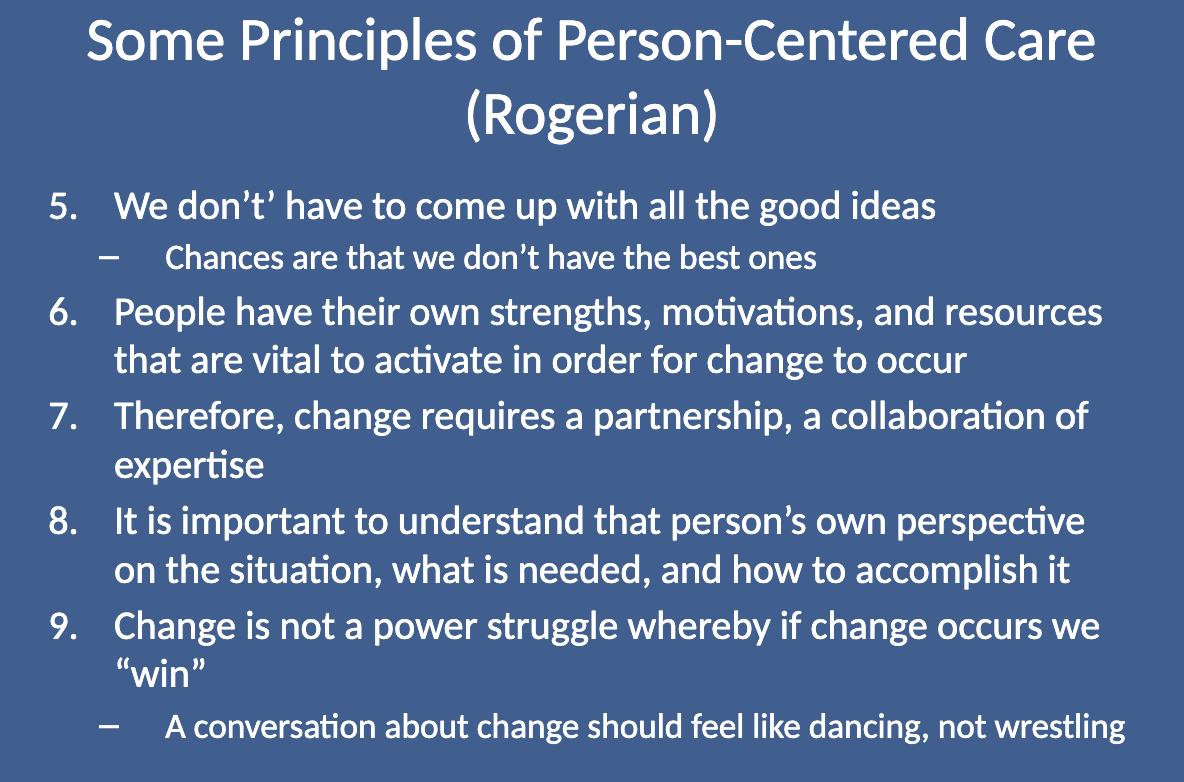
What is the sixth principle of person-centered care? (Some Principles of Person-Centered Care (Rogerian))
People have their own strengths, motivations, and resources that are vital to activate for change to occur. Our role is to help uncover and build on these strengths.
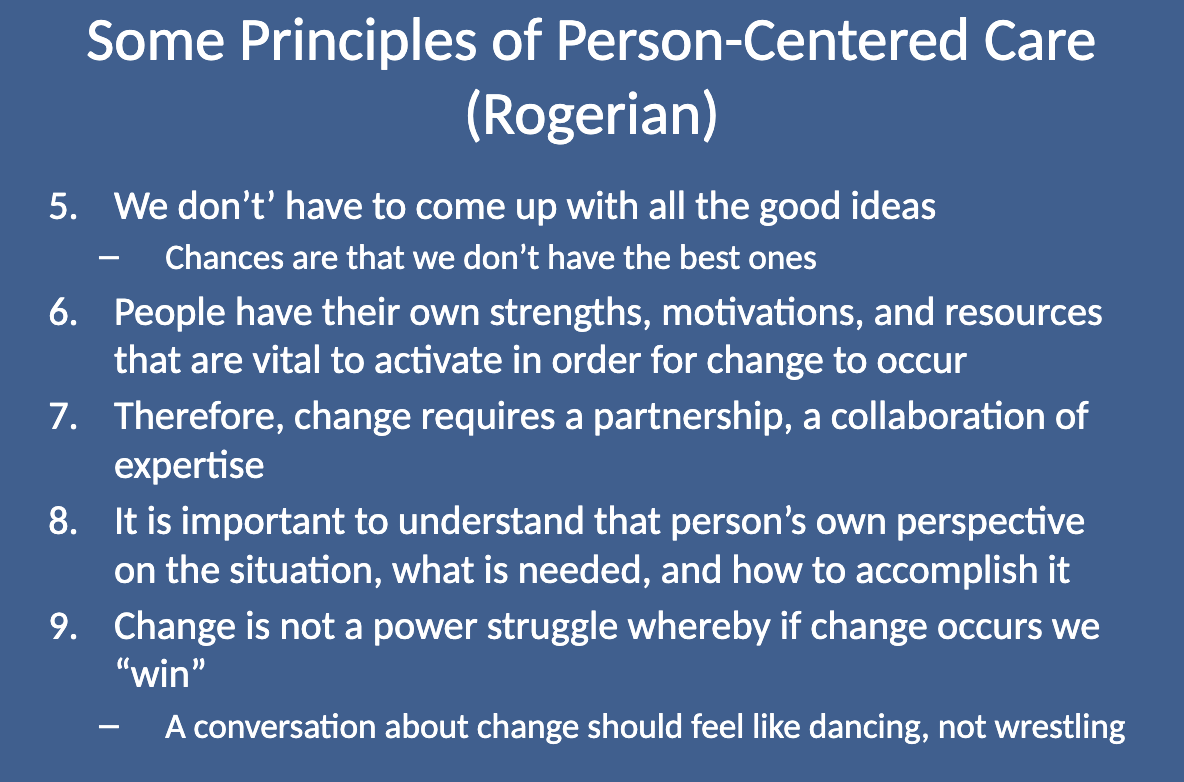
What is the seventh principle of person-centered care? (Some Principles of Person-Centered Care (Rogerian))
Change requires a partnership, a collaboration of expertise. Both the helper and the client bring expertise to the process, working together toward the goal of change.
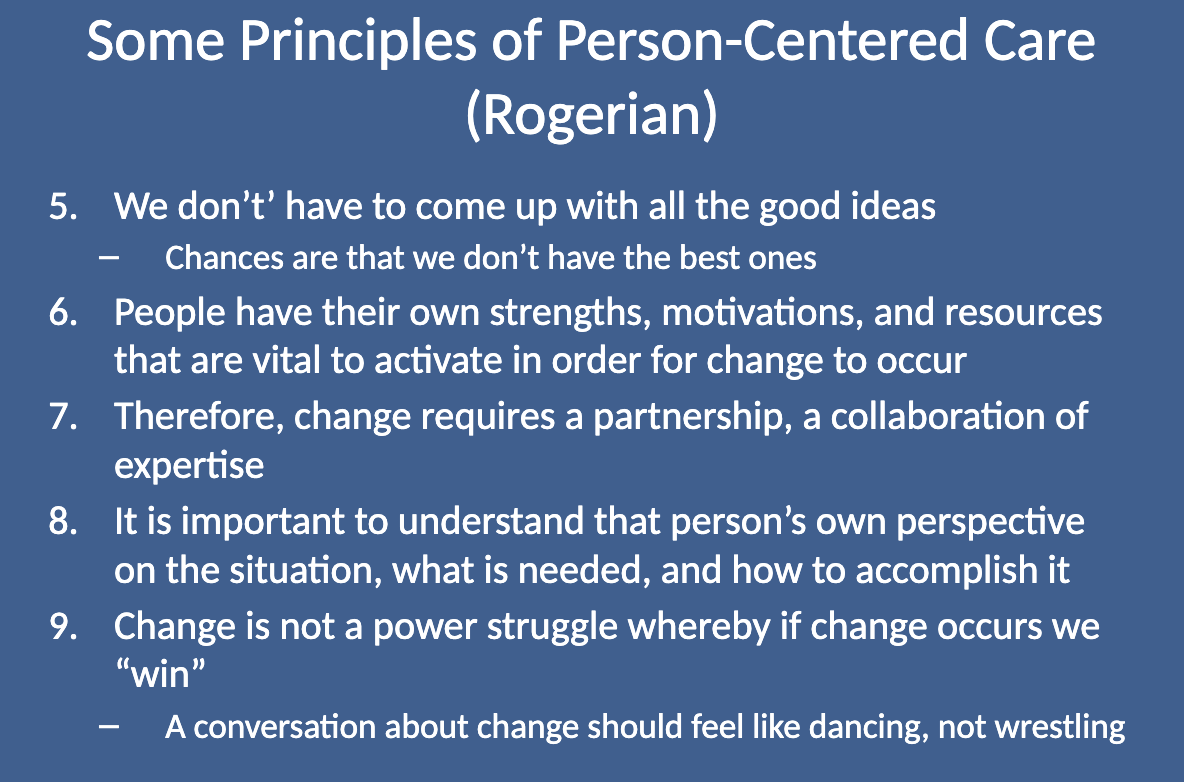
What is the eighth principle of person-centered care? (Some Principles of Person-Centered Care (Rogerian))
It is important to understand the person’s perspective on the situation, their needs, and how they believe change can be accomplished. The focus is on the person’s own vision.
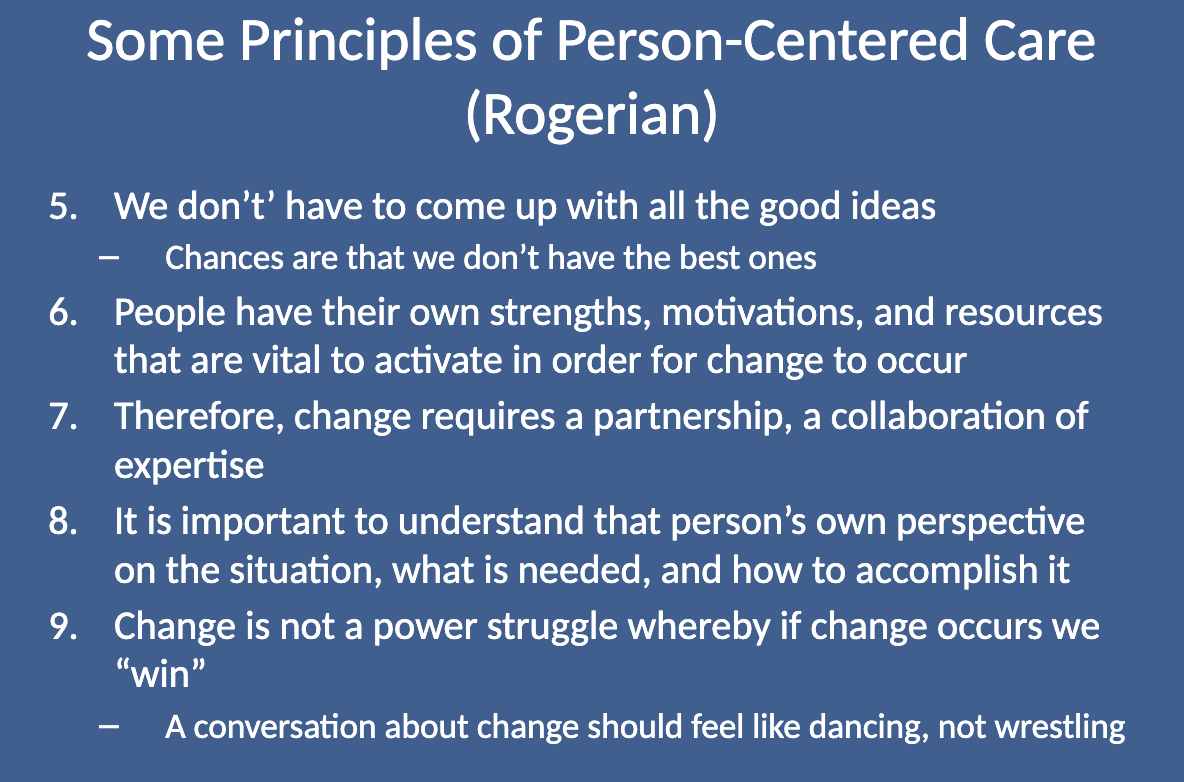
What is the ninth principle of person-centered care? (Some Principles of Person-Centered Care (Rogerian))
Change is not a power struggle. Conversations about change should feel like dancing, not wrestling. The goal is not to "win" but to collaborate and move toward change together.
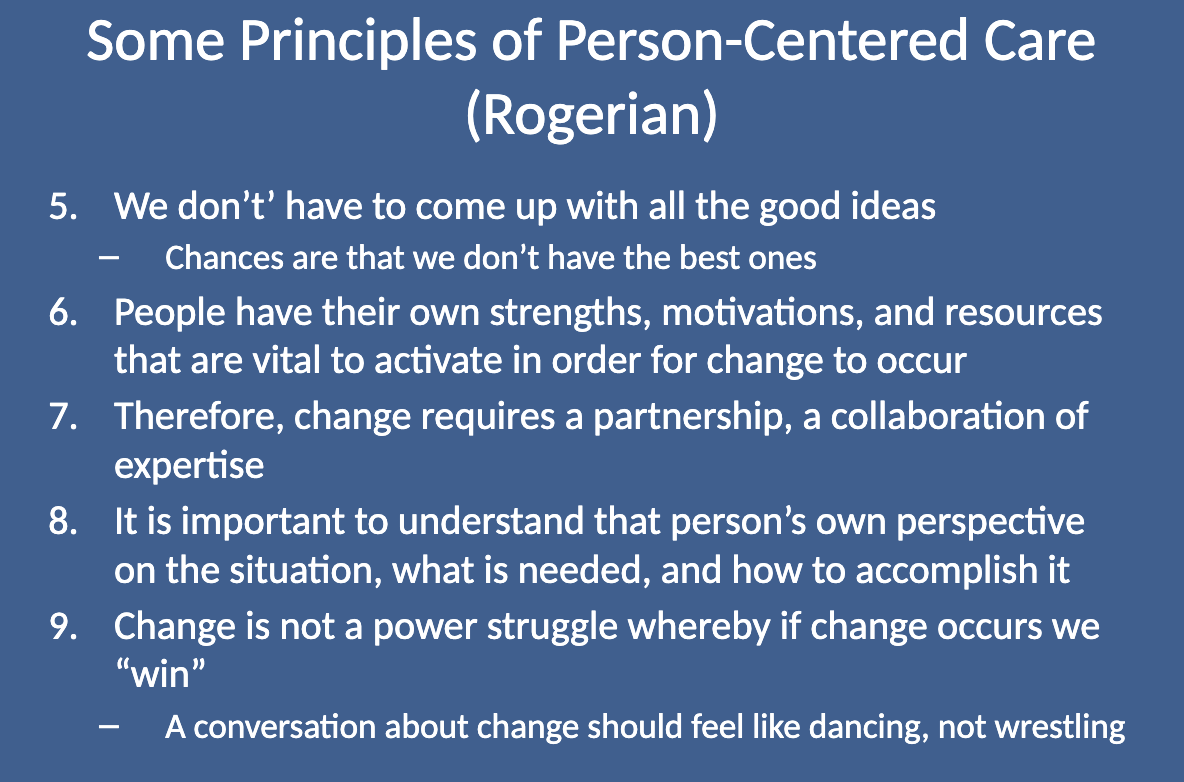
What is the tenth principle of person-centered care? (Some Principles of Person-Centered Care (Rogerian))
Motivation for change is not installed, but evoked. Motivation already exists within the person and just needs to be brought out or called forth.
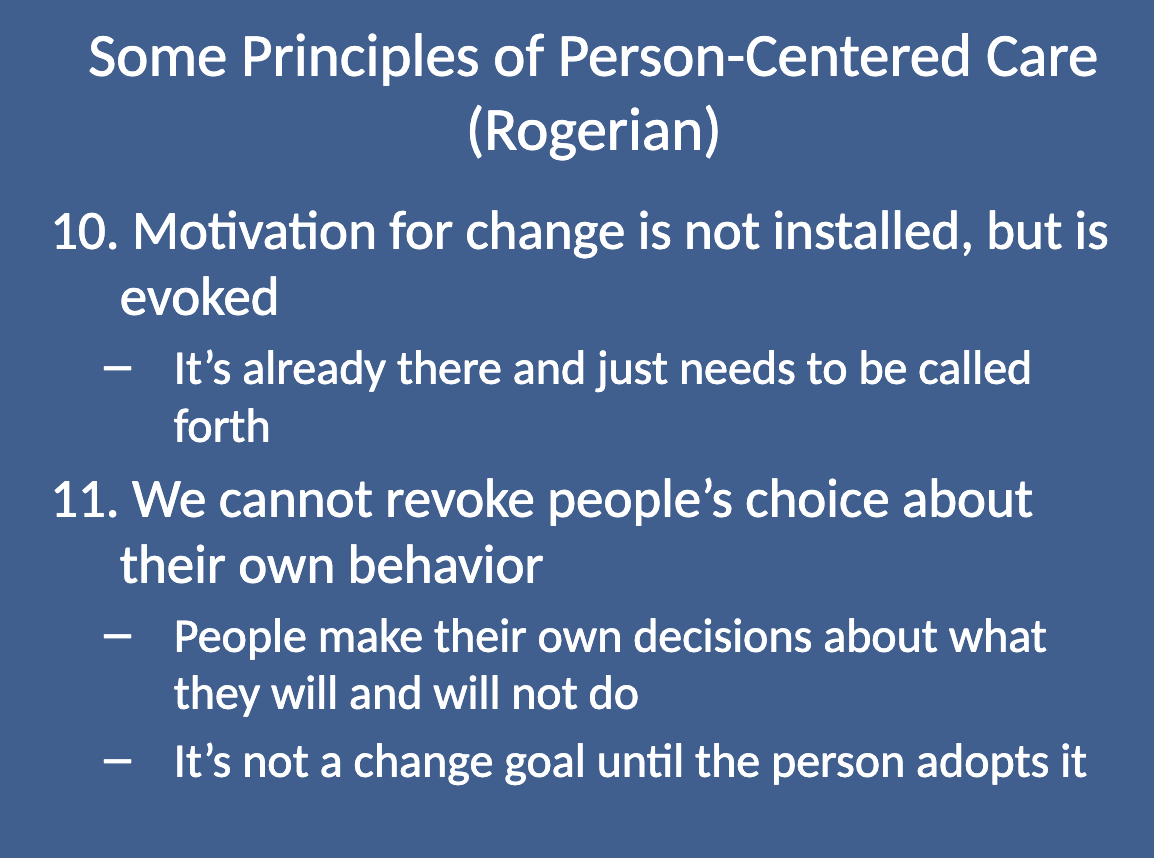
What is the eleventh principle of person-centered care? (Some Principles of Person-Centered Care (Rogerian))
We cannot revoke people’s choice about their own behavior. People make their own decisions about what they will or will not do. Change goals are not real until the person adopts them.
